Ronald.phillips
Shared posts
US Residential Solar Has to Be More Affordable If We're Going to Address Climate Change - CNET
The GPU Flood Is Here! Crypto Miners Dismantling Entire Systems, Selling Graphics Cards At Dirt Cheap Rates During Livestream Auctions

The recent crypto-mining GPU crash has prompted several Chinese miners to dismantle their entire systems and sell off large quantities of graphics cards during Livestream auctions.
Chinese Miners Forced To Sell Huge Quantities of Graphics Cards After Crypto GPU Mining Downfall
Chinese GPU miners and Ecafes were amongst some of the large-scale purchasers of graphics cards from AMD and NVIDIA. These graphics cards were used to mine Ethereum which offered lucrative profits to these operations during the crypto-craze but ever since the decline of BTC & ETH in the crypto market, these miners are now forced to sell the same graphics cards at cheap rates.
Pictures from such Ecafes and crypto operations can be seen online in various Chinese forums such as Baidu. Users are posting pictures of hundreds of graphics cards, which were previously running crypto mining, now sitting on floors and desks, waiting for users to buy them off. With the ever-dropping prices of graphics cards, these miners are now forced to sell their GPUs on various online auction sites and some have even resorted to livestreams on popular social sites.
Some of the most popular graphics cards such as the NVIDIA GeForce RTX 3060 Ti are now being sold for around $300-$350 US on reseller sites. The same graphics card was being sold for over $700-$800 US a few months ago. While these are dirt cheap rates compared to where we were a few months ago, these graphics cards have been abused in mining for over a year and we won't recommend getting these cards, even if they are being sold under MSRP. Despite our caution, we know that gamers would find these used graphics cards as great deals and still buy these overly used graphics cards. There are at least $15 Billion worth of GPUs sold in the mining segment alone since 2021.
The other thing is that with such a huge flood of GPUs entering the market right now, it means that NVIDIA and AMD will have a hard time selling off cards based on their existing GPU lineup and would take time to get rid of their excess inventory. Now how this affects gamers is that while they will be able to get cheap and used graphics cards, for now, we will have to wait a bit till the next generation of GPUs.
With that said, the Ethereum 'Proof of Stake' is expected in the second half of this year which means that GPUs will no longer be useful for mining purposes. This means that miners have a few months left to profit off of their GPUs but with the ever-decreasing crypto rate, it looks like miners are giving up on GPU mining and selling their cards to get as much they can get off them. It won't be much since these cards were bought at 2x or 3x their MSRP during the crypto craze but miners have already reaped the profits from the whole situation.
The post The GPU Flood Is Here! Crypto Miners Dismantling Entire Systems, Selling Graphics Cards At Dirt Cheap Rates During Livestream Auctions by Hassan Mujtaba appeared first on Wccftech.
Evan Rachel Wood Believes Westworld Predicted The Future
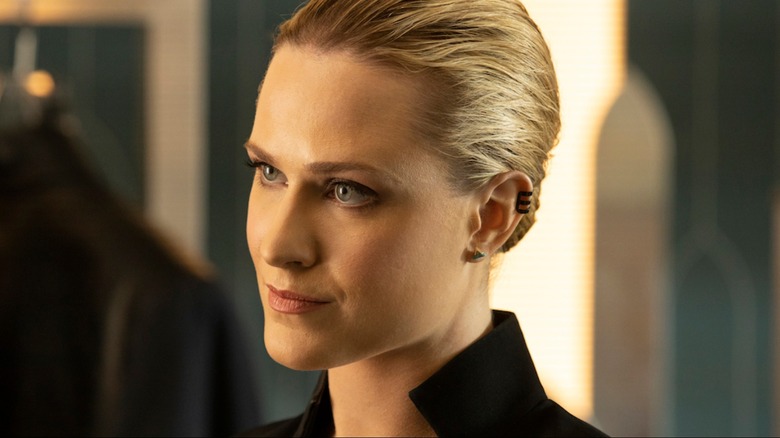
Jonathan Nolan and Lisa Roy's dystopian sci-fi series, "Westworld" has already had a three-season run, having been renewed for a fourth season set to premiere in a few days. "Westworld" has always been ambitious from the get-go, as the show dives into the perspective of "host" bodies, a module prevalent in first-person video game narratives.
The scope of "Westworld" is extremely wide, as it attempts to capture what our futures would look like in terms of technological advancements, infusing the narrative with a certain essence of timelessness and relevance like no other.
In a press conference attended by /Film ahead of the "Westworld" season 4 premiere, Evan Rachel Wood, who plays Dolores Abernathy in the show (along with many variations of her in many host bodies), spoke about the show's prescience and the reasons why we gravitate towards stories about artificial intelligence:
"It's the looming unknown. It's knowing that we must evolve and that technology is evolving at such a rapid rate now...I think it's that just existential dread of where are we going? What is the cautionary tale? What could go right? What could go wrong? Let's explore these ideas. And, maybe, hopefully, if you're like Jonah [Nolan] and Lisa, you're doing things. You have your pulse on the future and you're doing things and writing things that are, I swear to God, there to help us and teach us and warn us."
Having "your pulse on the future" does encapsulate what "Westworld" is all about, as the show delves into moral quandaries in relation to A.I. in an intelligent, profound manner.
Knowing Where We Are Headed
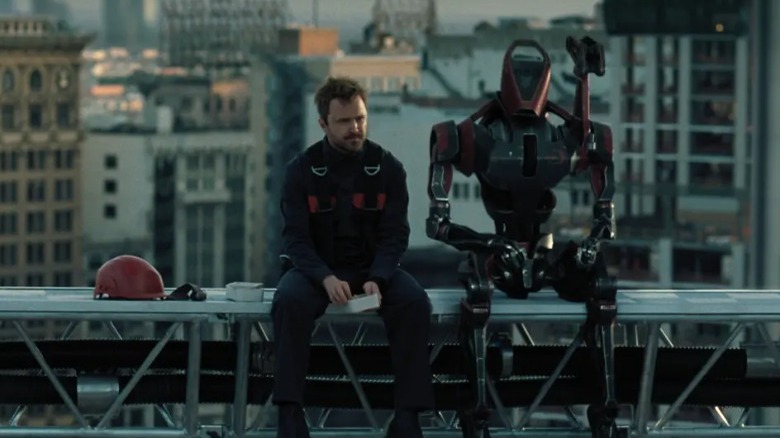
The narrative of the show begins in Westworld, which is a technologically-advanced Wild West-themed park in which android "hosts" reside. As the hosts are programmed to never harm humans, human guests can stay over at the park and do whatever they wish to these "hosts." A similar theme of A.I. subjugation and the notion of looking down on them as lesser sentient beings have been explored in depth in Quantic Dream's "Detroit: Become Human." Season 3 of "Westworld" widens the scope of the story drastically, as it branches into the real world, wherein many humans are controlled by a super-powerful A.I. named Rehoboam.
Rachel Wood told /Film about the show's ability to predict the future, in the sense that viewers can go back and watch the previous seasons and make sense of events within the context of the technological advancements unfurling today. The notion that A.I. singularity and ethics are a thing of the distant future is not necessarily true, and Rachel Wood speaks about this realization of being on the cusp of things, albeit unwittingly:
"If you go back and watch the first season, I think a lot of things that maybe didn't make as much sense then probably make a lot of sense now. And I think that will continue to be the case with this show. And the more you go back and watch it, or the more time has passed and you go back and revisit, you'll think, oh wow. Wow. They really knew where we were headed. And we thought we were so far away from this. And we actually were right on top of it."
Season 4 of "Westworld" will premiere on June 26, 2022, on HBO.
Read this next: The 14 Best Sci-Fi Shows On Amazon Prime
The post Evan Rachel Wood Believes Westworld Predicted the Future appeared first on /Film.
Someone animated Star Trek: Voyager and it rocks

As a franchise, I feel like no series has evolved as much as Star Trek. Even though the show's core premise hasn't changed, the settings, characters, and presentation have altered with the eras without causing the show to lose its appeal. — Read the rest
Elon Musk's adult daughter is transgender and wants nothing to do with him

I wonder what it is about notorious edgelord Elon Musk that led his transgender daughter to emancipate herself from him upon reaching 18 years old? The BBC reports that she filed paperwork in April to change her legal name and gender. — Read the rest
Securing your IoT with Edge Secured-core devices
A recent study conducted by Microsoft in partnership with Ponemon Institute included a survey of companies that have adopted IoT solutions and 65 percent of them mentioned that security is a top priority when implementing IoT. Attacks targeting IoT devices put businesses at risk. Impacted devices can be bricked, held for ransom, employed as launch points for further network attacks, or used for malicious purposes. Among many consequences, we often see intellectual property (IP) and data theft and compromised regulatory status, all of which can have brand and financial implications on the business.
Subsequently, we did a survey to understand the top concerns around the security of IoT devices, and we shared the findings in a previous blog about best practices for managing IoT security concerns. The following list summarizes the top security concerns from companies that have adopted IoT solutions:
- Ensuring data privacy (46 percent).
- Ensuring network-level security (40 percent).
- Security endpoints for each IoT device (39 percent).
- Tracking and managing each IoT device (36 percent).
- Making sure all existing software is updated (35 percent).
- Updating firmware and other software on devices (34 percent).
- Performing hardware/software tests and device evaluation (34 percent).
- Updating encryption protocols (34 percent).
- Conducting comprehensive training programs for employees involved in IoT environment (33 percent).
- Securely provisioning devices (33 percent).
- Shifting from device-level to identity-level control (29 percent).
- Changing default passwords and credentials (29 percent).
To help address these concerns, Microsoft is thrilled to announce today the general availability of the extension of our Secured-core platform to IoT devices along with new Edge Secured-core certified devices from our partners Aaeon, Asus, Lenovo and Intel in the Azure certified device catalog. We have added this new device certification for our Edge Secured-core platform so customers can more easily select IoT devices that meet this advanced security designation.
As outlined in Microsoft’s Zero Trust paper, a key investment, especially around new devices, is to choose devices with built-in security. Devices built with Azure Sphere benefit from industry-leading built-in security, with servicing by Microsoft.
Announcements for Edge Secured-core
Edge Secured-core is a certification in the Azure Certified Device program for IoT devices. Devices that have achieved this certification provide enterprises the confidence that the devices they’re purchasing deliver the following security benefits:
- Hardware-based device identity: In addition to the various security properties that a hardware-based device identity provides, this also enables the use of the hardware-backed identity when connecting to Azure IoT Hub and using the IoT Hub device provisioning service.
- Capable of enforcing system integrity: Using a combination of processor, firmware, and OS support to facilitate measurement of system integrity to help ensure the device works well with Microsoft Azure Attestation.
- Stays up-to-date and is remotely manageable: Receives the necessary device updates for a period of at least 60 months from the date of submission.
- Provides data-at-rest encryption: The device provides built-in support for encrypting the data at rest using up-to-date protocols and algorithms.
- Provides data-in-transit encryption: IoT devices such as gateways, which are often used to connect downstream devices to the cloud, need inherent support for protecting data in transit. Edge Secured-core devices help support up-to-date protocols and algorithms that are used for data-in-transit encryption.
- Built-in security agent and hardening: Edge Secured-core devices are hardened to help reduce the attack surface and include a built-in security agent to help secure from threats.
In addition to addressing many of the top concerns that we’ve heard from customers around the security of their IoT devices, our data shows that Secured-core PCs are 60 percent more resilient to malware than PCs that don’t meet the Secured-core specifications. We’ve brought the learnings from Secured-core PCs to define the requirements for Edge secured-core devices.
Today, we’re excited to announce the availability of Windows IoT Edge Secured-core devices available in the Azure Certified Device catalog.




Additionally, Microsoft invests with semiconductor partners to build IoT-connected industry-certified MCU security platforms that align with Microsoft’s security standards.
Get started with Microsoft Security
Email us to request a call for more information about Azure Sphere, Edge Secured-core devices, or industry-certified devices. Learn more about Azure IoT security.
To learn more about Microsoft Security solutions, visit our website. Bookmark the Security blog to keep up with our expert coverage on security matters. Also, follow us at @MSFTSecurity for the latest news and updates on cybersecurity.
The post Securing your IoT with Edge Secured-core devices appeared first on Microsoft Security Blog.
New NTLM Relay Attack Lets Attackers Take Control Over Windows Domain
Danny DeVito's Taxi Audition Could Have Ended In Disaster
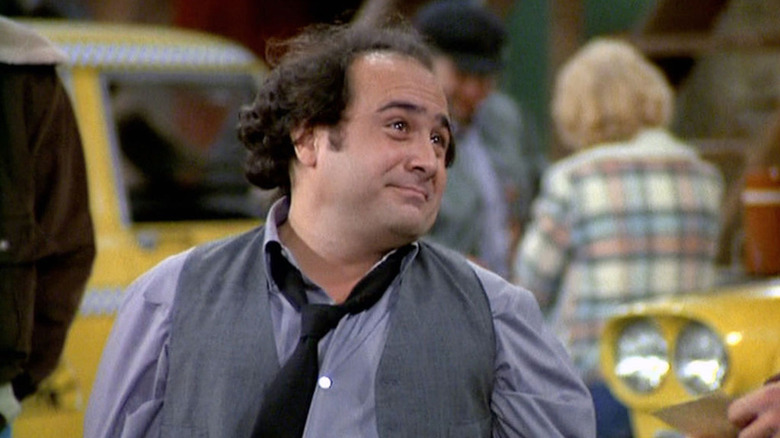
Often when an actor is up for a part that could launch their career they're a bundle of nerves. They might believe with every fiber of their being that they're the only person who can nail the role, but that confidence can vanish in an instant with the wrong look or word from the casting director. It's a high-wire act, and you dare not set out on the wrong foot. This is the time to be the best version of yourself -- it isn't a time to take risks.
Unless, of course, you're Danny DeVito, in which case you walk straight into the audition room and insult the writers.
When Television Was Considered Second-Tier Entertainment
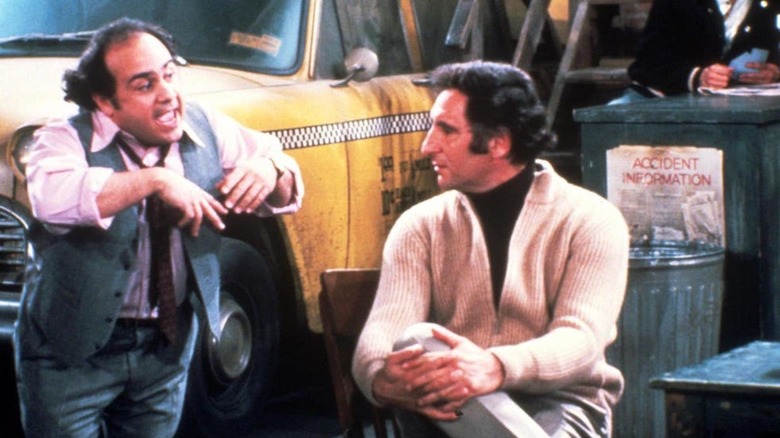
When Danny DeVito read for the role of brusque "Taxi" dispatcher Louie De Palma, he was known for his performance as the schizophrenic Martini in Miloš Forman's "One Flew Over the Cuckoo's Nest," and not much else. Though DeVito's colleagues were leery of doing television at the time, he fell hard for De Palma when he read the pilot. With casting director Joel Thurm urging him to go hard for the part, DeVito went into the audition determined to make an impression.
In an interview with Andrew Goldman for Los Angeles Magazine, Devito recalls, "I went to Paramount to audition, and there were Ed Weinberger, Stan Daniels, Dave Davis, and Jim Brooks, all from 'Mary Tyler Moore' [sic]." In the late 1970s, there were no bigger names in television comedy writing. DeVito, however, was not a television guy; he'd never even watched an episode of "The Mary Tyler Moore Show." "I might not have had a television," he says.
Tact Is Overrated
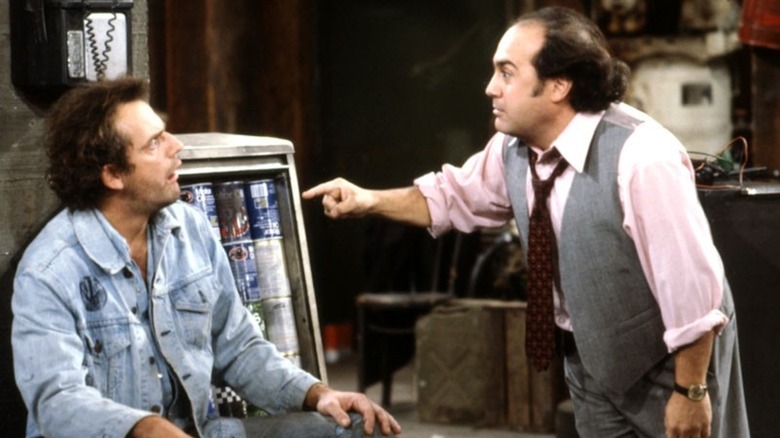
Nevertheless, Danny DeVito knew that the writing was stellar and that he dearly wanted the role -- so he took a risk. "Everybody was sitting down," he says. "It was a scary moment. I had the script in hand and I said to them, 'Nice to meet you. One thing I want to know before we start: Who wrote this s***?' And I threw it on the table."
How'd that play to a roomful of Emmy winners? "There was a one-second pause," says DeVito. "Then Jim Brooks almost died laughing. Basically, it was one of those things where Louie actually walked into their office. From then on, I could say any word I wanted and get a laugh. If I said, 'And?' I'd get a laugh. Anything!"
"Taxi" premiered on ABC in 1978 to rave reviews. DeVito received his first Emmy nomination for Outstanding Supporting Actor in a Comedy Series in 1979 and won the award in 1981. Not bad for a piece of s*** show.
Read this next: The 14 Greatest '80s Romantic Comedies Ranked
The post Danny DeVito's Taxi Audition Could Have Ended In Disaster appeared first on /Film.
Taylor Sheridan's Latest Yellowstone Spin-Off 1932 Switches Digits, Is Now Titled 1923
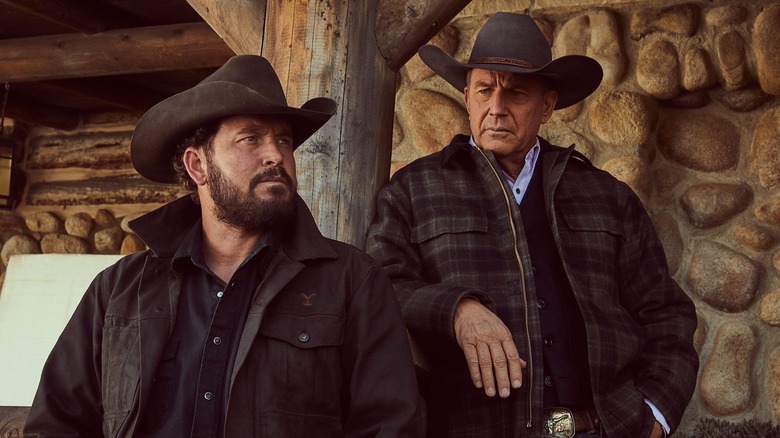
One of the crazier success stories in all of TV and film is just how Taylor Sheridan's "Yellowstone" has set the small screen on fire. This series is like crack for dads and grandparents and it's quickly becoming the Boomer MCU as we get more and more spin-off series surrounding the Kevin Costner-starring "Yellowstone." We've already had "1883," which starred Tim McGraw, Sam Elliott, and Faith Hill and now we're getting a show based on yet another generation of Duttons, this time set in the early 1920s and starring Harrison Ford and Dame Helen Mirren.
The Ford/Mirren spin-off series was originally announced as "1932," and for reasons unknown, the powers that be have decided to bump up that date a little bit, so now the show is titled "1923." This is a period of time that was particularly hard for Montana farmers as they battled drought, prohibition, and an early canary in the coal mine economic depression that would foreshadow the nationwide depression that would hit a decade later.
Expect A Detour To 1918 As Well
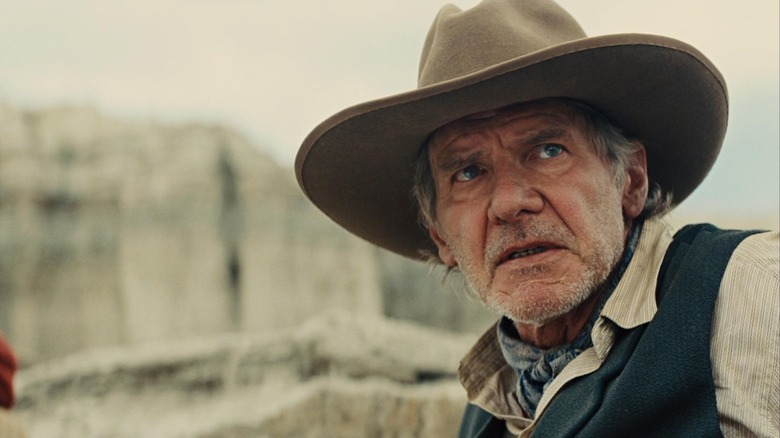
Variety's story on the matter claims that "1923" will also dip into the 1910s to deal with how the Duttons were impacted by the end of WWI. I can't claim to be the most knowledgeable about this particular show, but even for a non-fan like me the casting of Ford and Mirren instantly makes me want to check out "1923" when it debuts on Paramount+ this December.
Yes, the last time Ford put on a cowboy hat it was ... questionable at best (lookin' at you, "Cowboys & Aliens"), but anytime Ford is invested in the material, I'm interested in seeing that performance. He's still one of our living legends, and when he gives a crap there's no one more engaging on the screen.
I'm especially curious to see Ford and Mirren together again, this time roughing it through the 1920s. They previously starred in the regrettably overlooked and underseen "The Mosquito Coast" back in 1986. That movie also brought River Phoenix and Harrison Ford together years before Phoenix's turn as Young Indy in "Indiana Jones and the Last Crusade." If you haven't seen it, seek it out. It's one of Ford's favorite performances of his and it's a wonderful, quasi-forgotten drama.
And don't expect the "Yellowstone" train to stop anytime soon. Season 4's debut reportedly drew 11 million viewers. Like I said, Boomer MCU going strong.
Read this next: Every Ridley Scott Movie Ranked From Worst To Best
The post Taylor Sheridan's Latest Yellowstone Spin-Off 1932 Switches Digits, is Now Titled 1923 appeared first on /Film.
Broken Arrow open-carry incident raises law enforcement questions: was anyone hugged with nuclear arms? [Unlikely]
Only Murders In The Building Season 2 Review: A Bigger, Funnier, More Ambitious Sophomore Season
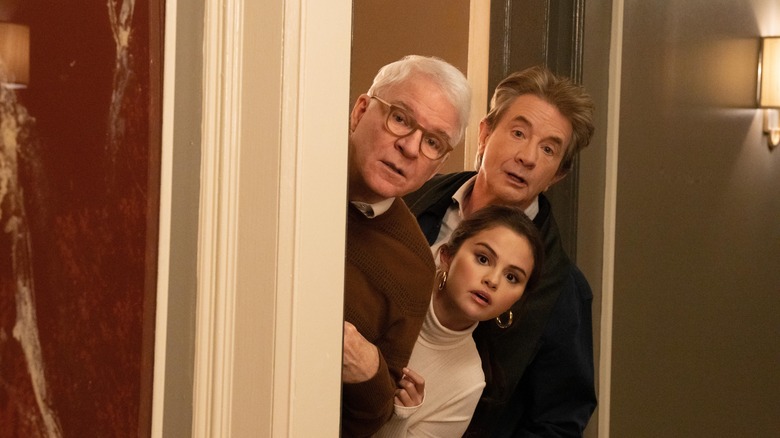
Sophomore seasons are tricky things. If a show (be it in TV or podcast form) was lucky and good enough to hook you with its first season, there's always the risk of diminishing returns to consider. What was fresh can seem stale. It's a fact of life that applies to things beyond entertainment. After all, sooner or later, that new car smell fades. So I'll confess that up until the cliffhanger finale, I thought "Only Murders in the Building" was going to be a one-and-done series, and I was perfectly fine with that. It wasn't that I didn't want the show to return; it was because everything felt so perfectly wrapped up, and to extend things into a second season would be courting disaster. The central mystery was solved, and solved well. On top of that, it felt kind of silly to have yet another murder mystery happen in the same location.
But silliness is baked into "Only Murders in the Building," and a second season is here, taking us back inside the Arconia, a sprawling apartment building on the Upper West Side. And as it turns out, I need not have worried — "Only Murders in the Building," created by Steve Martin and John Hoffman, manages to avoid any trace of a sophomore slump (although there are plenty of meta jokes about how second seasons can often disappoint). For season 2, the show has become bigger, funnier, even stranger. This is a more ambitious season, jumping around in time and introducing new mysteries, new characters, and new revelations about our leads: washed-up actor Charles-Haden Savage (Steve Martin), over-the-top Broadway director Oliver Putnam (Martin Short), and the sardonic, secretive Mabel Mora (Selena Gomez), who pals around with the two men old enough to be her grandfathers. The three of them have been joined together by their love of true crime podcasts — a love that inspired them to launch a podcast of their own. As clumsy as that podcast may have been, it became popular enough to earn Charles, Oliver, and Mabel a devoted fan base — which includes a local detective (Da'Vine Joy Randolph), who is sympathetic to the three amateur sleuths (while also growing occasionally annoyed at their tomfoolery).
After the successful conclusion to season 1's mystery, Charles, Oliver, and Mabel were presented with a brand new case — one that ended up landing them in jail. Bunny (Jayne Houdyshell), the cantankerous board president of the Arconia, was murdered — and Mabel was found over the dead woman's body, drenched in blood. Did Mabel kill Bunny? She doesn't think so (her memories are conveniently fuzzy to make the mystery extra ... mysterious).
But if Mabel is innocent, that means there's a murderer lurking around the Arconia (again). Can our three hero podcasters crack the case and clear their names? Will Charles' self-loathing resurface in new ways? Will Oliver eat lots and lots of dip? Will Mabel overcome her haunted past? Will you laugh your ass off watching all of this? I can't answer all of these questions without giving away spoilers, but I can confirm the "laugh your ass off" part is accurate. Simply put, I love this show.
More Characters, More Mysteries, More Comedy
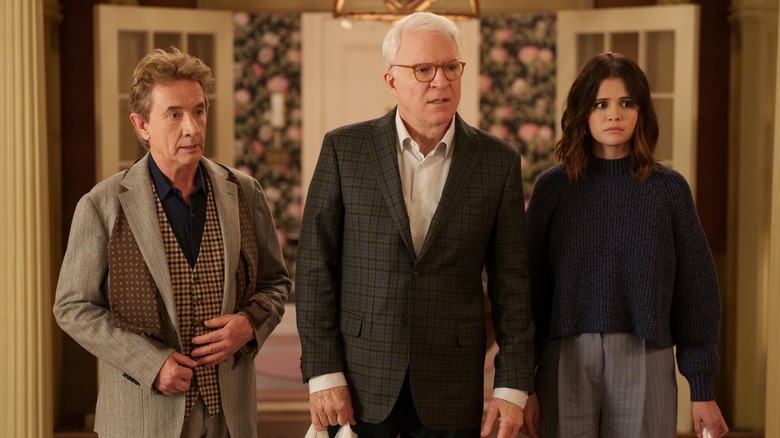
Memory and perception are a big theme of the season, and that requires the storyline to frequently shift perspective — and place. We not only learn more about our characters and their youths (or in Mabel's case, childhood), we also learn more about the imposing Arconia building itself, which seems to be literally overflowing with mysteries, like an apartment-sized replica of the murder mansion from "Clue."
The secret to the success of "Only Murders in the Building," beyond its likable three leads and the zany chemistry they have together, is in how the series juggles tone. It's both consistently funny and compellingly mysterious. Yes, the show satirizes true crime obsessions — but the writers are also skilled at crafting the type of mysteries that get us hooked. The best parodies are those created from a place of love; it's only when we truly love something that we are free to mock it (good-naturedly). For its second season, "Only Murders" cranks up the comedy and the mystery. The jokes come fast and furious, while the characters stumble into one shocking twist after another. Nearly every episode ends on a cliffhanger, and while that's manipulative and kind of cheap, it works. We can't help but get caught up in it all.
This season adds new players — who are, by default, new suspects — to the growing cast. Cara Delevingne is likable as an artist who grows close to Mabel. Amy Schumer pops up as a delightfully unhinged version of herself. And living legend Shirley MacLaine even stops by, and while her role is small, she's downright hilarious; MacLaine may be 88 now, but she hasn't lost her touch.
But it's the three leads that keep us hooked; that have us on the edge of our seats with concern (until we fall back, laughing at some absurdity that suddenly crops up). While I continue to think Gomez's character is the least interesting member of the trio (only slightly, mind you), she still works wonderfully with her co-leads. And Martin and Short, who have been doing this for a long time, remain seasoned, skilled pros. The two of them play off each other amazingly, and there are a wealth of scenes involving the two of them that had me trying to catch my breath from laughing so hard (Short is particularly great this season, really leaning into Oliver's inherent ridiculousness). As long as Martin, Short, and Gomez want to play these parts, I'll keep coming back to the Arconia, and I know I'm not alone. The first season of "Only Murders in the Building" felt like a nice surprise, coming from seemingly nowhere and giving us great characters, great mysteries, and great coats (yes, the fashionable outerwear is back for season 2). Season 2 shows us that the first season wasn't all a fluke.
"Only Murders in the Building" season 2 premieres on Hulu on June 28, 2022.
Read this next: The 19 Greatest Movie Couples Of All Time Ranked
The post Only Murders in the Building Season 2 Review: A Bigger, Funnier, More Ambitious Sophomore Season appeared first on /Film.
The 10 Greatest Jaws Moments
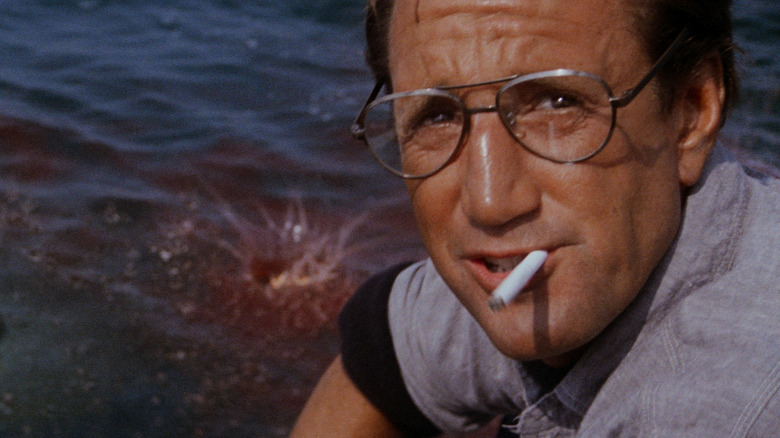
Happy unofficial "Jaws" Day. There's already a "Star Wars" Day ("May the Fourth be with you," as the pun goes), and in recent years, celebrating "Alien" Day has become an annual event as well. Since those two franchises have got April and May staked out, let's just pretend that Steven Spielberg's "Jaws," the original '70s summer blockbuster, has its own commemorative day, recognized the world over.
The Great White Blockbuster that is "Jaws" first swam into theaters on June 20, 1975, so today actually is its birthday, and it's getting closer to turning the big 5-0. Though it might leave this three-day weekend feeling like a perfect storm of holidays (with yesterday being Juneteenth and Father's Day, also), we thought we'd mark the anniversary of "Jaws" this year by taking a look back at the 10 greatest moments from the film that made beachgoers afraid to go in the water, even as it kept long lines of moviegoers stretching down the block from the box office window.
Like its rogue, man-eating shark, "Jaws" is a "perfect engine," narrative-wise. It's chock full of memorable set pieces, and when you start narrowing those down to specific moments, exclusions are bound to happen. But these are the individual scenes, camera shots, and lines of dialogue that remain most firmly fixed in the mind of our metaphorical shark hunter — hired by the chief of police even as he deals with mayoral bureaucracy.
Rather than ranking the moments (Quint's USS Indianapolis speech would obviously be #1), we'll move through the film chronologically and take an in-depth look at how hitting these beats along the way helps the story progress. Without further ado, let's cast off on The Orca for a scenic boat trip through the 10 greatest moments from "Jaws."
Chrissie Becomes The First Victim
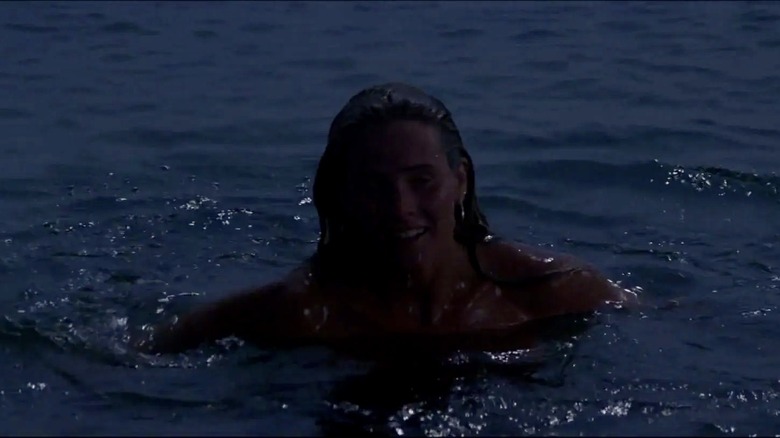
The music of John Williams, which Spielberg first dismissed as a joke, sets the immediate tone for "Jaws," as the film opens with the classic dun-dun dun-dun theme ramping up over the shark's POV. However, if you replaced Williams' score in that opening shot with, say, a calypso tune sung by a crab, you could alter the mood of it since there's nothing especially scary about what we see underwater.
The same cannot be said for what happens to Chrissie (Susan Backlinie), the shark's first unfortunate victim. As her campfire love connection, Tom Cassidy (Jonathan Filley), falls asleep drunk on the beach, Chrissie finds herself alone in the water with a movie monster. The thrill of potential romance, the exuberant run along the fence, the peeling-off of clothes to go skinny-dipping at sunrise, all give way to abject terror as the camera reverts to the shark's POV of Chrissie's backlit, kicking legs.
It has just found itself a meal. The scariest thing about this scene is the way Chrissie starts hyperventilating after the shark first tugs her down. Soon, it's yanking her all around and she's splashing and screaming, but Tom is still passed out drunk, and the floating buoy offers no sanctuary.
Chrissie has told us we're going swimming and invited us to, "Come on in the water," and now we realize just what that entails in the context of the cinematic experience. With this scene, "Jaws" announces itself in no uncertain terms as a thriller and a horror film where no swimmer is safe.
'We Need Summer Dollars'
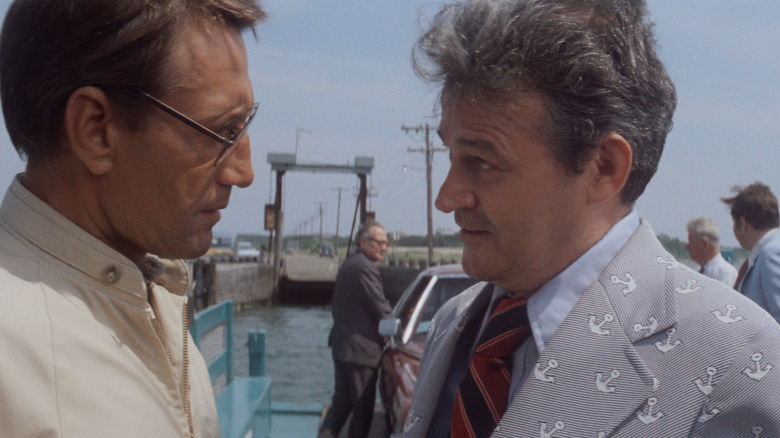
"Jaws" is perceptive about human nature, which can be petty and prone to denialism even in the face of societal threats. One of the most biting subplots — that doesn't feature any direct shark bites on the characters involved — centers on police chief Martin Brody (Roy Scheider) and his attempts to shut down the beaches and protect people from the shark. This brings him up against Larry Vaughn (Murray Hamilton), the mayor of Amity Island, who insists, "Amity is a summer town. We need summer dollars."
Vaughn delivers this line to Brody on a ferry, where he's accompanied by five other men. Two of them hang back as Vaughn, local reporter Meadows (Carl Gottlieb, who co-wrote the screenplay with "Jaws" author Peter Benchley), and the Medical Examiner (Robert Nevin) corner Brody. They don't want him acting unilaterally, doing things on his own authority, especially not when it would interfere with Amity's tourist trade. As the ferry moves out to sea, the men peel off one by one: first the Medical Examiner, then Meadows.
Soon, it's just Brody with Vaughn, the politician who proceeds to rewrite the story of Chrissie's death as a boating accident. Vaughn doesn't want to cause a panic on the Fourth of July, and that symbolizes so much. Islanders like him represent the capitalist side of America; they are the institution that confuses self-interest for self-preservation. In 2022, the waters are filled with tentpoles that seek to reproduce the commercial success of "Jaws" without internalizing its artistic lessons.
Vaughn will later tell the TV news camera, "Amity means friendship," but it's not always friendly to outsiders. Even people who live on the island but weren't born there, like Brody and his family, qualify as lifelong outsiders.
Dolly Zoom On Brody
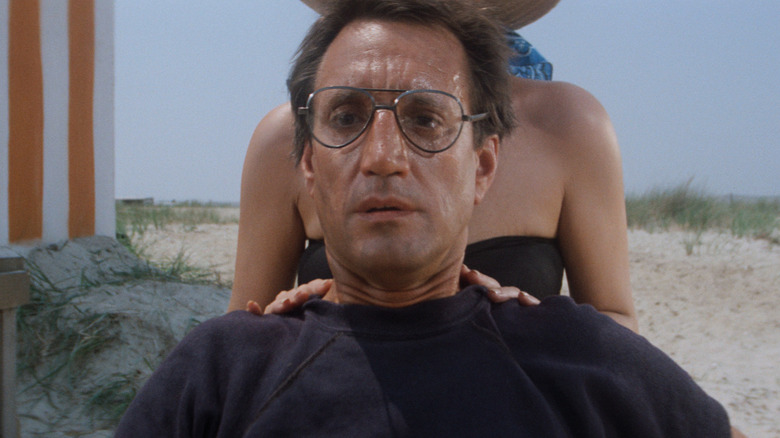
Irmin Roberts, a second-unit cameraman for Paramount Pictures, first devised the dolly zoom while working on Alfred Hitchcock's "Vertigo." There, it was used to give the dizzying sensation of looking down and experiencing vertigo — an effect achieved by zooming one way while simultaneously moving the camera along a dolly in the opposite direction. In "Jaws," Spielberg and cinematographer Bill Butler ("The Conversation," "One Flew Over the Cuckoo's Nest") used a horizontal version of the dolly zoom to heighten Brody's reaction to the shark attack on young Alex Kintner (Jeffrey Voorhees).
The effect is preceded by another interesting bit of camerawork: the split diopter shot that allows us to see a man's head big in the foreground, with the small figure of an ocean swimmer in the background, both in focus at the same time. Mr. Taft (an uncredited Phil Murray) is talking to Brody, but all the while, Brody keeps looking over his shoulder, trying to play beach lifeguard, only to experience a couple of false alarms.
He interacts with one of them, an old man in a swim cap (Alfred Wilde, also uncredited), who joshes him about not going in the water. Brody dismisses him with the line, "That's some bad hat, Harry" (the namesake of the production company behind "The Usual Suspects" and "X-Men" movies).
People keep wanting Brody's attention, but he's preoccupied with nagging fears that the mayor and his rationalizations about Chrissie's so-called "boating accident" could not quell. When the shark swims in and turns Alex's raft into a fountain of blood, everything else falls away. The dolly zoom only lasts one or two seconds, but it's an indelible image that puts the squeeze on Brody, crystallizing the moment when his worst fears are validated and a child dies under his watch.
Quint Makes His Entrance
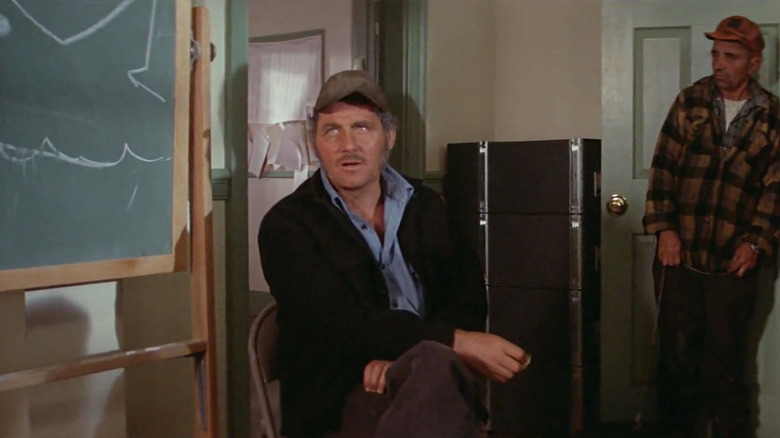
When Alex's deflated raft washes up in blood-red water on the shore, it leads straight into a scene at the county courthouse. The uproar in the council chamber where Amity's citizens are dealing with the fallout of Alex's death is disrupted by the scratching of nails on a chalkboard.
Enter: Quint, the working-class shark hunter played by Robert Shaw. The camera drifts across the crowded room to him, and suddenly, he's hijacked the whole scene.
With the way Quint sits there in his fisherman's cap and long sideburns, legs crossed, munching on a potato chip, saying, "I'll catch this bird for ya, but it ain't gonna be easy," he might initially come across as a caricature to some modern viewers. But keep in mind, this was before the Sea Captain on "The Simpsons" or any such parody.
As it is, Quint commands the attention of a room full of people, and Shaw breathes three-dimensional life into him beyond the retroactively amusing first impression he makes. There's a $3,000 reward for "the man or men who catch the shark that killed" Alex, but Quint ups the ante, outlining just how dangerous the shark really is and saying he'll do the job, but only for $10,000.
In this scene, Quint arrives to the party late, but he knows how to make a dramatic entrance and a well-timed exit. He even has his own entourage, which consists of one other mute fisherman and a dog on a leash. We can imagine a whole backstory with these guys sitting around on Quint's boat, fishing and drinking. Granular details like these add to the rich characterizations that have enabled "Jaws" to stand the test of time.
The False Victory Of The Tiger Shark Catch
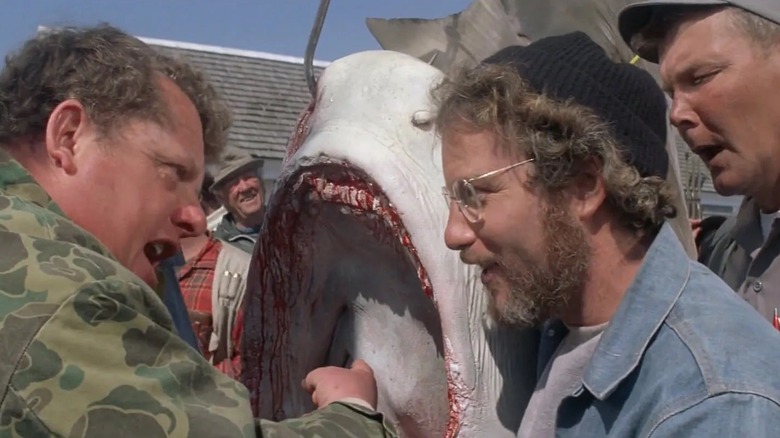
The arrival of out-of-town oceanographer Hooper (Richard Dreyfuss) gives Quint's blue-collar boat smarts a well-educated, white-collar foil. It further validates Brody's fears and gets us even more on board with his view of Amity's predicament, as Hooper autopsies Chrissie and confirms that her death resulted from the "non-frenzied feeding" of an attacking shark that's "considerably larger than any normal Squalus found in these waters."
The size of the shark becomes a point of contention when a group of local fishermen string up a tiger shark they've caught, thinking this is the shark that killed Chrissie and Alex. It's a big fish with blood all over its mouth, and everyone — Brody included — gathers around, celebrating, shaking hands, and posing for a group photo.
Hooper, meanwhile, measures the shark's mouth and determines that it doesn't have a big enough bite radius (though it does eat fish and license plates whole, as we'll learn later). This causes conflict among Hooper and the fishermen, who don't take kindly to this city slicker ruining their moment.
It's a key moment in "Jaws," one that illustrates an early sort of "false victory," whereby the mission that drives the movie already seems to be accomplished. If only it were that easy.
As Hooper raises awareness of the truth about the tiger shark, Vaughn talks about how he's not going to cut the thing open and watch the Kintner boy's remains go spilling out all over the dock. Speak of the devil: as Vaughn looks up to see Mrs. Kintner (Lee Fierro) arrive in black mourning clothes. She slaps Brody across the face and lets him know she blames him for her son's death, at which point any sense of victory goes out the window.
'Michael's In The Pond...'
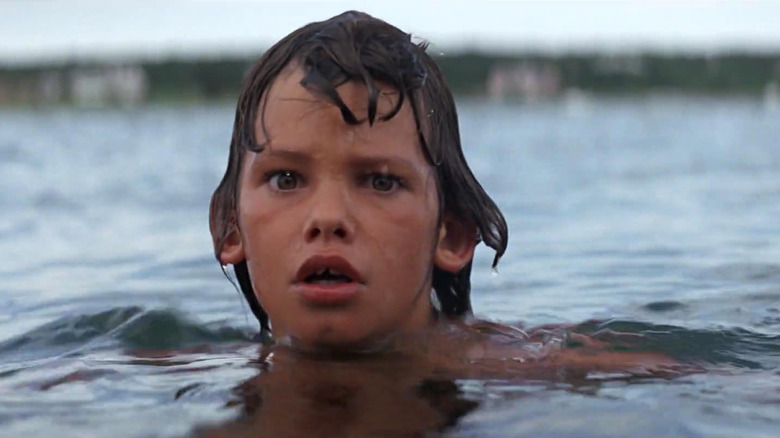
The look on the face of Brody's son, Michael, played by child actor Chris Rebello, as he gets dunked in "the pond" — a shallow estuary that was supposed to be safe — is another lasting movie image that speaks to the inner child in all of us. "Jaws" warns us earlier that "most shark attacks happen in three feet of water," but the viewer might forget about that as the film misdirects them toward the main beach where the water is more crowded. Kids with a cardboard fin raise another false alarm there, while the dialogue downplays the pond as a place "for old ladies."
Michael isn't enthused when his safety-obsessed father confines him and his boat to the pond. Then, a shark spotter sights a real fin, definitely not cardboard, gliding his way. A man in a nearby rowboat, the Estuary Victim (Ted Grossman), goes into the water first, before the shark tips the boat with Michael and his friends in it.
It's here that we get our first real glimpse at the shark via a God's-eye shot of it, through the water, then briefly surfacing, as it snatches the Estuary Victim and leaves his blood bubbling up and severed leg sinking to the bottom. Michael is in now mortal danger — he could be the next Alex — and the stakes are realer than ever for Brody and the audience.
This scene pays off an earlier one with Brody and his wife, Ellen (Lorraine Gary). At first, "Jaws" leaves open the possibility that Brody is overreacting and fixating on sharks too much, but when Ellen sees a picture of a shark biting into a boat while Michael is playing on one docked nearby, her swift change of heart gets the audience more on board with Brody.
'You're Gonna Need A Bigger Boat'
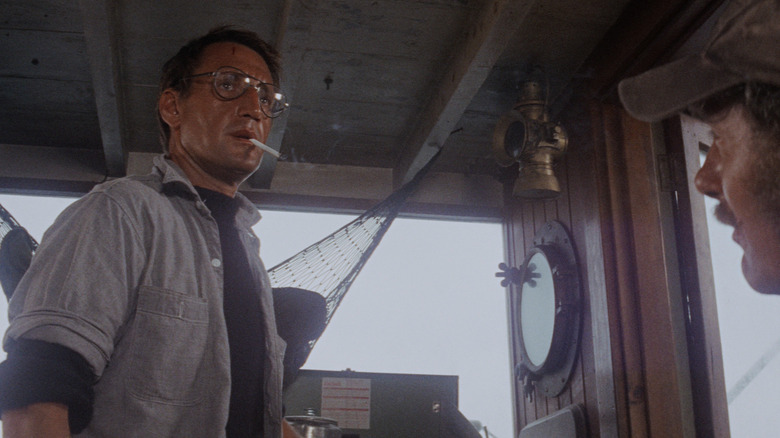
The American Film Institute voted this one of the greatest lines in movie history. The Alamo Drafthouse theater chain even came up with three different price tiers based on the line. And to think that it wasn't even in the script...
"You're gonna need a bigger boat" originated as a catchphrase on the set of "Jaws," as the crew had to deal with numerous problems, including a boat that wasn't big enough to pull a production barge, and the infamous mechanical shark, Bruce, which was constantly malfunctioning.
"Jaws," like any good movie, is about characters overcoming a series of challenges. In this respect, it mirrors the stressful working environment in which it was made. Even though there's blood in the water, the emergence of a 25-foot, 3-ton shark right alongside the boat as Brody is chumming catches him off guard and raises the stakes — in visuals and dialogue — for The Orca's whole hunting endeavor. Suddenly, it seems like a suicide mission.
Spielberg works up to it perfectly: Hooper is playing solitaire on deck, not a care in the world, while Brody is left to grumble about his bloody bait chore with a cigarette hanging out of his mouth. Audiences are trained now to recognize the setup when you leave a character side frame in a monster movie with a lot of open space around them, but this trick was less well-worn in '75.
Withholding the cue of the shark's music theme, a trick employed in the third act, also heightens the scare. Bruce pops out and Brody pops up, his neck ramrod straight, as he backs through the wheelhouse door in shock and utters the line to Quint.
Quint's USS Indianapolis Speech
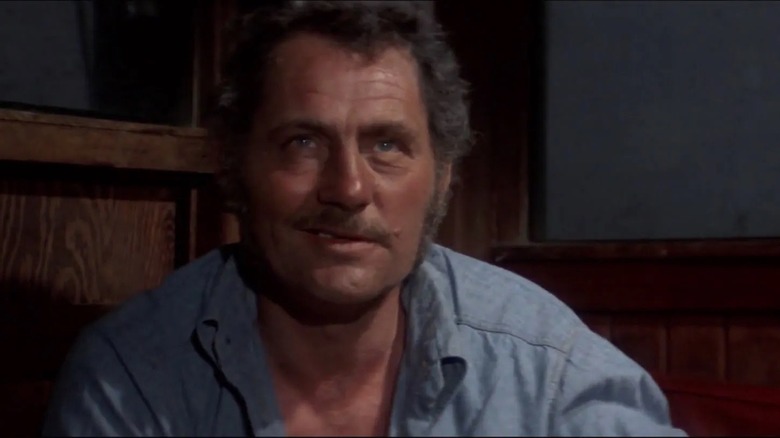
There's a school of thought that "pure cinema" should uplift images and minimize dialogue, as if somehow transitioning out of silent films into talkies was a mistake and moving pictures should only ever show you things without telling you anything. While that may be a good rule of thumb to keep screenwriters from using dialogue as a crutch, "Jaws" shows that such rules were made to be broken.
Six years before "My Dinner with Andre," Spielberg sat men down at a dinner table in The Orca and had them comparing scars (including one broken heart) and telling — yes, telling — stories. It's all fun and games until a tattoo that Quint had removed becomes a conversation piece and he drops the name "USS Indianapolis."
All the air gets sucked out of Hooper's laugh and it leaves him catching his breath as the mood in the boat's wheelhouse immediately changes. Powered by Robert Shaw's acting and John Milius and Howard Sackler's screenwriting contributions, the ensuing three-and-a-half-minute monologue Quint delivers contains such vivid descriptions that the mind's eye takes over, filling in images where none are present except his talking head and Hooper's blurred listening form.
We can imagine the torpedoes slamming into the ship and 1,100 men going into the water after delivering the Hiroshima bomb. We can see the sharks' black doll eyes and the ocean turning red as they pick off six men per hour, leaving one man bitten in half and bobbing up and down in the water.
This scene, which is Spielberg's favorite, is the calm before the storm. No sooner does Quint conclude his monologue and the "Show Me the Way to Go Home" sing-along begin than we're back outside in the water as the yellow barrel denoting the shark's presence returns.
Farewell And Adieu, Quint
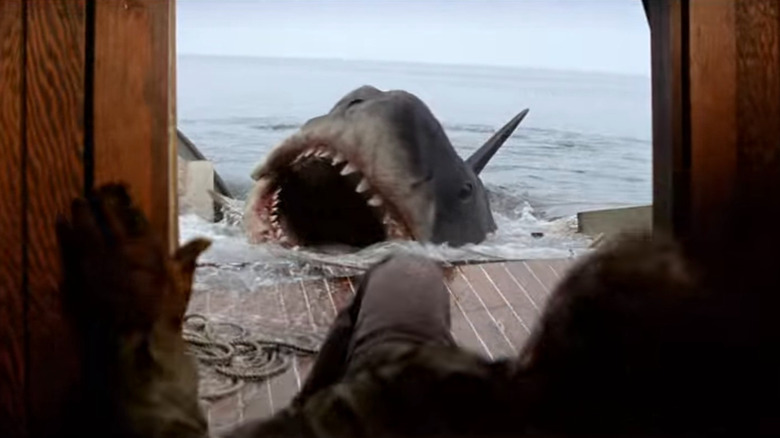
Quint is Captain Ahab, and in the same way that "Moby Dick" ended with Ahab's ship sinking in a hellacious vortex, The Orca goes down and Quint goes with it. Of all the deaths in "Jaws," his is the most graphic and the most horrific because we're seeing a character we've come to know and care about get eaten mercilessly. And there's no looking away.
Quint slips from Brody's grip and the viewer even shares his POV, looking down into the shark's mouth as the fisherman slides toward it, his legs kicking on the edges of the frame. When the final burst of blood escapes Quint's mouth and the screaming is all over, the shark simply pulls him down into the water, and like that, he's gone. We switch to an over-the-shoulder shot from Brody's perspective, and the sea is quiet again.
Minutes earlier, there was a moment where Quint was left to ponder his ship taking on water and the sight of the lifejacket he'd never again wear while Williams' music dipped into the melody of "Spanish Ladies." This is the diagetic naval song that Quint sang earlier in the movie as if to suggest Hooper was doomed. We later see Quint smash the radio, putting an end to any distress calls and sealing his own fate.
The movie thus delivers a reversal of fortune with his death, since Hooper has swum to safety even after looking death in the eye and seeing it demolish his shark cage. In their absence, Brody is left to contend with the shark alone on a sinking ship in the final minutes of "Jaws."
'Smile, You Son Of A...'
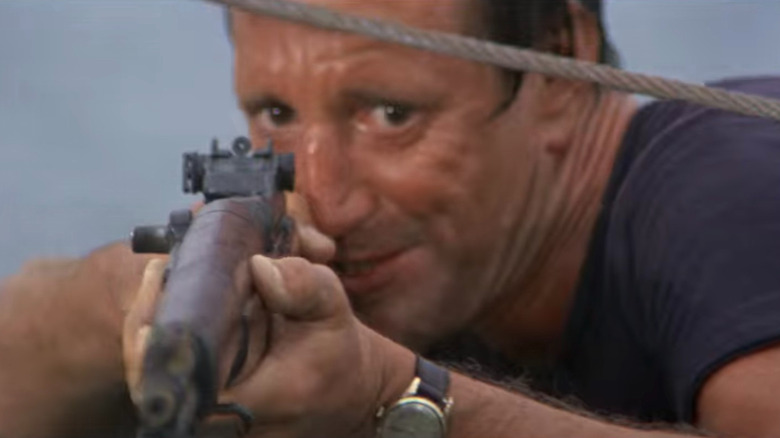
The biggest moment of triumph in "Jaws" comes when Brody kills the shark, but first, he needs to take aim. He's perched on the mast, almost in the water, and has already missed several shots as he tries to land a bull's-eye on the scuba tank in the shark's mouth. Spielberg draws out the suspense and tightens on Brody as he finally lines up his last chance at a shot and says, "Smile, you son of a..."
It would be easy to go the full "son of a bitch" route à la John McClane's later "Die Hard" quote, "Yippee-ki-yay, motherf*****!" But the audience can finish Brody's sentence for him, just as it can imagine the shark before it ever comes onscreen (and picture the Indianapolis without seeing it at all).
Keeping in mind that we've just witnessed a shark eat a man alive, it's worth remembering that "Jaws" was rated PG. This was years before the Motion Picture Association of America instituted the PG-13 rating to bridge the gap between PG and R. It did this at Spielberg's suggestion after films like his own "Indiana Jones and the Temple of Doom" pushed the boundaries of what was PG-appropriate.
Stopping short of the b-word leaves room for another cloud of blood. Brody blows up the shark like Ripley blew the Xenomorph out of the airlock in "Alien." Yet, instead of drifting off into space like her, Brody comes back to shore and comes full circle to where he doesn't even hate the water anymore.
Hooper resurfaces, and hope is not just restored, but fulfilled. It's a happy ending that almost re-contextualizes Brody's "Smile..." line as one that Spielberg is directing at the viewer as he aims to deliver a crowd-pleaser with "Jaws" — succeeding 47 years over.
Read this next: 14 Sequels That Truly Didn't Need To Happen
The post The 10 Greatest Jaws Moments appeared first on /Film.
The 14 Best Sopranos Characters, Ranked
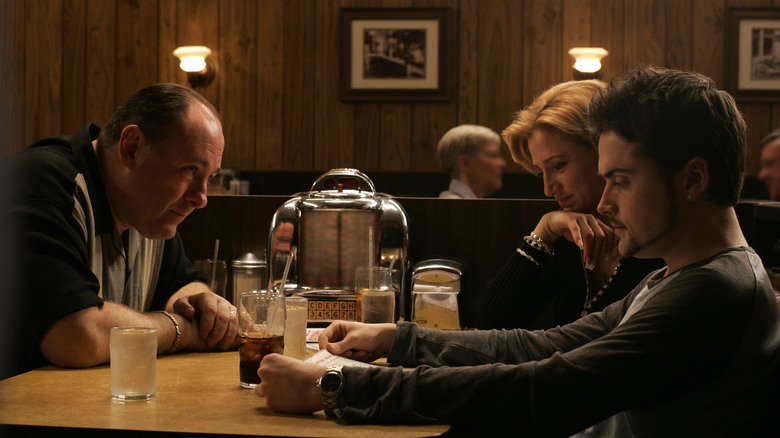
When it comes to a show as expertly crafted and packed full of compelling characters as HBO's "The Sopranos," narrowing down a list of the best characters is a Herculean effort. There are just so many candidates, each with unique reflections of the show's themes of family dynamics, moral ambiguity, and the changing climate of post-9/11 America. Since the airing of its final episode in 2006, HBO's mob family drama has stood the test of time as a mark of quality yet to be matched or (surpassed) by any prestige television series.
Thanks to a legendarily talented team of writers and directors, led by show creator David Chase, who also wrote the recent prequel feature film, "The Many Saints of Newark," it's not so difficult to break down exactly why these 14 characters continue to entertain and emotionally shatter us on every re-watch of "The Sopranos." We've tried to weigh these choices by how compelling their storylines are, how nuanced and insightfully they are rendered, and how they continue to speak to us long after that infamous cut to black.
Everything beyond this point carries a big spoiler warning: We can't delve into what makes these characters so fantastic without getting into some of the show's most iconic and memorable moments.
Gloria Trillo
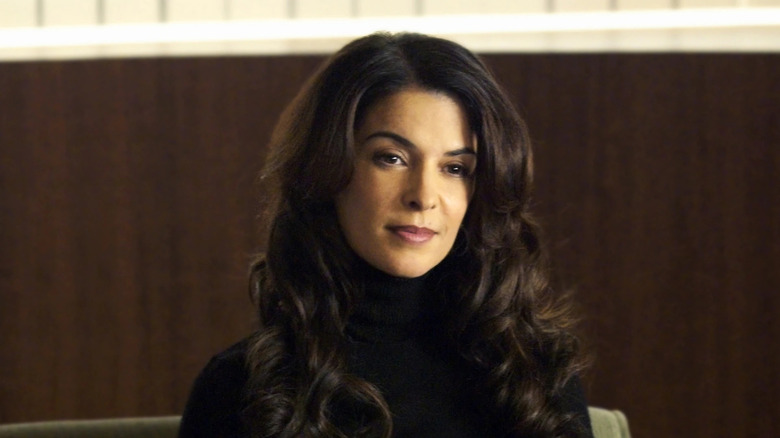
In the show's third season, Tony (James Gandolfini) meets Gloria Trillo (Annabella Sciorra), a fellow patient of therapist Dr. Melfi (Lorraine Bracco). Immediately taken with her, Tony successfully pursues Gloria as the latest of his many extramarital affairs. Although she only appears in seven of the show's 86 episodes, actress Annabella Sciorra delivers one of the most impactful and emotionally turbulent performances of the series as Gloria. Intelligent, confident, and independent, Gloria is arguably the one woman Tony Soprano could have plausibly left his wife Carmela (Edie Falco) for.
Unfortunately, complications of Gloria's personality disorder (which had caused the erosion of several past relationships as we learn in dialogue between Gloria and Dr. Melfi) lead to a tragic end for the character. After Gloria's jealous side begins to rear its head, Tony cuts their relationship off entirely. Fearing that Gloria will expose their affair to his family, he even orders one of his subordinates to threaten her at gunpoint.
In the fourth season, we learn that grief-stricken Gloria has taken her own life. It's a heartbreaking revelation for both the audience and Tony, who is haunted by Gloria's death throughout the rest of the series. Sciorra's performance as Gloria scored a well-deserved nomination for outstanding guest actress in a drama series at the 2001 Primetime Emmy Awards, and remains one of "The Sopranos'" most memorable characters.
Artie Bucco
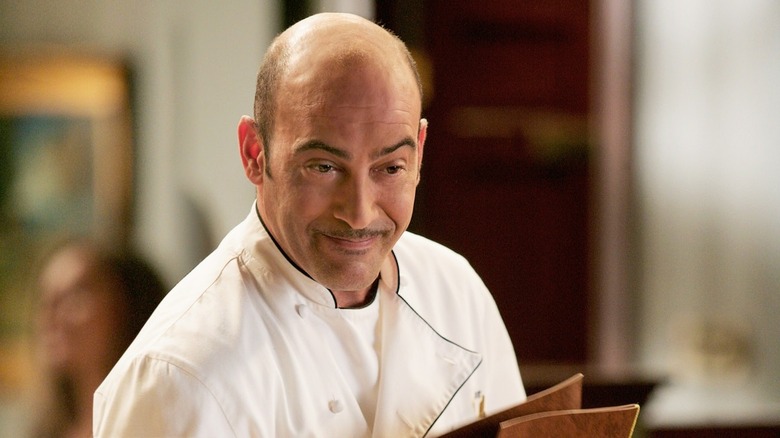
Alongside his wife Charmaine (Kathrine Narducci), Artie Bucco (John Ventimiglia) is best known as the co-owner and head chef of Vesuvio, an Italian restaurant popular with many of the show's characters. Charismatic and ambitious, Artie is a well-respected local figure. Underneath the charm, however, he's deeply insecure and wishes he could take part in Tony's less-than-legal enterprises.
His relationship with Tony is strained throughout the show. Most notably, Vesuvio burns down in the first season as a complication of a hit ordered by Tony's uncle Junior (Dominic Chianese). Although Tony hides his involvement in the incident and Vesuvio is rebuilt with insurance money, Artie eventually learns the truth through Tony's mother (Nancy Marchand) and never truly forgives his childhood friend.
John Ventimiglia's portrayal of Artie Bucco is equal parts charming and pitiful. In later seasons, Artie's desire to live a more extravagant life leads him into fruitless attempts at wooing younger women (including Adriana La Cerva, played by Drea de Matteo) and getting into crippling debt, which nearly leads to his death. He's a character you want to see succeed because he's good at heart, but his frequent self-sabotage is more cringe-worthy than anything else.
Furio Giunta
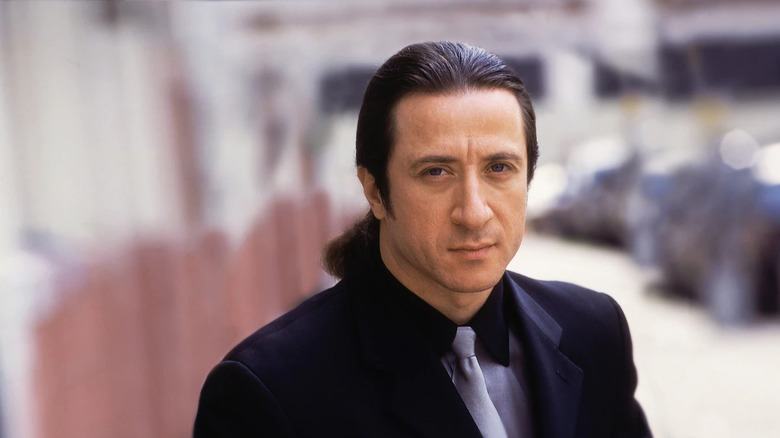
In the show's second season, the DiMeo crime family grows its ranks with the introduction of Furio Giunta (Federico Castelluccio). As part of a deal scored by Tony on a visit to Naples, Furio is brought back to the United States and quickly becomes an indispensable member of the crew.
At first, the wonders of America are exciting and novel to Furio. His unflinching brutality on the job and loyalty to Tony bring him close to the family, and he soon becomes infatuated with Carmela. The feeling is mutual, and an unspoken romance blooms between Tony's wife and his right-hand man.
The longer Furio spends in the Italian-American world, the more he becomes disillusioned with his decadent new home and his employer. Tony's blatant disrespect for Carmela becomes a thorn in Furio's side, leading to a nail-biting sequence where Furio very nearly kills Tony by pushing him into the rear propeller of a helicopter during a drunken night out. We never learn of Furio's fate, as he flees the country after Carmela admits her affection for him to Tony.We'd be lying if we said the idea of Furio and Carmela eloping to Naples wasn't an appealing one — but it wasn't meant to be. On the bright side, we get a loveable character who reflects the cavernous divide between the Italian and American Mafias.
Anthony 'A.J.' Soprano
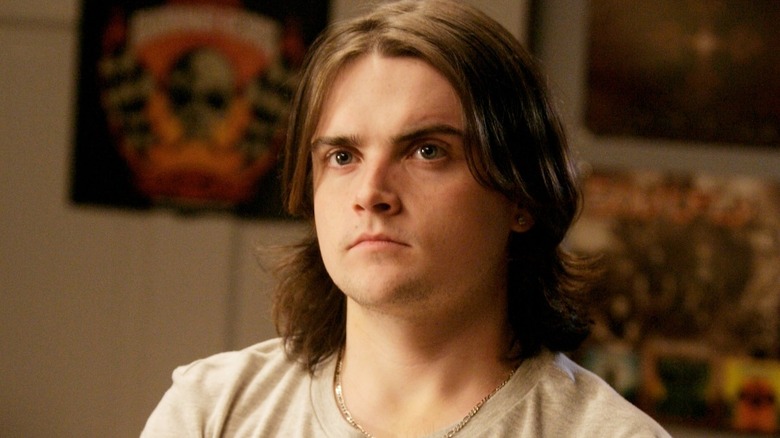
One of the greatest parts of watching "The Sopranos" from beginning to end is watching the Soprano children (and the actors that played them) grow up from season to season. While Meadow (Jamie-Lynn Sigle) and A.J. (Robert Iler) are both great characters, Carmela and Tony's son ultimately takes this spot on our list.
From the early days of Mario Kart and bowl cuts to nightclubs and facial hair, Robert Iler does a fantastic job of capturing the troubled upbringing of A.J. Soprano. It's clear from the start that A.J. is cut from a different cloth from that of his father. He has little to no interest in becoming the heir to the mob family legacy and lacks the sociopathic edge required to survive in the business.
A.J. is sensitive and frequently struggles to meet his parents' expectations of him, not only at school but as a human being. Torn between old and new ideas of success and struggling to find a sense of identity amidst rapidly changing cultural, social, and political worlds, he's an excellent example of the post-9/11 American youth.
Janice Soprano
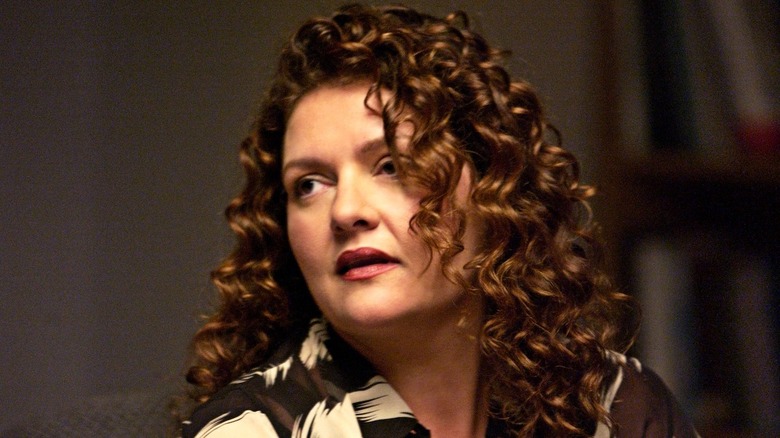
On the surface, wayward hippie Janice Soprano is the antithesis of her younger brother Tony, but truthfully, the reason they clash so much is that they're more similar than either would care to admit.
Played by Aida Turturro in the series and Alexandra Intrator in the prequel film, "The Many Saints of Newark," Janice is a frequent issue for Tony. After many years of soul-searching, the eldest Soprano sibling returns to Newark to care for her elderly mother in the show's second season.
She becomes romantically involved with several members of the DiMeo crime family, including Jackie Aprile (Chase Vacnin), Richie Cifaretto (Joe Pantoliano), and Bobby Baccalieri (Steve Schirripa). One of Janice's finest moments is her murder of Jackie Aprile after he strikes her during an argument, gaining Tony's respect and proving that she's just as much a Soprano as her brother.
Janice might be frustrating as a character, but Aida Turturro's performance is arguably one of the show's best — especially during the moments in which Tony and Janice set aside their differences and reflect on their shared experiences as the flawed Soprano children.
Adriana La Cerva

Drea de Matteo is spectacular as Adriana La Cerva, loving partner to Christopher Maltisanti (Michael Imperioli) and under great duress, an FBI informant in later seasons. Adriana is an almost endless source of optimism and affection, bouncing back from countless instances of Christopher taking her for granted. It's impossible not to appreciate her infectious personality from the beginning.
When she's befriended by an undercover FBI agent in the show's third season, it's gut-wrenching to see her being taken advantage of to bring down Tony's crime syndicate. Her loyalty to Christopher initially keeps her from offering the authorities anything to work with, but as they apply pressure, she slowly buckles in the naïve hope of escaping with her boyfriend.
In a devastating but inevitable act of betrayal that still brings tears after all these years, Christopher ultimately chooses the family over his fiancé. Oh, Adriana. You deserved so much better.
Paulie Gualtieri
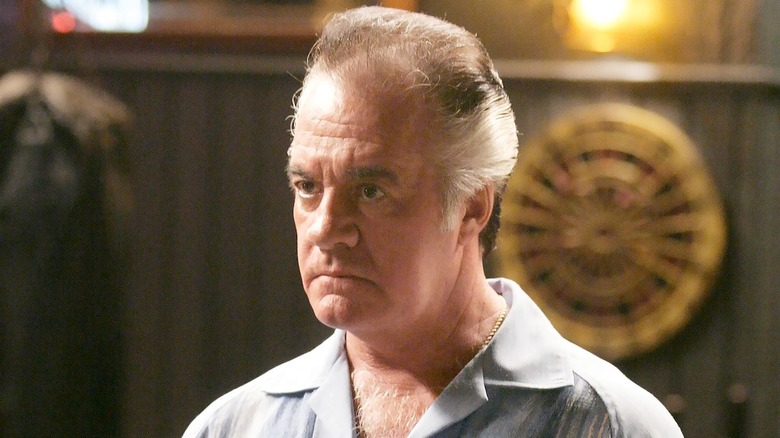
Paulie Gualtieri (Tony Sirico) is one of the DiMeo crime family's oldest and most loyal members, having served under both "Johnny Boy" Soprano (Joseph Siravo) and his son Tony. He's undoubtedly one of the show's biggest sources of comic relief, but Paulie also has some of the most compelling story arcs in the later seasons.
Despite his constant wise-cracking (and iconic cackle), Paulie is ruthless in the field. He's also incredibly stubborn as best depicted in one of the show's most beloved episodes "Pine Barrens," in which he and Christopher almost freeze to death in the New Jersey wilderness after botching a hit.
As the series progresses, a much more emotional and superstitious side of Paulie is revealed. When he learns his beloved elderly mother (Frances Esemplare), may not be his real mother, Paulie is bereft and outraged, proving that there's a frightened young boy hidden deep down in many of the show's staunch Mafia men.
Vito Spatafore
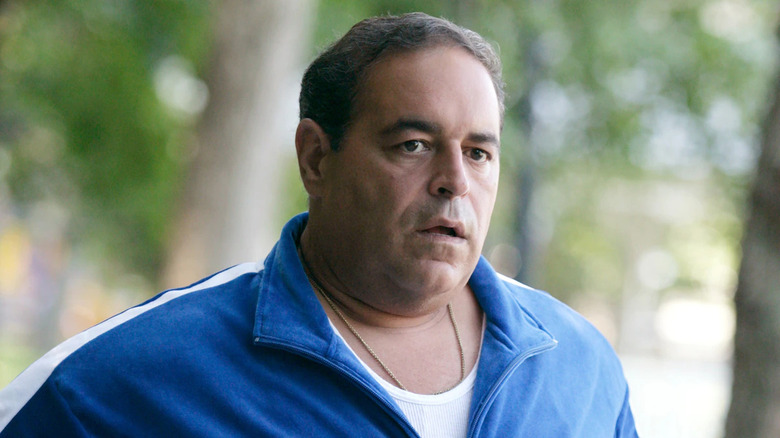
Vito Spatafore, played by Joseph R. Gannascoli, doesn't factor into "The Sopranos" in a major way until the show's third season. When Vito is caught in a compromising situation with another man in the fifth season, the ensuing story arc makes him one of the show's most memorable characters.
Vito is an effective earner, steadily rising up the ranks of the family throughout the series, but when he's caught dancing provocatively in a gay bar in the show's sixth season, Vito knows he has no choice but to flee or face certain death as a response to his bisexuality.
The story arc involving Vito's escape to New Hampshire where he falls in love with Jim, a local diner cook, is one of the show's most compelling examples of character writing. Torn between embracing his true self and giving up his cushy mob lifestyle, Vito serves as a prime example of the Mafia's conservative ideals clashing with modern progressive reality.
Livia Soprano
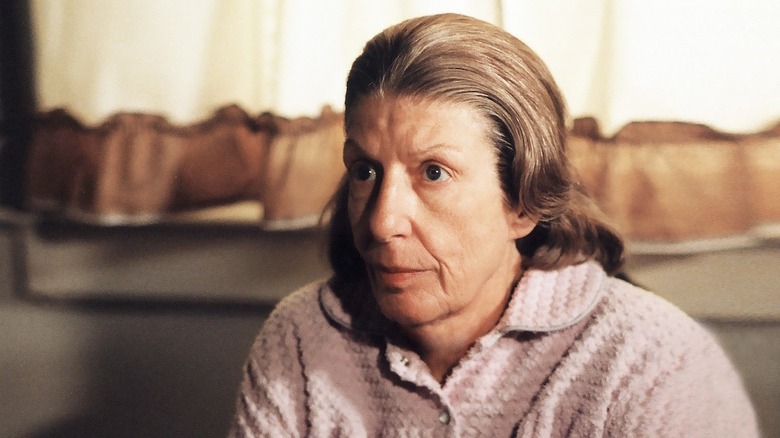
Anyone would be forgiven for hating Livia Soprano (Nancy Marchand) — especially her son. Manipulative and cruel, Livia looms over Tony even after her passing thanks to a lifetime of put-downs and guilt.
Despite putting on the appearance of being a helpless widower, she conspires with Junior Soprano to have her son (unsuccessfully) killed in response to being moved into a retirement village. Her gradual mental decline in the second season is (guiltily) more than a little satisfying after seeing how she treats those around her. She's a superb villain, and the way she expertly gets under Tony's skin is incomparable to even the most deadly adversaries he faces in the show's run.
Livia was based on show creator David Chase's late mother, Norma, and the personal touches in conjunction with Nancy Marchand's performance are what makes her so effective. Vera Farmiga also knocked the role out of the park in the prequel film, "The Many Saints of Newark" as a much younger Livia.
Corrado 'Junior' Soprano

Tony's uncle Carrado, affectionately known as "Junior" to most, is without a doubt one of the show's most compelling characters.
With his father gone, Junior is one of Tony's few living connections to the old-school days of the DiMeo crime family. While their affection for each other runs deep, Junior's dwindling power becomes a point of contention for the pair in the show's first season, kicking off an ongoing feud that threatens to tear the family apart.
He might be a villain for much of the series, but Junior's relentlessly charming personality also makes him inherently likable, even when he puts Tony in a coma in the show's final season after his looming dementia causes Junior to mistake his nephew for a long-dead rival.
Junior's bond with Bobby Baccalieri (Steve Schirripa) is also adorable, even if he doesn't always treat Bobby with the respect or kindness he deserves. When Junior's mental state begins to significantly decline in the show's later seasons, the affectionate relationship between Bobby and Junior is among its most memorable.
Carmela Soprano
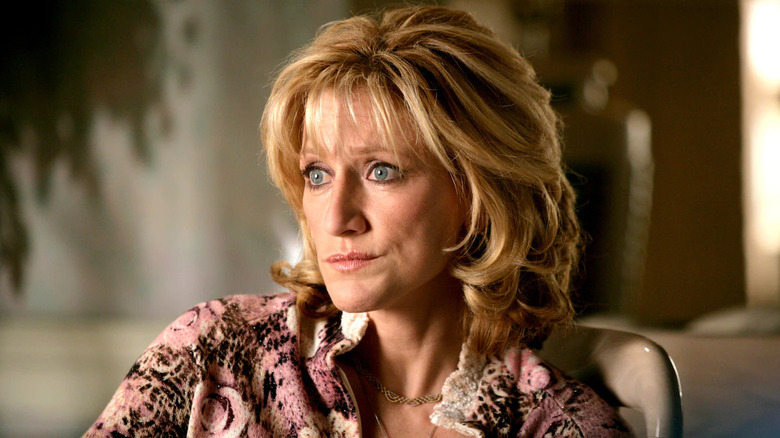
Let's be honest. Edie Falco is such a good actress, she would've made a more mediocre character sing anyway. However, Carmela Soprano is one of "The Sopranos'" many examples of a great character brought to life by a fantastic actor.
Far more than just the quiet trophy wife of a mobster, Carmela Soprano is a complicated woman. While she's right in her criticisms of Tony's violent and opulent lifestyle, she certainly doesn't mind turning a blind eye when it comes to that lifestyle's spoils — a point that frequently drives a wedge between the couple throughout the show's run.
Carmela's complicated relationship with her husband's line of work is deeply compelling, and it's hard to resist rooting for her when she's tempted to stray from their marriage when Furio appears on the scene. Despite her mistakes, she's an intelligent, highly independent woman who tries her best to keep her family together through even the most nightmarish scenarios.
Christopher Moltisanti
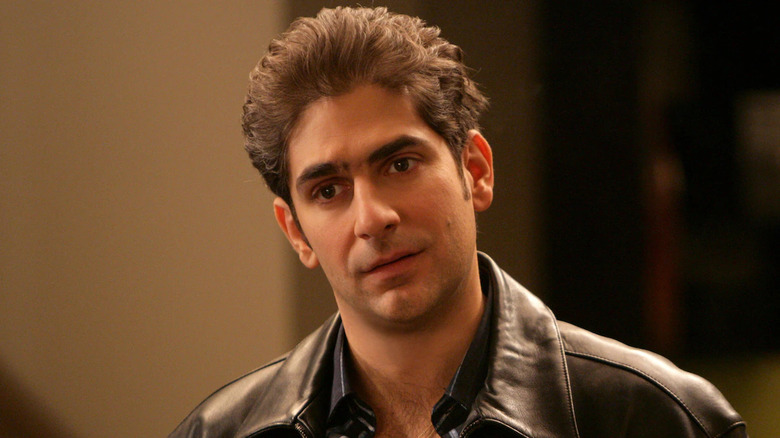
Tony's nephew Christopher (Michael Imperioli) is handsome, charismatic, and has a clear vision of the man he'd like to become. Unfortunately, he's also the king of self-sabotage.
It's hard to name the single best story arc involving Christopher Moltisanti because they're all superb. What makes Christopher such a brilliant character is his determination to make everybody proud, even if he constantly falls ten steps back for every step he takes forward.
From his attempts at breaking into Hollywood as a screenwriter to his struggles with heroin addiction to hunting down his father's killer, Michael Imperioli delivers one of the show's most nuanced performances. You can't help but root for him to conquer his demons, even if those demons are usually self-created.
Infamous scenes like Christopher's intervention and his accidental smothering of Adriana's dog while intoxicated are just a few examples of how simultaneously hilarious and dark the character can be, and Michael Imperioli takes that writing to the next level with his deadpan delivery.
Jennifer Melfi
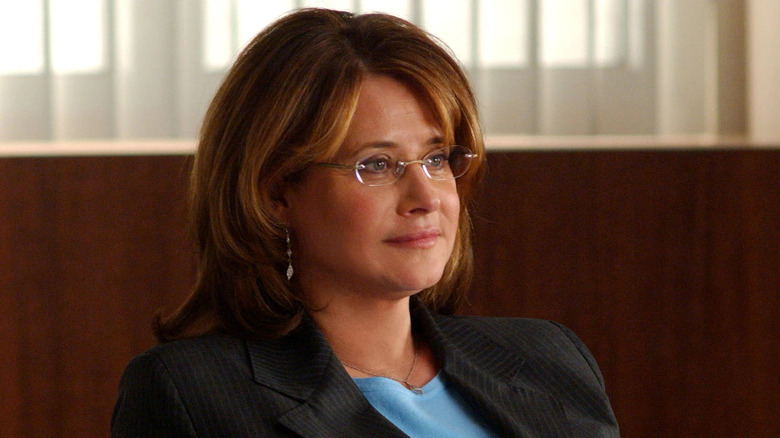
If there's any character in "The Sopranos" who can be considered an audience surrogate, it's Lorraine Bracco's Dr. Jennifer Melfi.
We spend a lot of time with Dr. Melfi, and that is one of the show's blessings. Fans of "Goodfellas" will know that Lorraine Bracco doesn't need to be the lead to absolutely command a film or television series, and that's just as true here. As Tony Soprano's therapist, Melfi digs deep under the surface of Tony's complicated psyche, forcing him to confront his behavior and ways of thinking far beyond any mob boss's comfort level. Yet, Melfi is far more than just a prompt for Tony Soprano's introspection. She's a complex character in her own right, confronting some of the show's most important themes of identity and morality in the modern age.
When Melfi is violently assaulted by a stranger in the show's third season, she's faced with an incredibly difficult moral dilemma: She could enlist Tony's help and get violent justice, but she'd be condoning the very criminal behavior that she finds abhorrent in her patient. Melfi's ultimate decision is one of the show's most controversial moments, but it's a truly powerful stance from an all-time great character.
Tony Soprano
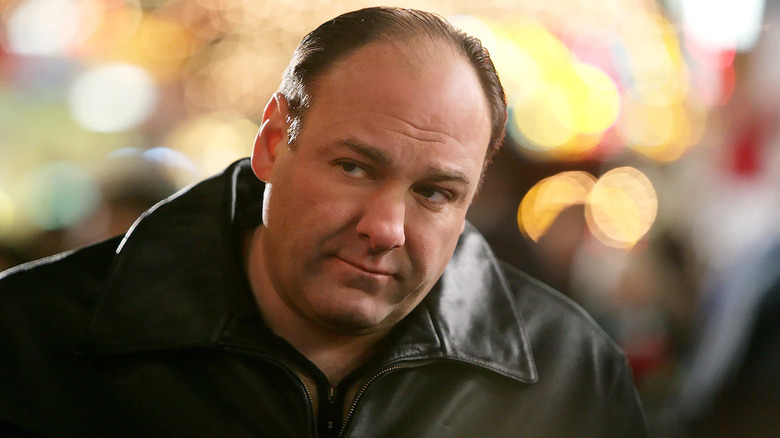
It feels like cheating to choose the protagonist and namesake of "The Sopranos" as its best character, but there's no way around it. Tony Soprano is not just the show's best character, he's one of the greatest characters in television history.
Driven by an incomparable performance by the late James Gandolfini, Tony constantly straddles the line between infuriating and loveable. It's not uncommon for long-running shows to run out of ideas for their lead, shifting the focus to more under-developed supporting characters or spiraling off into spin-off shows, but thanks to David Chase's insightful and multifaceted explorations of the modern man and the post-9/11 Mafia boss, "The Sopranos" effortlessly carries its audience through all of Tony's trials and tribulations.It's not easy to pull off an antihero in the way "The Sopranos" does with Tony. There's no denying he's a monster who commits countless acts of violence against his enemies and even his loved ones. By so intelligently exploring and confronting the complex mechanisms of how people like Tony Soprano come to be and continue to succeed in our world, we are rewarded with a legendary television series that continues to inspire and entertain long after its final moments.
Read this next: The 18 Best Crime Dramas In TV History
The post The 14 Best Sopranos Characters, Ranked appeared first on /Film.
The Many Men Who Inspired Quint In Jaws
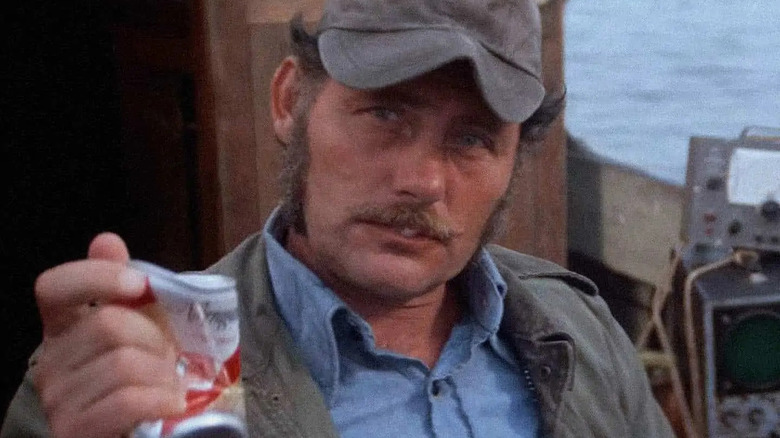
When a monstrous great white shark stakes a claim in your quaint seaside town and starts munching on the locals, there's only one person you can turn to, and that's Captain Sam Quint, the larger-than-life cantankerous old bastard fisherman who has a personal grudge against all maneaters. He's tough as nails, has absolutely zero filters, and feels like he hates just about everybody on Earth, especially those damn sharks.
When Steven Spielberg was tasked to bring this character to life on the big screen, he cast one of the best "tough guy" actors ever in the role: the great Robert Shaw. Thus, Quint was born, one of the most entertaining characters ever to grace the silver screen.
Turns out there's a surprisingly long and complicated history behind the character, To start breaking that down, we'll have to go back to Peter Benchley's original novel.
Quint is, in fact, the reason for the shark-hunting season. The novel "Jaws" wasn't written because Benchley was fascinated by shark attacks, although the New Jersey shark attacks of 1916 did end up forming the basis for what would eventually unfold on the fictional Amity Island. No, the acorn that grew into the best-selling novel was not the sharks, but rather a particularly interesting — and slightly problematic by 2022 standards — human named Frank Mundus.
Peter Benchley And Frank Mundus
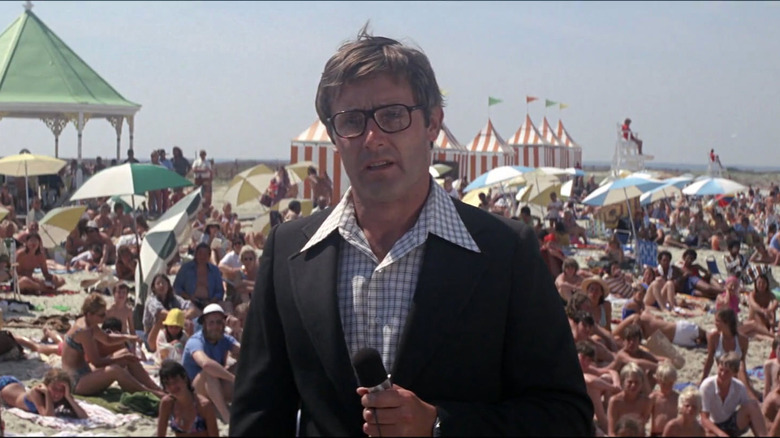
Mundus was a local legend in his home port of Montauk, Long Island, famous as a "Monster Fisher" and the (self-proclaimed) first fisherman to see dollar signs in taking charters out to catch big, scary sharks, not just the usual gaming fish found in the area. The man was old school even in the '50s and '60s, preferring to harpoon his targets. His harpoons had a line with barrels attached to them that would pull the fish close to the surface and not let it escape once tagged.
Sounds a little familiar, doesn't it?
In 1964, Mundus harpooned and killed a massive great white, believed to have weighed around 4,500 pounds. This world record fish got a lot of media attention which put Mundus on the radar of a young writer named Peter Benchley.
To hear Mundus say it, Benchley went out with him multiple times and based the entire character of Quint in the book around him. In interviews with the man later in life, he seemed to get a little confused between the book and the movie "Jaws," but the sentiment was the same either way. His point of view boils down to Quint = Frank Mundus. "Every scene in the movie 'Jaws' came right off the boat because every fish you catch over 1,000 pounds you catch different; they have a different story," Mundus told Nancy Atlas in an interview conducted shortly before his death in 2008. "So he put those stories together and made the movie 'Jaws.' That's all."
The Author Disagrees
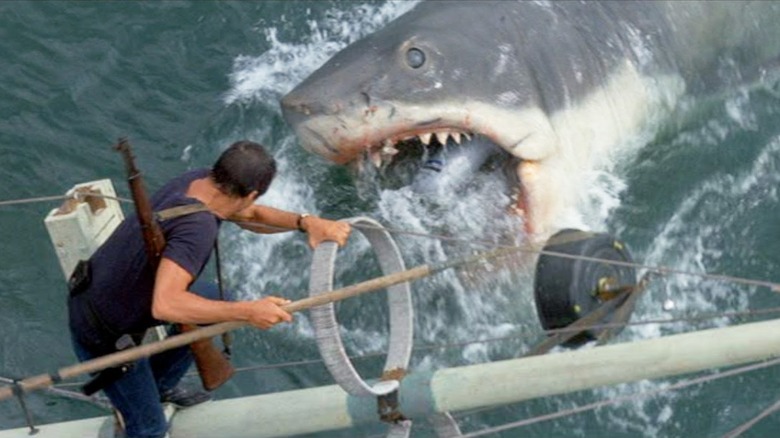
Benchley himself gave Mundus at least partial credit but insisted there wasn't one singular fisherman who inspired the character of Quint. In a rare public appearance at JawsFest in 2005, Benchley was answering questions with the other credited screenwriter of "Jaws," Carl Gottlieb, when he was asked about Mundus. "He and about six other guys were the inspiration," Benchley said. "As all characters, especially colorful characters, they're composites of other people, and I went out with many fishing captains in my youth, all of whom had pieces of Quint in them. [...] He was a big, colorful shark fisherman at that time and he benefited hugely from the publicity that he generated for himself."
If Benchley seems to be a tad catty, that's not your imagination. Mundus believed wholeheartedly he was the one, true Quint and was publicly sour that he was never officially acknowledged by Benchley beyond a passing admission that there's some of Mundus in the character. Benchley has stood firm over the years that Mundus never deserved sole credit.
It should be noted that Ballantine Books released a 40th-anniversary edition of "Jaws" in 2013 that included some of Benchley's original work materials, not the least of which is a list of alternate title ideas he'd jotted down during the writing of the novel. Some are obvious, like "Great White," while others are head-scratchers, like "Shimmo Cove." But one potential title does stand out: "Letter on Mundus."
It certainly seems that Frank Mundus was on Benchley's mind. All other parallels aside, and for the purposes of this discussion, it's pretty clear that Mundus was at least a significant spark for what would eventually become Quint.
Benchley's First Draft Of The Screenplay Fell Flat
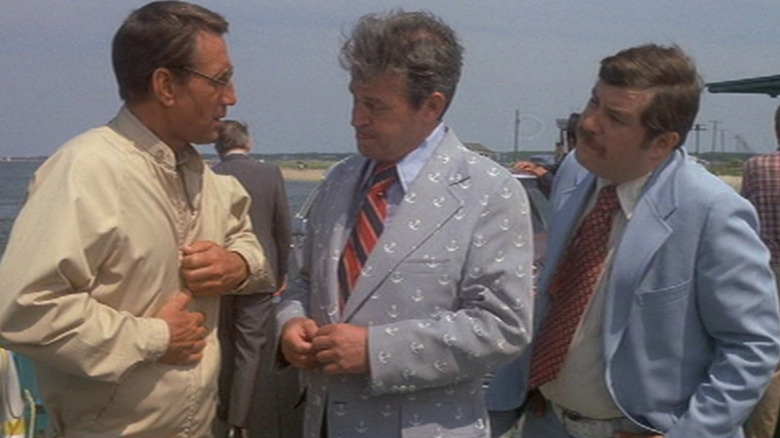
It's common knowledge now that "Jaws" was a troubled film production, and those troubles didn't begin on Martha's Vineyard. They started early on in the process when Benchley was hired to write an adaptation of his own book and flubbed it, as the author himself would wholeheartedly admit. Producer David Brown hired Benchley to adapt his own work, claiming that his deep knowledge of not just the source material but about sharks as well would only benefit the picture. The author would later realize Brown hired him because a writer's strike was looming and Benchley wasn't a member of the writers guild, having never penned a screenplay before.
That early draft, which Benchley called "garbage," was at least a foundation for the screenwriters who would come after him. More importantly, it removed a lot of the cheesier elements from the book, like the love affair between Hooper and Chief Brody's wife and the corrupt Mayor Vaughn's mafia connection. "What I did was basically transliterate the novel into a screenplay that I think, and to be kind to it, was dead," Benchley said. "It laid flat on the page because it had no 'movie business' business in it."
By "'movie business' business," Benchley means the little cinematic flourishes that give "Jaws" a sense of grounded personality, like the moment at the dinner table when Chief Brody's son mimics his father's movements and expressions.
The Small Details That Built A Blockbuster
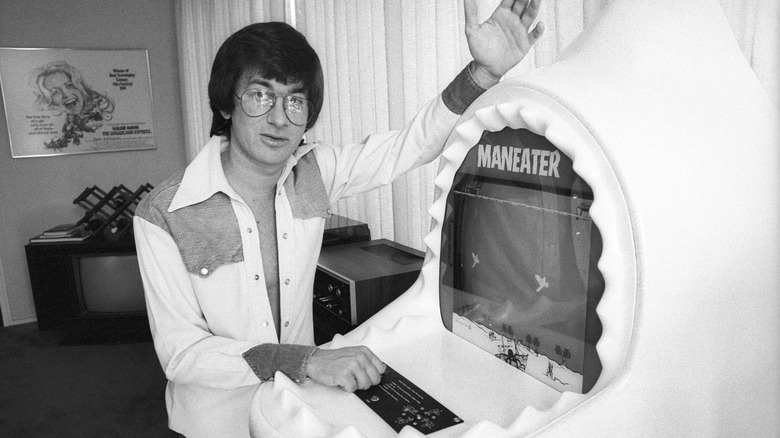
Recognizing Benchley's script wasn't ready for prime time, David Brown, Richard Zanuck, and Steven Spielberg brought in a few more writers before cameras started rolling in New England. One was Howard Sackler, the writer of "The Great White Hope," and the other was Carl Gottlieb, a writer known mostly for his comic chops. Sackler did a draft based on Benchley's script, and it was Sackler that first came up with Quint's famous Indianapolis speech. This scene is a standout and one of the only times Quint gets to be vulnerable as he tells his shipmates his thrilling WWII survival story that gives us all the reason we need to understand why he hates sharks.
This monologue is central to Quint as a character, at least as he's portrayed in the movie. In the novel, he works as an echo of Ahab, the Captain in "Moby Dick," obsessed with a great white shark instead of a white whale, but the movie gives him a deeper motivation for his unlimited drive to dominate the ocean and all its creatures.
Back in 2011, I had the opportunity to interview Spielberg about "Jaws," and he used this chat as a means to put the record straight on who has authorship over this scene in particular and also "Jaws" on the whole. "There's a lot of apocryphal reporting about who did what on 'Jaws' and I've heard it for the last three decades," Spielberg told me, "but the fact is the speech was conceived by Howard Sackler, who was an uncredited writer, didn't want a credit and didn't arbitrate for one, but he's the guy that broke the back of the script before we ever got to Martha's Vineyard to shoot the movie."
Gottlieb handled script duties on Martha's Vineyard, primarily responsible for character punch-ups and on-set rewrites. He also played a small role in the film as Meadows, who runs Amity's local newspaper.
Famously, the cast and creative team would gather together every night for dinner and go over their characters and upcoming scenes, and just bond in general. Gottlieb wrote about these evenings in his book about the making of the movie called "The Jaws Log," a must-read for any fan of the film. These raucous off-hours meetups were responsible for a lot of those "'movie business' business" moments Benchley spoke about.
Robert Shaw Got The Final Rewrite
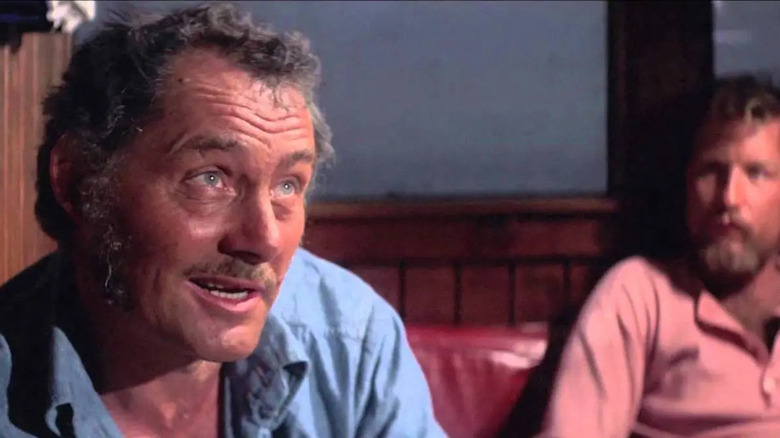
Robert Shaw's contribution to the Quint we know and love is the most important, but not just because of his powerhouse performance. Shaw also happened to be a novelist and playwright himself, having penned the acclaimed novels "The Flag," "The Man in the Glass Booth," and "A Card From Morocco," so Spielberg let him take a crack at the Indianapolis speech before they rolled film.
As the director laid out the evolution of this speech, Howard Sackler introduced the idea for the backstory, and Spielberg says he then turned it over to his friend John Milius ("Apocalypse Now," "Conan the Barbarian") who transformed a single page monologue into an unfilmable 10-page behemoth. Knowing it was gold, but also too long, the final step in this chain was Robert Shaw, whose rewrite brought the 10-page Milius draft of the speech down to 5 pages that ultimately ended up in the movie.
When casting Quint, Spielberg definitely had a type he was going for, which made the casting process surprisingly difficult for the young director. "Casting sometimes is fate and destiny more than skill and talent, from a director's point of view," Spielberg told me in 2011. "First I went to Lee Marvin and he said no. Then I went to Sterling Hayden and he said no. Then finally David Brown, who had just worked with Robert Shaw on 'The Sting,' said 'What about Robert Shaw?' I said, 'David, you're a genius!' And Robert said yes. That was a simple story, although it took six months to cast Quint."
There was still the tricky matter of transforming this intimidating, very Irish man into a true New Englander. Hair, makeup, and costuming would help, as would Shaw's decades of experience on stage and screen, but if the name of the game was authenticity at all costs, Shaw would need a little local help.
Enter Craig Kingsbury
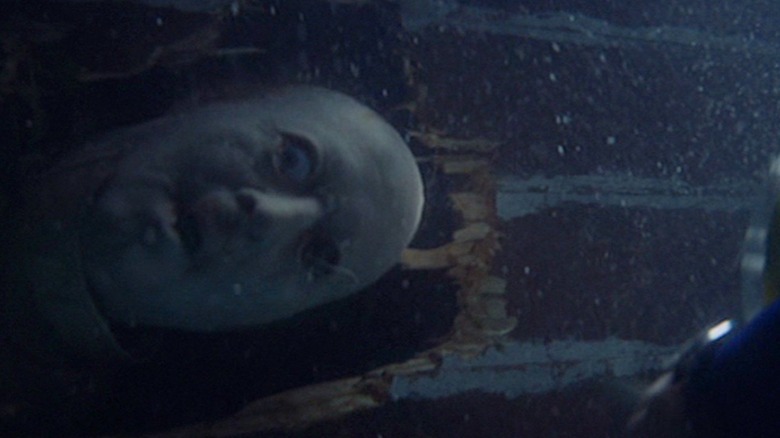
Craig Kingsbury was a colorful Martha's Vineyard islander whose drunken antics became the stuff of legend in the small community. There was one time he drove a team of oxen into Vineyard Haven and was arrested for causing traffic accidents. The funny part is that the only person who could actually remove the animals from town was Kingsbury himself, and the cops had to let him go if they wanted the oxen off their clogged streets.
Sarcastic, filthy, and about as deeply rooted in New England swagger as one can get, Kingsbury ended up being the basis for a lot of Quint's on-screen personality. Every time Kingsbury opened his mouth, a new colorful colloquialism would spring out, and a fair amount of those sparks of character made their way into Robert Shaw's performance.
The movie crew noticed this and decided it'd be a shame to keep this guy off-camera. So, not only did Kingsbury work with Shaw to build an authentic, crusty fisherman character but he was cast in the small but important role of Ben Gardner, a character who pops up a few times early on in the story and who would eventually scare the crap out of every member of the audience. Ben Gardner's head pops out of the hole in the hull of his boat, scaring Richard Dreyfuss' Hooper so badly that he drops a tooth he'd just found, the evidence that proves a great white shark is the culprit behind the attacks off the coast of Amity Island.
The Jump Scare That Helped Break $100 Million At The Box Office
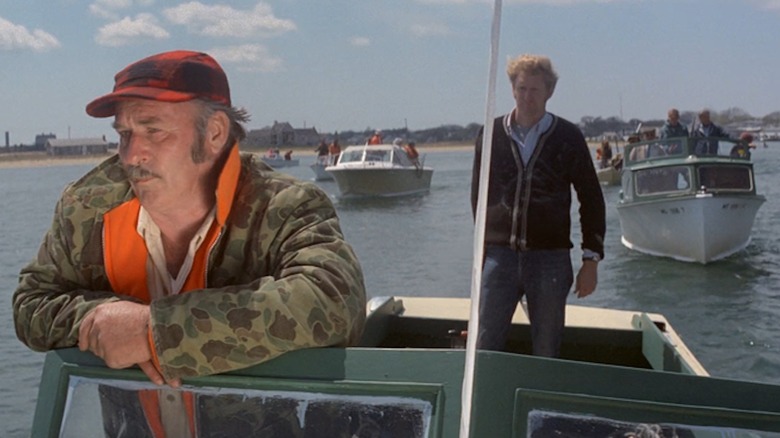
Most people know this scene — it's one of the best jump scares of all time — but what a lot of folks don't realize is that Ben Gardner was around before. In fact, he's the guy that first welcomes Hooper to the island. "Gee, I hope you're not going out with those nuts, are ya?" We also see Ben Gardner shortly before his off-screen demise as all the fishermen are going out to hunt the shark and claim the $3,000 bounty put out by the grieving Mrs. Kintner. He's the experienced fisherman making fun of all the amateurs. "When we get them silly bastards down in that rock pile, it'll be some fun. They'll wish their fathers had never met their mothers!"
Knowing that Shaw took a lot of Kingsbury's mannerisms and sayings for his interpretation of Quint, it's really fun to look back at those glimpses we get at Kingsbury in the movie. It's the closest thing we had to a real-life Quint.
So, Robert Shaw's performance and Spielberg's direction are huge pieces of that iconic character, but like just about every famous movie character there are a lot of people that can claim a piece of the success. In this case, we have Frank Mundus, Peter Benchley, Howard Sackler, John Milius, Carl Gottlieb, Craig Kingsbury, Steven Spielberg, and Robert Shaw, along with probably a dozen other small contributions from the makeup, wardrobe, and hair departments.
It takes a village to make a Quint, and the village that produced this character is just as wild and memorable as the salty fisherman we've known and loved since 1975.
Read this next: The 15 Worst Sci-Fi Movies Of The 21st Century (So Far)
The post The Many Men Who Inspired Quint in Jaws appeared first on /Film.
David Chase And Joe Pantoliano Disagree On This Sopranos Mystery
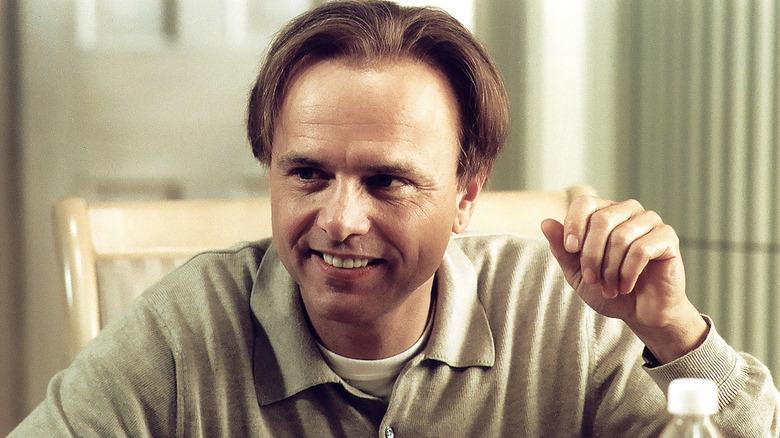
One of the reasons that "The Sopranos" has endured even as its Prestige TV imitators fade away is that its creators knew when to be ambiguous. The series never holds its audience's hand, which makes for rewarding repeat viewings. 15 years later, we're still talking about what the cut to black which ended the series finale, "Made in America," means. That's far from the only mystery in the show, though.
During seasons 3 to 4, the biggest rock in Tony's shoe is Ralph Cifaretto (Joe Pantoliano). Tony can't stand "Ralphie," particularly after the psycho kills his own 20-year-old, pregnant stripper girlfriend Tracee (Ariel Kiley) in "University." Still, Ralph brings in too much money for Tony to get rid of him -- until Season 4's "Whoever Did This." Midway through the episode, a horse named Pie-O-My that Tony and Ralph co-owned dies in a barn fire. Tony suspects Ralph set the fire to collect the insurance money, but Ralph denies it. The confrontation escalates and Tony beats him to death, shouting, "She was a beautiful, innocent creature! What did she ever do to you?!" as he pummels Ralph on his own kitchen floor.
In the world of the mafia, animal abuse is a faux pas at best, but it's what does Ralphie in. At least, assuming he did actually set that fire. This question divides not only the show's fans, but its makers.
David Chase's Opinion
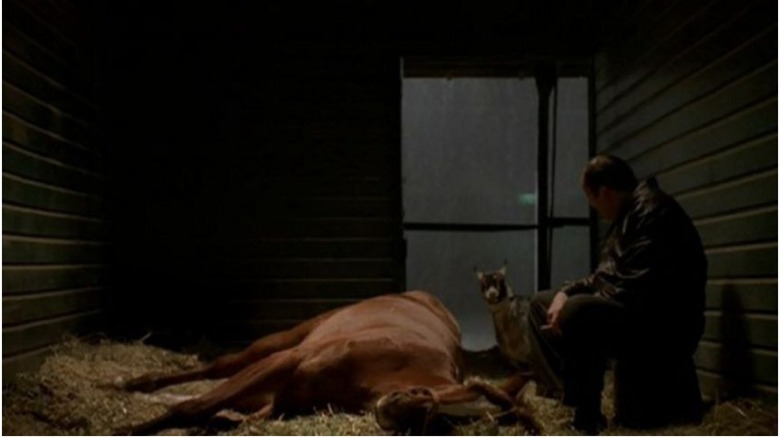
"The Sopranos" creator David Chase isn't always the most forthcoming, but for this question, he's made an exception. Critics Matt Zoller Seitz and Alan Sepinwall interviewed Chase seven successive times for their book, "The Sopranos Sessions." In Session #4, Sepinwall asks Chase if Ralph set the fire which killed Pie-O-My. Interestingly, Chase initially answered no, but it seems this was a slip of the tongue because he reversed course a moment later, "I take that back! I think he did burn it down. That was the intention."
When Chase appeared on the finale of the podcast, "Talking Sopranos," Steve Schirrippa (the actor who played Bobby Bacala) asked Chase the same question as Sepinwall had. This time, he was even more blunt: With only two seconds of hesitation, Chase confirmed the theory once again. "Yeah."
Ralph setting the fire is the obvious conclusion since there's no one else in the episode with a compelling motive to do so. Indeed, during "David Chase Session #4," Seitz, taken aback by Chase's initial recanted answer, said, "I never even considered that he didn't burn it down." Still, the episode gives Ralph enough plausibility deniability that some maintain he didn't kill Pie-O-My. One of those people is the man who played Ralph, Joe Pantoliano.
Joe Pantoliano's Take
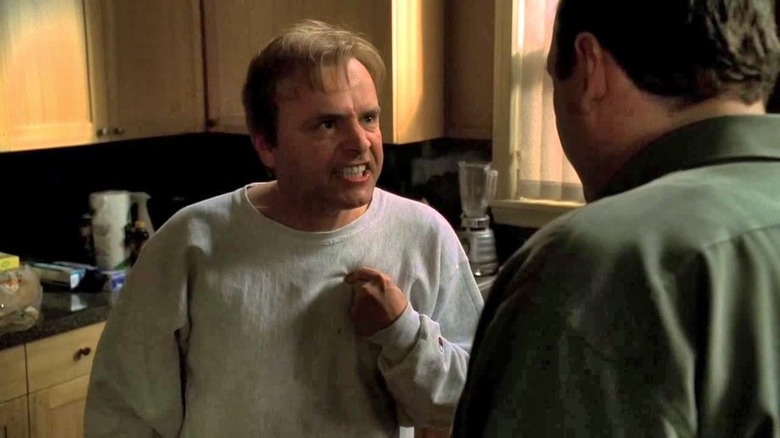
In the 2007 Vanity Fair feature, "An American Family," Pantoliano revealed that Chase wouldn't give him the answer to Ralph's guilt. So, he chose to play his final scene as if Ralph was innocent. He reiterated this in a 2012 interview with The Tommy Edison Experience. Describing Tony and Ralph's fight, Pantoliano said, "They're fighting and scratching and clawing at each other and it's over the indignation that Ralph has for being accused of killing a horse, when in fact he didn't kill the horse, he says, 'I didn't kill this horse you f***ing miserable piece of sh*t.'"
Knowing Pantoliano's mindset makes the scene play differently. Some of Ralph's lines which might come across as deflection instead register as frustration. Some context: Earlier in "Whoever Did This," Ralph's son Justin is injured in an accident. During his last scene with Tony, Ralph initially tries to steer the conversation towards his son's recovery, but Tony keeps going back to the horse. That's when Ralph drops the niceties. Is this Ralph abandoning a ploy to steer Tony away from his guilt, or is he genuinely angered that Tony cares more about an animal's well-being than his son's?
The Verdict
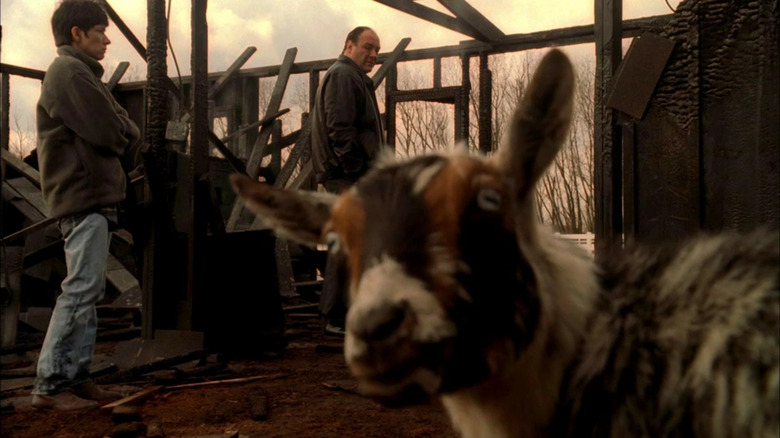
As a humble viewer, I'd say the circumstantial evidence points to Ralph being guilty. Yes, the episode never actually shows him do it and he denies it, but doing it and then denying it is absolutely the sort of thing Ralph would do.
A lot of his dialogue also reads as him trying to defend himself without admitting his guilt. He tells Tony, "We got lucky ... the horse was no f***ing good." He immediately follows up his denial with, "But so what?", before calling out Tony's hypocrisy. The man's a murderer, but is up in arms about a horse's death. Plus, as Ralph notes, "What are you, a vegetarian? You eat beef and sausage by the f***ing car load!"
In the Seitz/Sepinwall interview with Chase, the three all note the presence of a goat at the scene of the fire as evidence against Ralph. Goats have historically been associated with Satan, as was Ralph throughout "The Sopranos." "Whoever Did This" even works lyrics from "Sympathy for the Devil" into its dialogue; Justin's accident means "Sympathy for the Devil" is what Tony and the viewer are feeling for Ralph for the first half of the episode.
Despite this, part of me wants to believe he didn't do it -- not because I was rooting for Ralph's redemption, but because of the irony. If Ralph was innocent, that means one of the worst scumbags on the show, who had already narrowly dodged death a few times, was finally killed for something he didn't even do. That's a turn of events perfectly in line with the black comedy and purposefully anti-climactic storytelling of "The Sopranos."
Why'd Tony Do It?
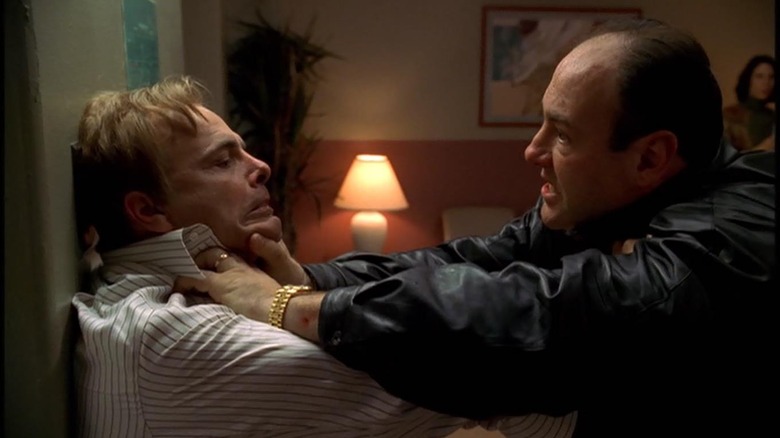
Within this mystery is wrapped another: What was the tipping point that made Tony kill Ralph? Was it Pie-O-My, Tracee, or some combination of the two? Tony's dialogue when beating Ralph can be read multiple ways. "Whoever Did This" also ends with Tony, having cleaned up after disposing of Ralph's body, looking at a picture of Tracee at the Bing.
On "Talking Sopranos," Chase elaborated about Tony's mindset. "Tony had it right, but the thing is, when he was beating up on Ralphie for killing Pie-o-My, it was really about that girl who [Ralph] killed, Tracee." Frankly, Chase's answer is the least interesting interpretation of the scene for me, because it's the most black and white, underlining Tony's (comparatively) good and in opposition to Ralph's evil. Viewing Tony's actions as avenging Tracee gives the scene a cathartic edge, but it runs counter to the series' larger point that Tony Soprano is not someone we should be rooting for.
It's also important to remember that in "University," Tony was dismissive of Tracee before her murder. Any affection he had for her came post-mortem because she happened to be the same age as Tony's own beloved daughter Meadow (Jamie Lynn-Sigler). Conversely, in the following episode "The Strong, Silent Type," Tony breaks down in tears over Pie-O-My's death. Dr. Melfi (Lorraine Bracco) even observes that he's grieving more for an animal than he ever has for a human being.
One interpretation I find particularly compelling is that it wasn't Tracee or Pie-O-My that was the tipping point. Tony just couldn't stand a man he hated calling out his hypocrisy. That's the type of behavior that's most in line with Tony, the impulsive murderer we know and love to hate.
Second Opinion
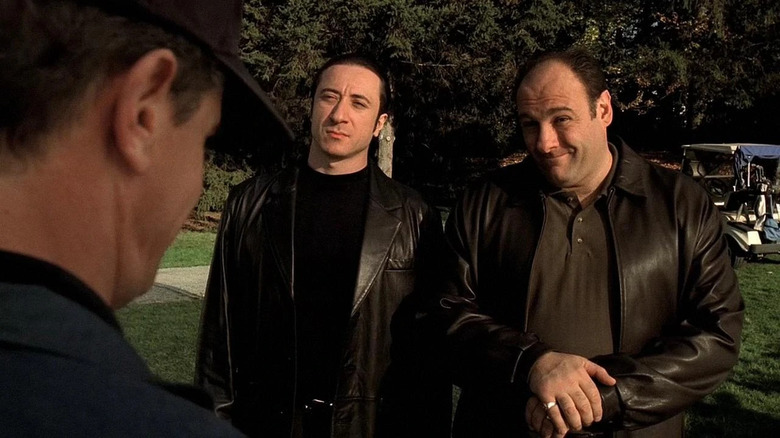
It's not just Chase and Pantoliano who come down on opposite sides. According to the audio commentary of "Whoever Did This," so do episode writers Robin Green and Mitch Burgess. Green says Ralph did it, while Burgess feels that he didn't. This disagreement in the writers' room, where the blueprint of the episode was built, is no doubt the root of the ambiguity in the final episode.
These splits also raise larger questions about how a text should be read. Roland Barthes' famous essay "Death of the Author" argued that an author's intent or biography should not define how their work is interpreted. This mindset is useful for analyzing collaborative art like film and television, which lack the singular authors that literary texts have.
But then, whose word is the most sacred? The one who writes the words or the one who interprets and delivers them? Or is it the audience who receives them? I'd say it's the latter, because the only final authority on how one reads a piece of art is that person: Even if a viewer abides by the author's intention, they're making a conscious decision to do so. That's why great art, like "The Sopranos," is that which lends itself to different, even competing, interpretations -- and the death of Ralphie Cifaretto is wonderfully emblematic of that idea.
Read this next: The 15 Most Anticipated Comic Book Movies And Shows Of 2022, Ranked
The post David Chase And Joe Pantoliano Disagree On This Sopranos Mystery appeared first on /Film.
A Short History Of Space Pirates In Star Trek
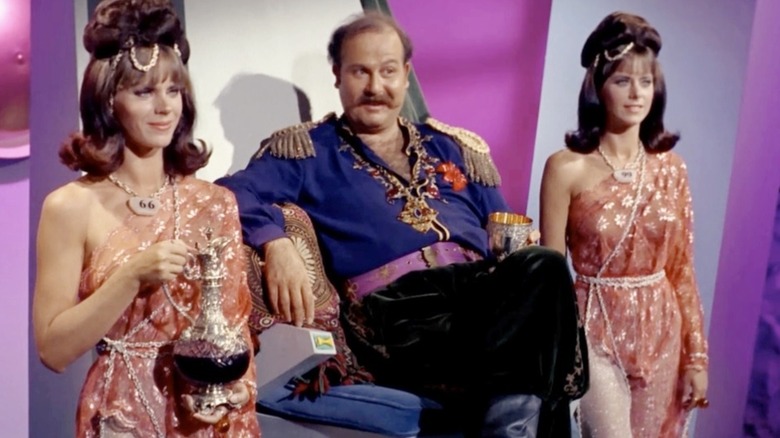
Last week, "Star Trek: Strange New Worlds" introduced one of the series' most entertaining new characters to date: Captain Angel (Jesse James Keitel), the roguish and theatrical leader of a pirate ship called The Serene Squall. Angel ingratiated themselves to Spock (Ethan Peck) under the alias of Dr. Aspen, but in reality, the charismatic criminal only wanted to free their husband from prison.
Captain Angel and their band of dissatisfied foodie marauders are far from the first space pirates to plunder their way through "Star Trek." That honor belongs to a very different — if equally dramatic — character by the name of Harcourt Fenton "Harry" Mudd. The scallywag, who is played by Roger C. Carmel in the older series and Rainn Wilson in "Star Trek: Discovery," is a sort of con-man jack-of-all trades. Mudd establishes the moral grey area that pirates and their ilk will occupy for the rest of the franchise in his appearances on "Star Trek: The Original Series," where he drops some good points about how knowledge should be free and the death penalty is bad — but, unfortunately, also traffics mail-order brides and steals alien technologies.
Smugglers, Thieves, And Privateers
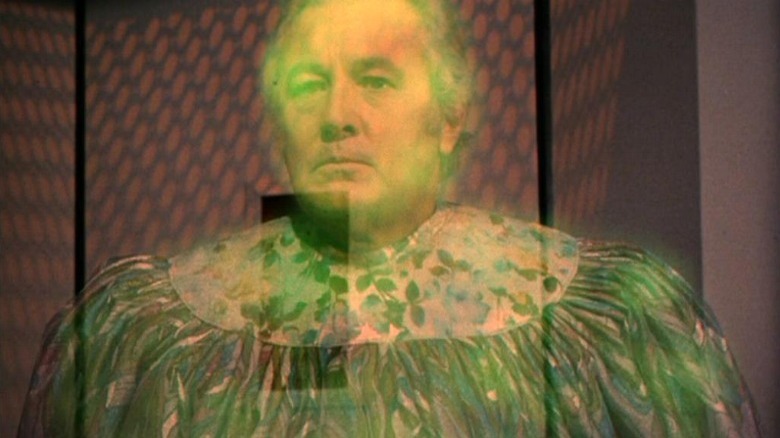
Mudd reappears more than many classic Trek characters, even popping up in "Star Trek: The Animated Series" to steal a spaceship and hawk faulty love potions. He's a dastardly dude to be sure, but he's also more overtly funny than many Trek villains thanks to Carmel's winking performance and epic mustache. Not every pirate in "Star Trek: The Original Series" is as comically villainous as he is, though. In the episode "And The Children Shall Lead," the Enterprise crew stumbles upon the ghost-like figure of the last of a race of marauders on the planet Triacus. The being, called Gorgan, gathered a following of children who ended up driving the adults around them to mass suicide, all to further its quest for domination.
Pirates, marauders, smugglers, and privateers all serve a complex place in real earth history, so it makes sense that they show up in many different forms across "Star Trek" lore too. Some are bucking the status quo or just trying to get by within a broken system, while others are cutthroat criminals. In fact, the original Enterprise crew themselves technically qualify as pirates at one point, when they steal the USS Enterprise — and later a Klingon ship — on a cross-galaxy quest to save Spock (and some whales).
Several planets in the "Star Trek" universe have become known for piracy and smuggling. In "Star Trek: The Animated Series," Orion pirates hijack precious medical cargo that's the only cure for Spock's fatal illness. This seems like a loose riff on a real story about the pirate Blackbeard, who legend says once held up a whole harbor of ships in a quest for some medicine.
A Wide Spectrum Of Hijinks And Villainy
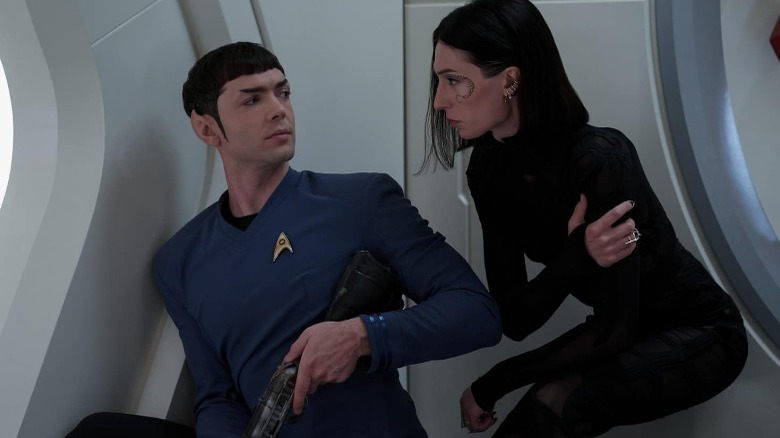
"The Animated Series" also introduced privateers into the franchise (privateers are essentially government-sanctioned pirates who are commissioned to fight pirates). A privateer ship called the "Traitor's Claw" appears in "The Animated Series," while in "Star Trek: Deep Space Nine," the mirror universe version of Benjamin Sisko (Avery Brooks) worked as privateer. Sisko actually ended up roped into near-piracy in two universes, as his partner, Kasidy Yates (Penny Johnson), ended up in prison after taking up smuggling amidst an inter-planetary conflict. In fact, geopolitics often play into the version of piracy presented on "Star Trek: Deep Space Nine," with smugglers like Razka Karn (Roy Brocksmith) and Latha Mabrin (Matt Roe) supporting the Bajoran resistance — albeit, sometimes through villainous means.
Some "Star Trek" shows clearly love the adventure and criminal intrigue of pirates more than others, and "Star Trek: Enterprise" brought them back in a big way. One episode of the show's first season saw the crew try to help a group that was savaged by Nausicaan pirates, while another sees Ferengi bandits attempt to loot the Enterprise. Later in the series, an episode sees the crew try to teach a group of beaten down colonists to protect themselves against Klingon marauders.
Pirates have played a versatile role in "Star Trek" history, sometimes representing the worst the galaxy has to offer, and other times representing a flicker of resistance in the face of injustice. Despite their ruthlessness, it's still not entirely clear where deliciously mean-spirited Captain Angel falls on the villainy spectrum. Still, the Serene Squall has ties to the newly revealed villain of "Star Trek: Strange New Worlds," so we'll almost certainly see this pirate crew again. "Star Trek" continues to boldly swashbuckle where no man has swashbuckled before.
Read this next: The 14 Best Sci-Fi Shows On Amazon Prime
The post A Short History of Space Pirates in Star Trek appeared first on /Film.
Westworld's Ed Harris On The Difference In Playing A Host Vs. A Human
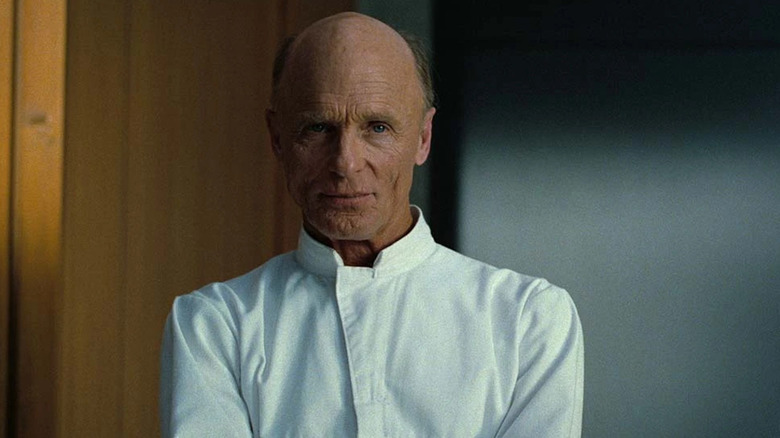
Examining the difference between humans and machines is the core theme of HBO's "Westworld." In our real life, we're edging closer and closer to sentient AI (if it's not already here), and the moral implications of that idea have been a cornerstone of sci-fi for about as long as computers have existed.
It makes sense that when Lisa Joy and Jonathan Nolan decided to tackle this title, they'd be most interested in the humanity in the machine and the lack of humanity in flesh and blood people. That's certainly what the show has been exploring for the last few seasons, but what about how the actors are involved? How do they tackle the different kinds of performances, especially when they play both human characters and robot versions of themselves?
Our own Danielle Ryan had the chance to talk to two certifiable legends who have had to deal with this very specific acting challenge: Ed Harris and Tessa Thompson.
Specifically, she asked, "Is there anything that you do to help keep the different versions of your characters aligned in your head or any little tiny things that you do to separate say Host William from human William or Charlotte versus Dolores Charlotte?" Both Harris and Thompson were impressed by the question.
Becoming More Than His Programming
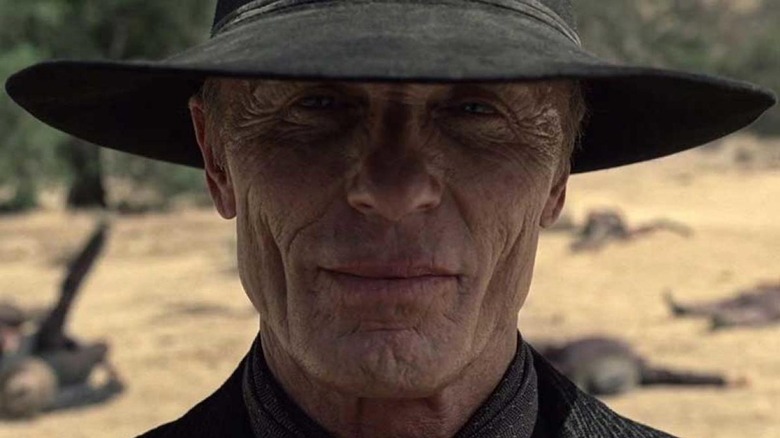
Harris in particular responded well to the question:
"Good question. There must be something I'm doing that I do. I think it's more just the internal knowledge that you've been programmed in a certain way. The Host MIB is not a full fleshed human he's got a certain ... I don't know how to explain it. The others that have played the AI characters more than I think have a better hit on it, but I just kind of assume that I'm artificial, but still have his own feelings or his own needs and things like that. But I'm a hired gun for Hale's character and he's pretty much in season four kind of doing her bidding. So I'm hoping that within that he grows into having some other of his qualities come out, because they all seem to progress. Even if they're Hosts, they seem to escape the limitations of how they've been programmed and start evolving. So I don't know where that will go, but I'm hoping it does. If that makes any sense."
Thompson's role is a little different in that she's playing a personality in her body that is not her own and she had to study Evan Rachel Woods's physical mannerisms when she plays Dolores and try to incorporate that into her work. It's a similar challenge in that she's playing a character that is a version of herself that is not herself. This is starting to sound like "Inception" with all the layers to the reality of performance, but that kind of brain-twister is what you tune into "Westworld" for!
Read this next: 20 Movies About Time Travel Ranked Worst To Best
The post Westworld's Ed Harris on the Difference in Playing a Host vs. a Human appeared first on /Film.
Get a free Armor of Heroes Steam key
Retro tank battles with a modern shine! Featuring 4 player PVP couch co-op, destructible environments, 9 games modes, and more. Get it for free on Steam today!
The post Get a free Armor of Heroes Steam key appeared first on Indie Game Bundles.
Fruits Basket – Prelude – Review: An Incomplete Love Story
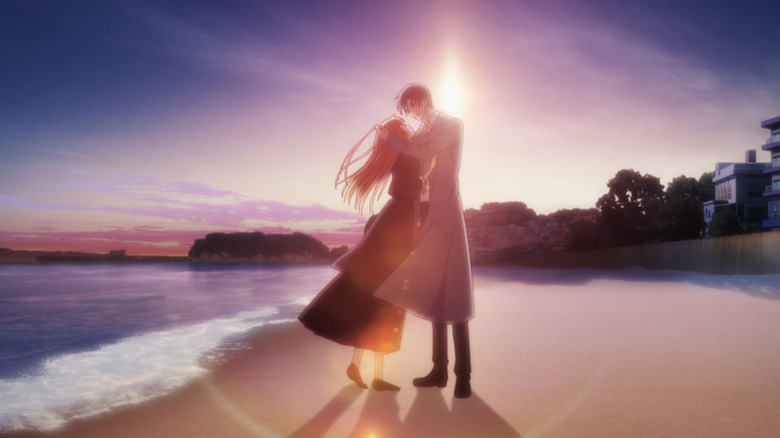
"Fruits Basket" has always been a deceiving anime. What started off as a lighthearted supernatural comedy about boys who transform into animals when hugged by members of the opposite sex (quirky!) slowly revealed itself to be a potent and heartbreaking drama about domestic abuse, generational trauma, social anxiety, depression, and ultimately, that accepting that the unconditional support of an abnormally cheery girl is just as good as therapy.
In the end, even its supernatural elements (which author Natsuki Takaya diminished over the course of the series until they were all but gone) worked as a metaphor for the darker themes that "Fruits Basket" was tackling — the "curse" of never being able to embrace people served as a way of isolating the central Sohma family even more. At the end of the day, "Fruits Basket" is about realizing that we need other people, and that however uncaring the world may be, everything will be all right if you at least have people that care about you.
But what if you were to tell the story of "Fruits Basket" without its supernatural gimmick? You get the love story at the center of "Fruits Basket - Prelude -" a feature film in runtime only. This is a glorified OVA (Original Video Animation) with an accelerated recap of the show and a few cute Kyo-Tohru scenes stuck on to justify the feature film designation — but the thing is, they only serve to make the whole thing weaker. Because buried in between that messy recap and nostalgia-baiting prologue scene is an imperfect adaptation of one of the best things Natsuki Takaya has written.
From A Certain Point Of View
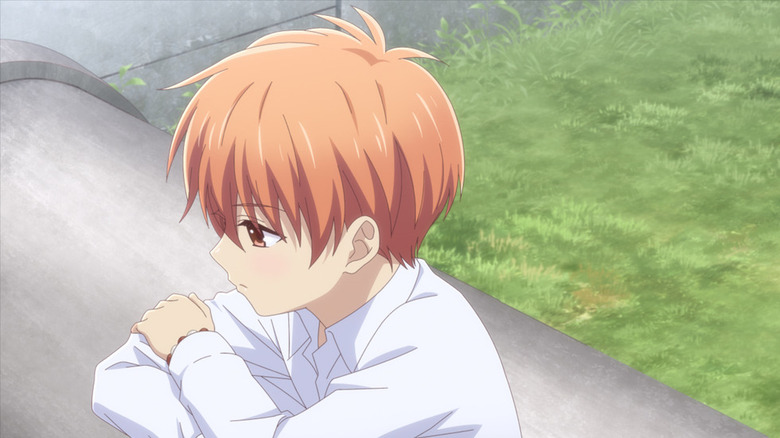
Let's get to the weakest part of "Prelude" first: the 30-minute glorified recap of the series from the point of view of Kyo Sohma. The first half-hour of the "film" features no new footage apart from a short scene showing how Kyo and Kyoko Honda met — which is placed so abruptly at the beginning that it makes for a poor opening — and a few familiar scenes from Kyo's point of view. If this opening recap was purely from his (perfectly angsty) perspective, then there might be some narrative benefit to it, but as it is, it's awkwardly tacked on in the beginning in an attempt to get us back into the emotional space when this story was first told.
The thing is, the "Fruits Basket" team kind of shot themselves in the foot when they chose to cut out Kyoko and Katsuya Honda's love story from the anime series. In the manga, the story is recounted by Kyo in the midst of one of his angstier existential crises (he had realized he was in love with Tohru but had accepted his fate to be locked away forever once he graduated high school, and was using his remaining time to be as close to her as possible), and played nicely as a parallel to Kyo and Tohru's doomed romance, while revealing more about Kyo's troubled past than we could have possibly fathomed. But we've already reached our happy ending. There's no more story left to tell. So "Prelude" has to do a lot of work to try to get us back in that place, and it feels hollow, not in the least because condensing three seasons' worth of poignant, heartrending story into 30 minutes worth of recap (Kyo voice actor Yuma Uchida doing his darndest to get us back into the character's tortured headspace) totally undercuts the emotional impact of the series.
Director Yoshihide Ibata and screenwriter Taku Kishimoto don't do "Prelude" any favors — the opening scene of Kyo and Kyoko meeting is jarring enough, but to insert it only to completely ignore it as a framing device when it was readymade for them? Insane.
The film only starts to feel like it's getting into a comfortable rhythm when we reach the end of the recap and what feels like should've been the natural starting place for the film: Kyo and Tohru visiting Kyoko's grave, looking to the future together, while pondering what past Kyoko really meant in her last words to Kyo. It's tailor-made for you guys! If the film began here, we would've had a nice, reflective start, and a perfect place for Kyo to begin his recounting of Kyoko's story in earnest, but instead of it being from a place of grief, it comes from a place of hope. Then the film could have cut back and forth between Kyo listening to Kyoko's story as a kid, to Kyo recounting the story to Tohru in the present, to Kyoko's story. I should've written this movie.
Because You Cried
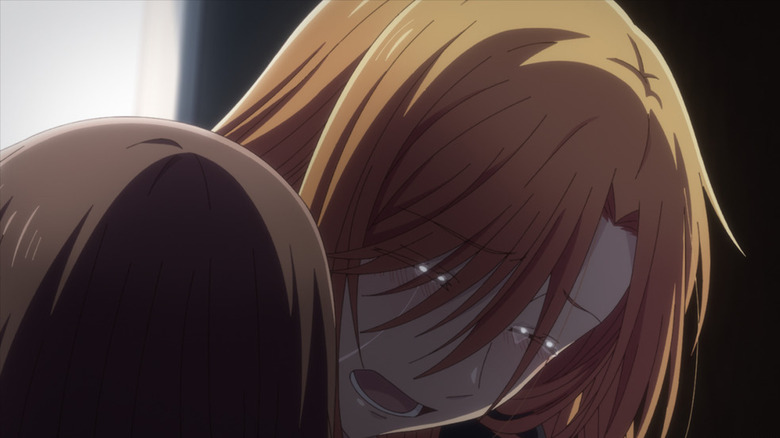
Of course, it's no surprise that the strongest part of "Prelude" is Kyoko's story. When it first appeared in the manga, it was already an anomaly. It was the only story that wasn't supernaturally related, and it completely upended the angelic dead mom trope that so many animes have fallen back on: the one where the mother's beatific presence looms over our tortured protagonist's mind and exists only in nuggets of wisdom and in hazy flashbacks where their hair is always tied in a loose side ponytail. But Kyoko Honda was none of these things. Kyoko Honda was a real person.
It's easy for a person to become a myth, as we see in Tohru's cheery recalling of her mom: she was a legendary gangster, she was a dropout who never graduated middle school, she learned the important things from the streets, where she gained an emotional intelligence and wisdom that still impacted people long after her death. But in "Prelude" we see the heartbreaking reality behind the myth: she was unloved by her parents, she was lonely and lost, and she fell in with a bad crowd that made her see no other options. Until she met Katsuya Honda, a teaching assistant at her middle school who was, yes, eight years older than her. Pearl clutching over the age gap aside (this isn't even the largest age gap in the series), Takaya has never made any bones about how imperfect her characters are. They fall in love with the wrong people, hurt the wrong people, and hurt themselves. "Fruits Basket" has long been about how anyone is deserving of love, but that love is never glorified or glamorized. It just is. And Kyoko and Katsuya's romance just is, even as Ibata portrays it exclusively in swooning magic hour lighting. And when Katsuya dies, Kyoko's all-consuming grief and brief moment of suicidal ideation feel so raw and real that it does away with any thoughts of "romanticizing" an age gap (if you're going to wring your hands about how the film glorifies age gaps, just stop).
I've often thought that Kyoko's story is what Natsuki Takaya wanted to write if she wasn't beholden to the supernatural gimmick that got "Fruits Basket" sold to publishers — a complicated, discomfiting love story that turns into an incredible examination of grief. It felt real and grounded in the way that the rest of "Fruits Basket" wasn't; like a snapshot of a life in Japan that was all too mundane and all too common. But in "Prelude," it doesn't feel common. Props to Ibata and Kishimoto: they make a loyal adaptation of the story, which is basically ripped from the manga pages — but then again, it's hard to improve upon it. If only the rest of the film lived up to it.
/Film Rating: 5 out of 10
Read this next: The 10 Best Anime Moments Of 2021
The post Fruits Basket - Prelude - Review: An Incomplete Love Story appeared first on /Film.
Why Chinese Researchers Want to Destroy Starlink Satellites
In April 2022, a Chinese researcher published a paper declaring that the Starlink Satellite constellation threatens Chinese national security.
Horrifying Underwater Scenes That'll Make You Swear Off Swimming Forever
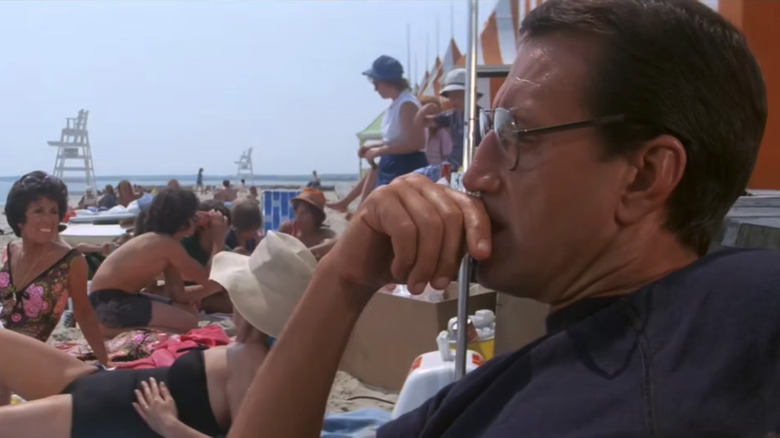
Aquatic horror has a special place in the seasonal pantheon, and that's firmly planted in the hot summer months. What good is beach season, after all, if you can't scare the wits out of would-be swimmers?
There are many, many, many wonderful entries into this very specific niche, but not all terrifying underwater scenes come from horror movies. After all, the very notion of what scares us is purely subjective. So while the opening of "Jaws" may make some swear off the beaches forever, others may be horrified by Nemo's kidnapping in "Finding Nemo," or chilled to the bone by the realistic terror of the ocean igniting in "Dunkirk." Maybe certain moments in "The Abyss" make your blood run cold, or it's the gnashing maws of super-smart sharks in "Deep Blue Sea" that sets you on edge.
No matter your preference, with 30 nightmarish scenes to choose from there's something here to make anyone swear off swimming forever.
The Flare In 47 Meters Down (2017)
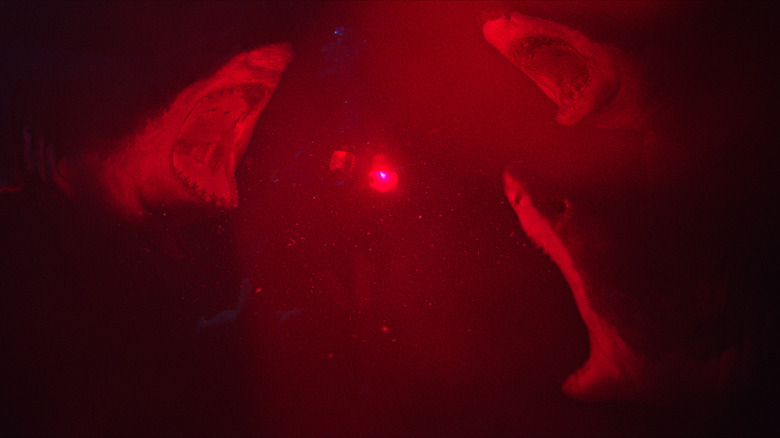
After the cable holding their diving cage snaps and drops sisters Lisa (Mandy Moore) and Kate (Claire Holt) the titular "47 Meters Down," the duo must find a way to return to the water's surface without becoming shark snacks or developing a case of "the bends," a decompression sickness that is caused by rapid changes in pressure while scuba diving.
Armed with a handful of flares to signal for safety, the two swim up to the 20-meter mark, where they are instructed by Captain Taylor (Matthew Modine) to wait for five minutes, allowing the nitrogen in their bloodstream to decompress in order to avoid the bends. Waiting means they're an easy target for sharks, but not waiting runs the risk of fatal decompression sickness. The two are essentially underwater sitting ducks, forced to reject the survivor impulse to swim away.
When one of the flares goes out, Kate goes to light a second one, accidentally dropping it. After scrambling to light their third and final flare, the water around them is illuminated to reveal three sharks surrounding them. The moment makes for a perfect jump scare, and a reminder that danger may be closer than imagined. (BJ Colangelo)
Walking The Plank In Alligator (1980)
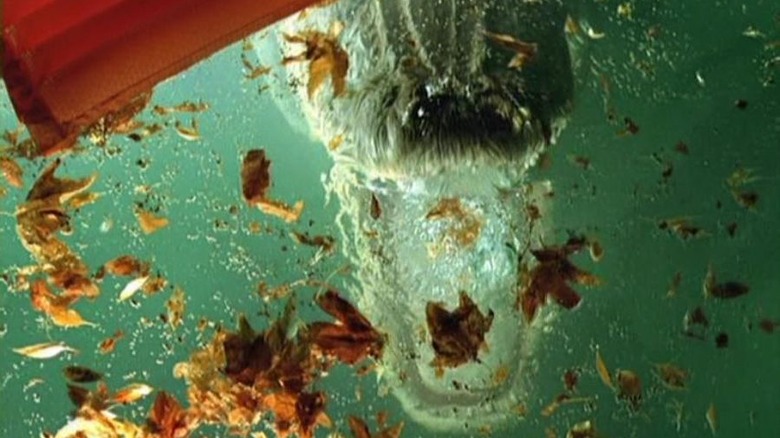
Sure, "Jaws" may have provoked mass hysteria when it comes to the apex predators of the ocean, but "Alligator" brought a fear of gigantic reptiles to our own backyards. More aptly, this film instilled a generational paranoia about checking your pool for semi-aquatic carnivores before carelessly jumping in.
Unaware of the gigantic gator that's currently stalking the city of Chicago, a group of kids decide to play pirate in the backyard. They take a hostage to walk the plank (i.e. jump off the diving board into an in-ground pool), forcing the young kid to plummet to certain doom. As mom switches the pool lights on, it's revealed that the monstrous alligator has been waiting for an unwitting kid to dive right into its gaping maw, and boy, does it get what it waited for. As the chlorine water turns deep red, the little pirates run for their mother. These kids are going to have to pay a fortune in future therapy bills, and mom is going to have to pay a pretty penny to have the pool cleaned.
Take this as a warning to watch out for the common pool gator. (Natalia Keogan)
The Barracuda Attack In Finding Nemo (2003)
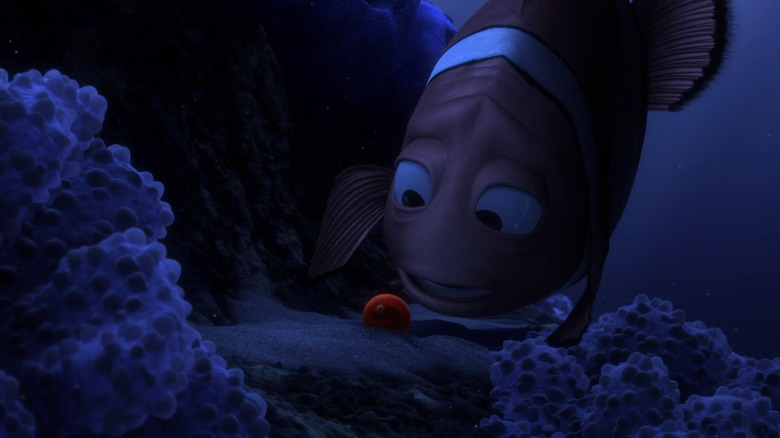
Pixar has never been afraid of playing with an audience's emotions; their films will have you uproariously laughing one second and sobbing like a baby the next. That emotional whiplash is in full effect in the opening minutes of their 2003 masterpiece "Finding Nemo." You have this lovely scene between Marlin (Albert Brooks) and Coral (Elizabeth Perkins), eagerly anticipating becoming parents for the first time with a mountain of eggs waiting to be hatched. Then ... a barracuda shows up.
The expression of utter terror that paints Coral's face burns itself on your brain, and then she looks down at all of her eggs beneath her. All you can feel is pain because you know exactly what is going to happen — neither she nor any of those baby fish is not going to make it. This is heavy stuff to start a film ostensibly made for children, but Andrew Stanton and the folks at Pixar know that kids not only can handle wrenching material like this, but that they should.
This is how Pixar has been able to bury themselves inside the hearts of millions for decades. Pure emotional honesty (with a side of gut-wrenching dread) is all you need. (Mike Shutt)
The Bottom Of The Well In The Ring (2002)
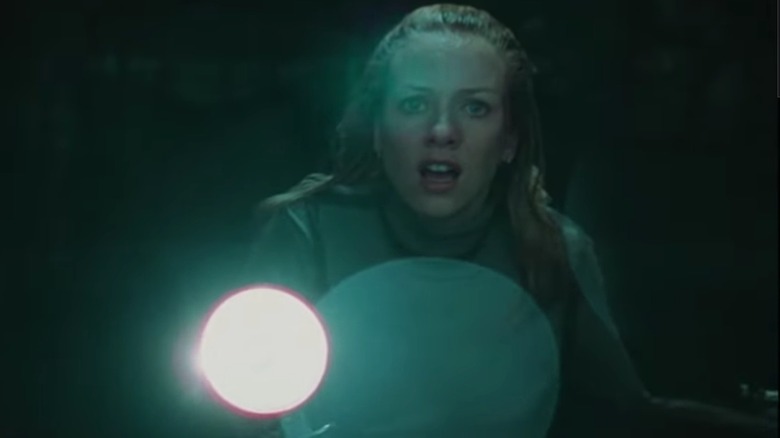
Wells: they're meant to be a source of life, a place from which good health springs forth. Only, it's hard to see them as anything but death traps in a post-"The Ring" world. Gore Verbinski's adaptation of the J-horror film "Ringu" taunts audiences with images of a terrifying well from the beginning, but investigative journalist Rachel Keller (Naomi Watts) finally gets an up-close look at the haunting set piece in the movie's climax.
Rachel is looking for signs of the malevolent spirit Samara when a swarm of insects knocks her into the well. At the bottom of the cavernous structure, she finds herself in cold, dank-looking waist-high water. This would be a perfect moment for a jump scare, but "The Ring" works because it values its story as much as its frights. Instead, viewers see Rachel make a disturbing discovery: she finds the severed fingernails of a child, which Samara lost while attempting to climb out of the well her adoptive mother threw her in.
Then comes the jump scare, as Rachel touches what turns out to be a wave of long, black hair, and Samara pulls her into the depths of her mind. (Valerie Ettenhofer)
Alex Kintner's Death In Jaws (1975)
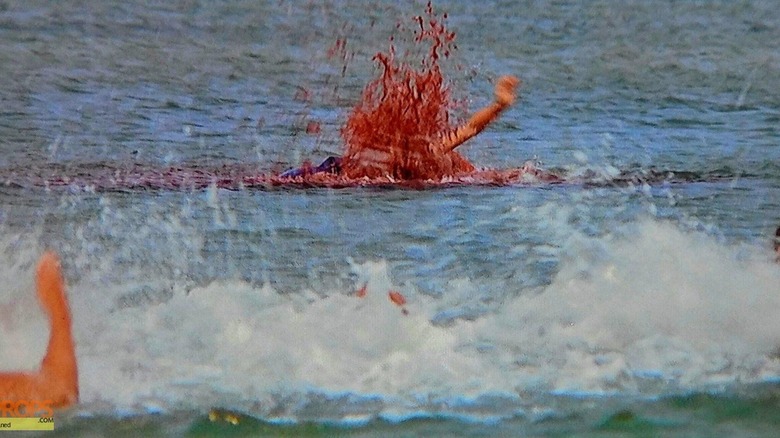
In 1975, "Jaws" set the gold standard for aquatic horror movies with its hungry shark antagonist. Perhaps the most upsetting of the shark's victims is the young Alex Kintner, who meets a violent, untimely end in front of a crowd of horrified beachgoers -- including his own helpless mother.
Alex happily makes his way to the sea after begging his mother for just a little more time in the water, unaware that his life is about to come to a horrible, graphic end at the hands -- er, teeth -- of the movie's villain. While nothing seems amiss at first, it becomes clear that things are about to take a turn for the absolute worst as families and friends splash around and socialize, completely unaware of the danger lurking in the deep. Shortly after the tell-tale theme alerts the audience to imminent doom, poor little Alex becomes an afternoon snack as he's snapped up by the shark.
It would have been scary enough to just imply that Alex was killed by the shark, but director Steven Spielberg upped the ante by having the boy's gruesome death play out on screen, making it all the more tragic and upsetting. (Deshawn Thomas)
The Rising Water In What Lies Beneath (2000)
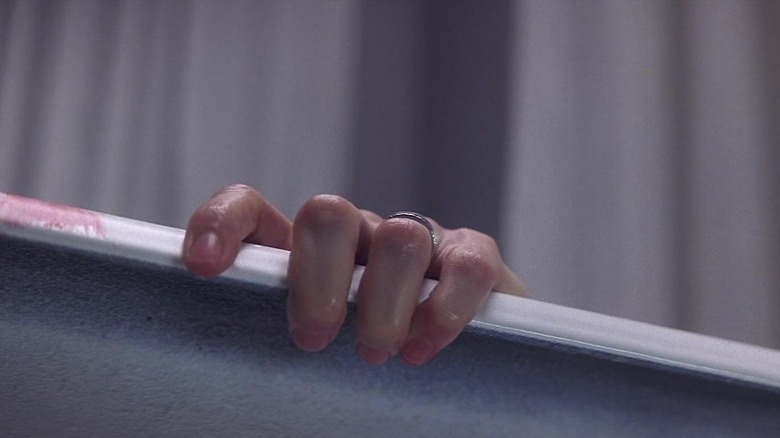
In Robert Zemeckis' haunted house horror film "What Lies Beneath," the marriage of Claire (Michelle Pfieffer) and Norman (Harrison Ford) is under some serious supernatural strain. After multiple weird events and an attempt at contacting any potential ghosts, Claire becomes convinced that the couple's house is haunted. She eventually discovers that the haunting has something very personal to do with her husband, and the couple's shaky marriage turns murderous when he tries to drown her in the bathtub. In a movie with mostly supernatural scares, the most horrifying moment comes at the hands of a human.
Norman drugs Claire so that she's paralyzed and puts her in the bathtub, turning on the faucet and stopping the drain. The camera follows the height of the water as it rises, steadily going above her mouth and then her nose. She can't move to get out, though she desperately tries to turn off the water with tiny movements of her foot. It's a terrifying climax in an incredibly tense film about infidelity and broken trust, and it's absolutely impossible to forget. (Danielle Ryan)
Paul Gets Disarmed In Underwater (2020)
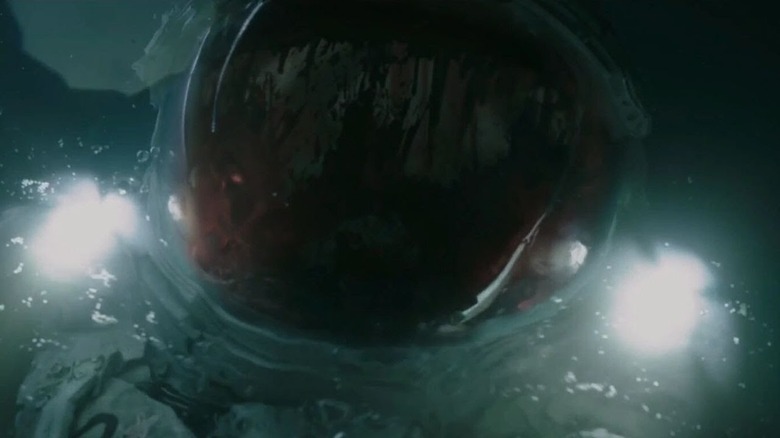
It's a real shame that more people didn't pay attention to "Underwater" when it hit theaters in 2020 as it was an effective horror flick set, as the title implies, underwater. Sure, one could easily drown in a movie set thousands of feet under the sea, but Paul (T.J. Miller) meets a far more grim fate in the film.
Early in the crew's attempted escape after catastrophe rocks the underwater facility, the survivors are trying to make their way to safety through a precarious route. Paul is the last of the bunch to go through the mess. Just when we think he's safe, an unseen entity grabs his arm and pulls him back under. Even though they manage to get his helmet back on, this creature literally rips his arm off, leaving his helmet to fill with blood.
Not only does Paul die mere moments after believing he's safe, but his death serves as a terrifying omen for everyone else who made it through: the water is the least of their concerns. (Ryan Scott)
Looters Get Chomped In Crawl (2019)
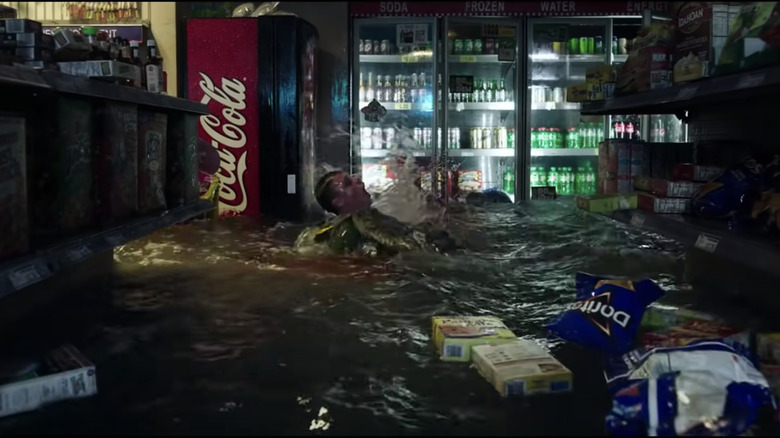
Alexandre Aja arrived on the scene with extreme horror movies like "High Tension" and the remake of "The Hills Have Eyes," but pivoted towards a fun, mildly campy animals-attack aquatic horror movie with the Sam Raimi-produced feature "Crawl." The film follows a daughter desperately trying to save her father in the middle of a hurricane, where thanks to flooding, very hungry alligators have begun to swim into living rooms, bathrooms, basements, and gas station mini-marts.
In one of the film's most horrifying moments, a group of meddling kids hellbent on looting an evacuated convenience store meet their match when an alligator hunts them down for a snack of its own. The troublemaking trio is brutally devoured by a gator, with one victim slammed against the building's glass paneling while his friend helplessly watches. As the water levels rise, the gore-hungry gators have the upper hand and the final looter meets his demise inside the flooded store, surrounded by floating bags of Cool Ranch Doritos as a painful reminder of what an idiotic risk they all took by looting, when they should have just evacuated the area. (BJ Colangelo)
Nancy's Attack In The Shallows (2016)
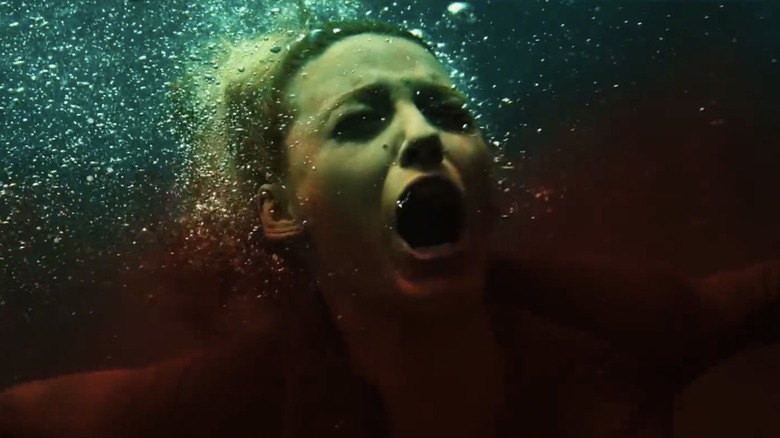
Blake Lively might not be a conventional scream queen, but she certainly imbues every moment of "The Shallows" with the utmost underwater dread. Playing a surfer named Nancy, Lively is tasked with carrying most of the film on her own, her co-stars primarily being an injured seagull aptly named Steven Seagull and the 23-foot great white shark who has bitten them both.
Arriving in Mexico and ready for a surf-fueled vacation, Nancy wastes no time traveling to a secluded shore perfect for catching waves. After being led to the beach by some locals, she jumps right into the water with her surfboard. As an enormous wave begins to curl behind her, the shadowy visage of an enormous shark is visible. In a matter of seconds, Nancy is thrown from her board by a gargantuan force -- one that takes a considerable chomp out of her leg while she's submerged in the water. Seeing a bloated whale carcass nearby, she swims to safety. Her hands dig into the soft flesh of the decaying corpse as she pulls herself out of the water. Thankfully, her gross gamble pays off as she narrowly escapes the shark's jaws ... at least, for now. (Natalia Keogan)
The Ocean's Aflame In Dunkirk (2017)
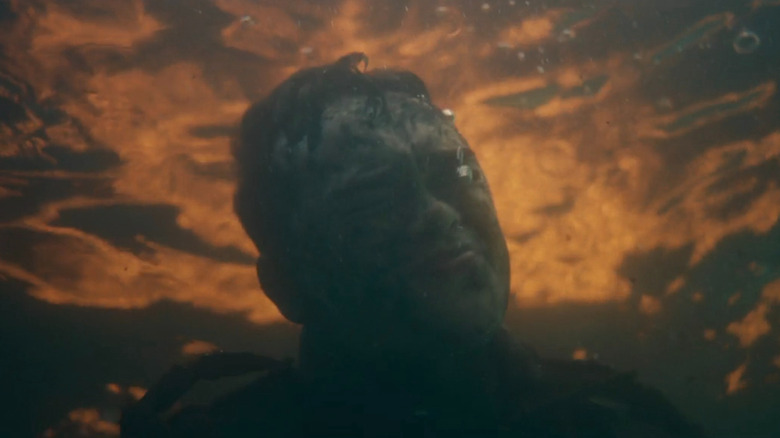
Whenever people discuss the worst ways they could die, there is always some debate about which is worse: being burned alive or drowning. Well, in Christopher Nolan's "Dunkirk," one character has to answer this question in real-time. The boat carrying a group of soldiers escaping from the titular beach capsizes in the Strait of Dover. Not only do all the men end up in the water, but the attack causes an oil spillage to be lit aflame. One unlucky soldier ends up actually having to choose between the two horrible deaths, as he gets trapped underneath the sea of fire. Ultimately, the strain of holding his breath becomes too much, and he chooses to burn.
"Dunkirk" looks to be an almost entirely experiential time at the cinema. Nolan is not all that concerned with character or story here, just putting you in the terror of that moment in history. This man who dies is a character we do not know, and because of his namelessness, we put ourselves in his place. His dilemma and pain are ours as well, making the scene all the more terrifying and tragic. (Mike Shutt)
Camp Attack In Piranha (1978)
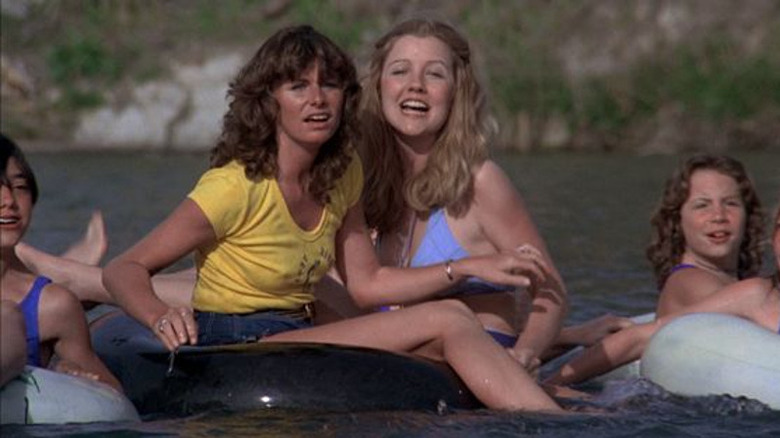
Joe Dante's solo directorial debut has all the trappings of a late-70s B-movie, from topless women in peril to genetically engineered creatures. In this case, it's a batch of especially rabid piranhas that were designed during the Vietnam war as part of a program called Operation: Razorteeth. Like all of Dantes' greatest hits, "Piranha" likes to throw some comedy in with its horror, but when the razor-toothed fish prey on unwitting summer campers, the movie gets truly gory.
The scene comes around the film's climax when the creatures have been unleashed in a local river. They come upon a group of young campers and their counselors, who are lounging around in inner tubes and on paddleboats. Before they know it, they're fish food. The sequence goes on and on, with the piranhas chomping at the behinds and limbs of a bunch of screaming kids. Suzie (Shannon Collins), a camper who had been lounging on the shore, is their only hope, but she ends up no match for the superpowered fish, who drag counselor Betsy (Belinda Balaski) down to the depths in front of her eyes. (Valerie Ettenhofer)
Nancy Takes A Bath In A Nightmare On Elm Street (1984)
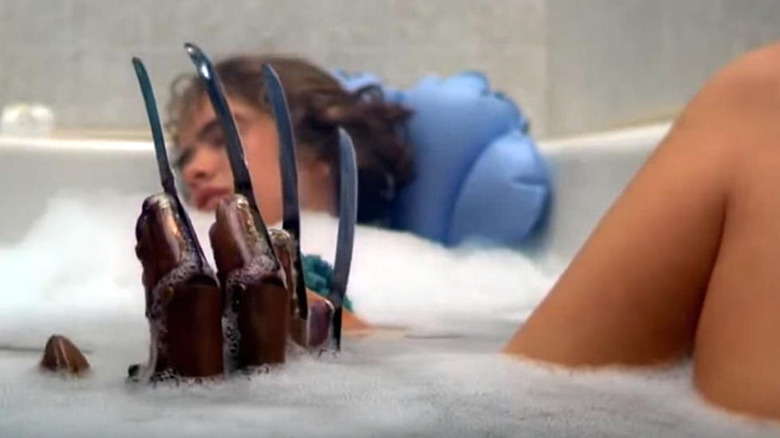
It's easy to evoke terror when it comes to larger bodies of water like rivers, lakes, and oceans. It's another thing altogether to make the bathtub, a space for cleanliness and relaxation, the backdrop for horror. "A Nightmare on Elm Street" managed to do just that with the scene where the tranquility of Nancy's (Heather Langenkamp) bubble bath is interrupted by the unwelcome presence of none other than Freddy Krueger.
As Nancy drifts off to sleep while soaking in the tub, which is already pretty dangerous on its own, Krueger's talon-gloved hand reaches up between the sleeping girl's legs, providing one of the most stomach churning visuals in horror movie history. Worse still is when the monster pulls Nancy beneath the water into an unexpected abyss. The surreality of the shallow bathtub becoming a sea of doom coupled with the nauseating wrongness of Krueger's presence makes this scene particularly frightening. Of course, it probably goes without saying that the idea of a surprise bathtime visit from a sadistic, supernatural pervert is enough to terrify most people, so it's no surprise that the iconic bathtub scene makes the list. (Deshawn Thomas)
Eli Stands Up To Bullies In Let The Right One In (2008)
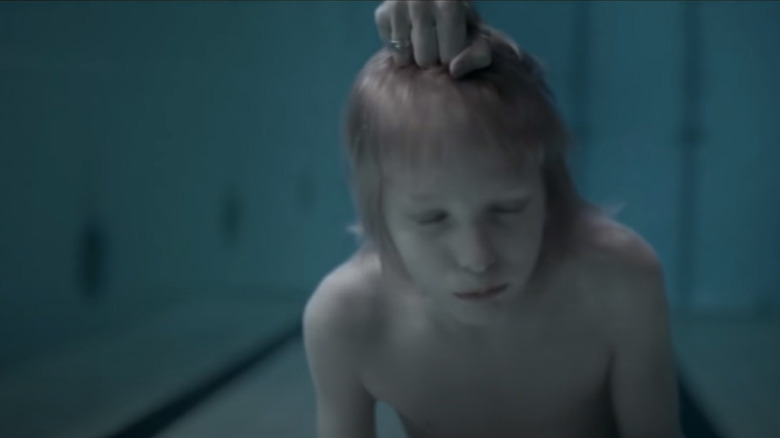
Sometimes love hurts ... everyone else. In the Swedish vampire film "Let the Right One In," a vampire who looks like a young girl named Eli befriends a lonely boy named Oskar, and that friendship blossoms into young love. Eli, played by Lina Leandersson, has endured many years of trauma hiding out as a child vampire, moving from place to place before people notice the bodies stacking up. Oskar, played by Kåre Hedebrant, is a shy child who gets bullied by the other kids quite a bit, but he finally sticks up for himself by throwing a rock at one of them and splitting his ear.
The bullies swear revenge and lure Oskar to a swimming pool, where the bully with the split ear proceeds to hold Oskar underwater. The camera stays with Oskar, held down by the bully's arm, as Eli unleashes havoc on Oskar's tormentors. A pair of feet kick as they go down the pool's length, held aloft by some unnatural force, and the sounds of screams are muffled by the water. By the time a severed head falls into the pool, it's clear that Eli's true nature has revealed itself. (Danielle Ryan)
David Dunn Almost Drowns In Unbreakable (2000)
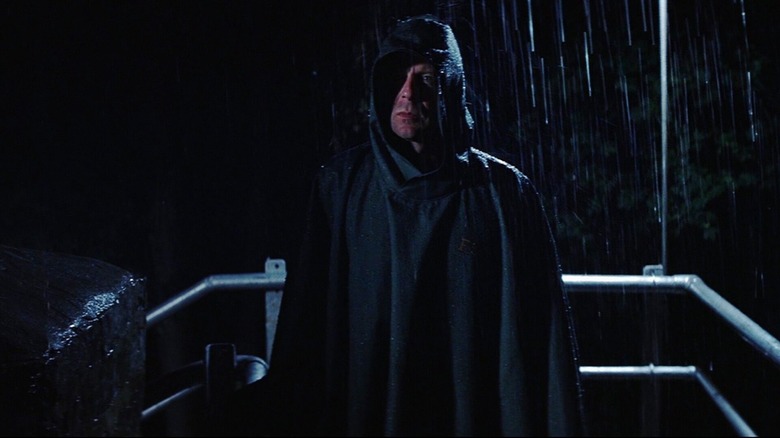
M. Night Shyamalan followed up his all-time great thriller "The Sixth Sense" with a very different movie in "Unbreakable," which sees Bruce Willis playing a man named David Dunn who discovers that he is seemingly invincible. But every superhero has a weakness, and when Dunn discovers his in the film, it's terrifying in its simplicity.
It takes a rock from a far away planet that is in limited supply to hurt Superman. Dunn, meanwhile, nearly drowns in a pool, something so common to suburban life. The scene, as it unfolds, shows a man reckoning with his newfound powers and discovering that he is not indestructible. Something as simple as water can take him out, and given that he survives a trainwreck earlier in the film, we simply don't see this coming. The scene manages to terrify by bringing this hero right down to Earth. Any of us can fall victim to something like this, even perhaps the strongest man in the history of humanity. (Ryan Scott)
Abandoned In Open Water (2003)
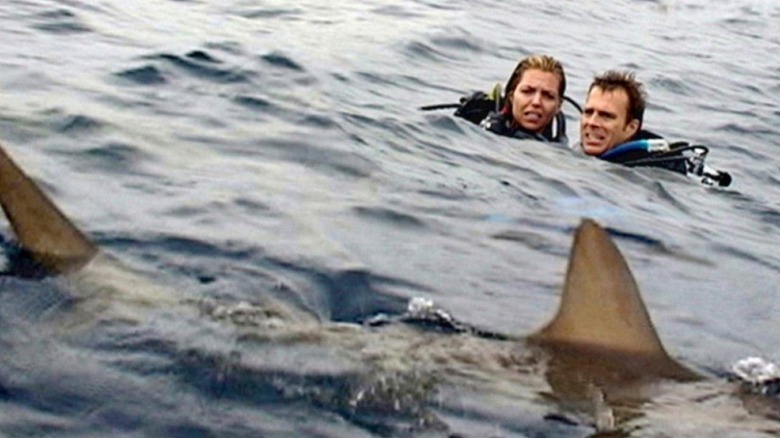
Shark movies as a whole have been justly criticized for promoting violent hate of these impressive creatures, fueling a cruel poaching culture that has culled a vital component of the ocean's ecosystem. While similarly rooted in the innate fear humans have of finding themselves in a shark-infested sea, "Open Water" decided to take a more realistic approach.
Based on the real-life tragedy of Tom and Eileen Lonergan, a couple from Texas that was accidentally abandoned by their boat on a scuba diving trip in Australia, "Open Water" features real sharks, eschewing the industry standard of using mechanical or CGI renderings. However, the film first builds dread without showing any aquatic life at all.
After deciding to visit the Caribbean on a relaxing vacation, American couple Susan (Blanchard Ryan) and Daniel (Daniel Travis) decide to embark on a group scuba diving trip. But they find themselves straying from the rest of the group, and when they resurface, they can't find anyone ... or the boat they rode out on. As it turns out, the boat's crew conducted an incorrect head count, so they believed all the passengers were back on board. Clearly, they were very wrong. (Natalia Keogan)
Nemo Gets Taken In Finding Nemo (2003)
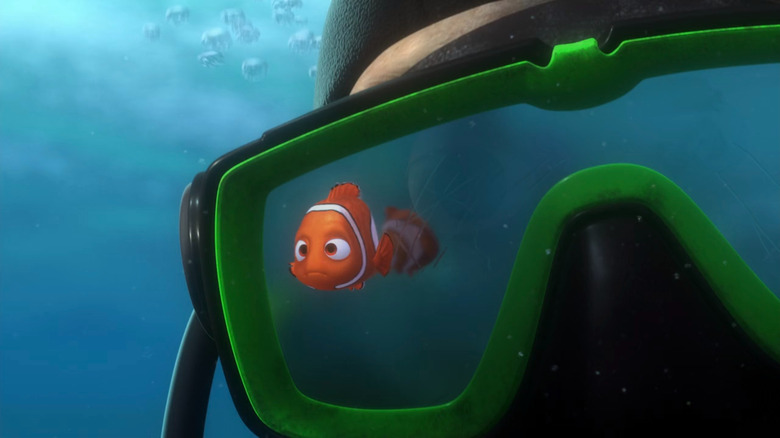
In the opening scene of "Finding Nemo," Marlin ends up getting knocked out and wakes up to find his family massacred. This is not the case in the scene where his sole surviving kid Nemo ends up getting fishnapped by some divers after he defiantly swims out to a boat. Marlin sees this play out right in front of his eyes and is utterly helpless to do anything about it.
From Marlin's perspective, this is entirely his fault. His overprotective nature caused Nemo to rebel harder than he ever would had Marlin been cognizant of Nemo's want for a little breathing room. Few things would be more traumatizing to a parent than seeing your child snatched out from under you, and while all the kids are probably terrified at the gigantic human that enters the frame, the parents in the audience can only see themselves in that situation and feel scared for their own kids. Marlin encounters plenty of scary things along his journey to find his son, but none measure up to that initial loss. (Mike Shutt)
The Abyssal Trench In 47 Meters Down (2017)
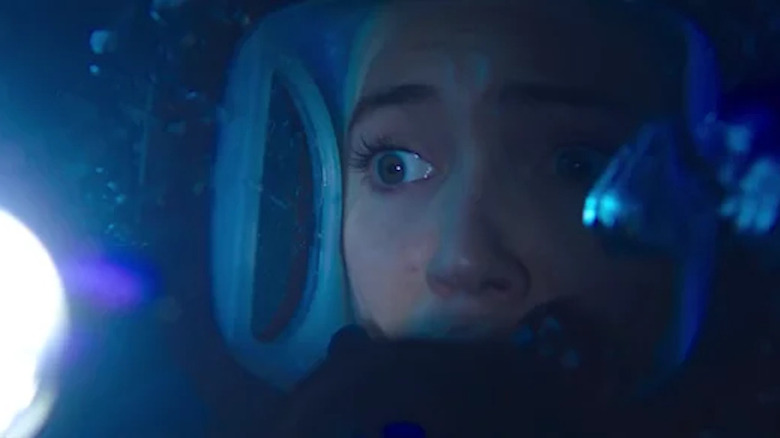
The silent horror of the abyssal trench scene in "47 Meters Down" proves that, sometimes, nothing is scarier than ... well, nothing. While the 2017 horror film lacked a lot of things that can make you like a movie, such as interesting and likable characters, it makes up for this by placing these bland, generic characters in increasingly terrifying underwater situations.
After two sisters go cage diving in shark-infested waters only for the rope tethering them to safety to collapse and leave them stranded 47 meters below the surface of the ocean, they must contend with sharks, a dwindling oxygen supply, and their uncertain fate in order to survive. If that isn't awful enough, one of the sisters is forced to leave the relative safety of the cage in order to increase their chances of being rescued. Eventually, she finds herself in an endless nothing. Even though she's aware of the sharks that are undoubtedly swimming somewhere nearby, she can't see anything except the vast, dark body of water that engulfs her.
The visuals of the scene drive the point home that she's nothing more than a speck in the watery void, and the impact is nothing short of visceral terror. (Deshawn Thomas)
Setting A Trap In It Follows (2015)
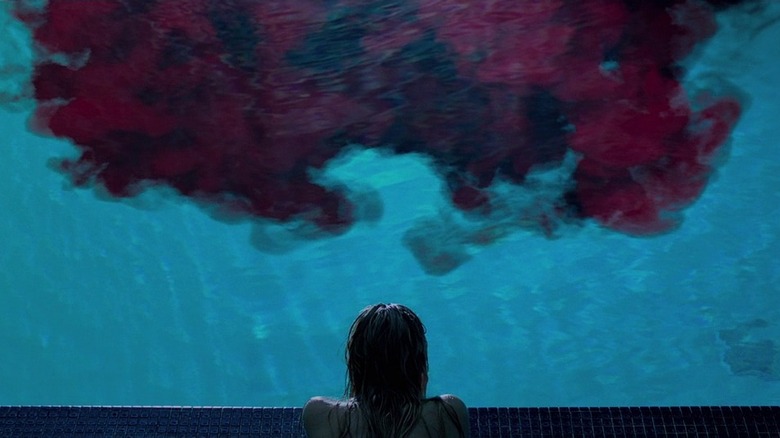
"It Follows," from writer and director David Robert Mitchell, is essentially a slasher that works kind of like an STD. The unnamed entity only follows one person at a time, slowly walking towards them until ultimately killing them. They can save themselves by passing the curse onto someone else by having sex with them, but if that person dies, the curse reverts back on down the line. Maika Monroe plays a teenager named Jay who catches the curse and sees someone slowly walking towards her each day, no matter where she runs. The entity takes many forms, often from the person's life, but only those touched by the curse can see them.
Jay and her friends make a plan to kill the entity by luring it into a swimming pool using Jay as bait and then filling the pool with plugged-in electronics. The entity shows up in the form of her dead father and starts throwing the electronics right at Jay in the center of the pool. The camera goes above and below the water as she and her friends try to contend with the invisible monster, and soon the pool is red with blood. (Danielle Ryan)
The Opening Scene Of Jaws (1975)
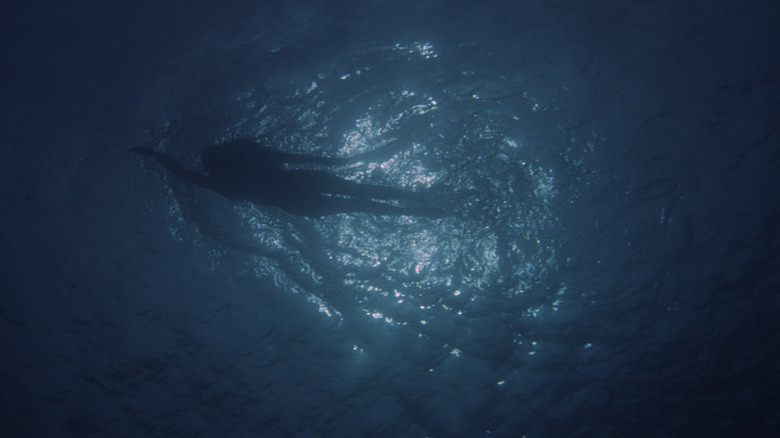
"Jaws" is not just one of the best creature features ever made, but one of the best movies of all time. It invented the summer blockbuster and cemented Steven Spielberg as a master cinematic storyteller. The movie doesn't take long to make that evident as we focus on a couple of young people having fun at the beach, with the unsuspecting Chrissie (Susan Backlinie) inviting a young man to go skinny dipping. Unfortunately for her, there is something lurking beneath the water that we never really get to see.
This poor woman is dragged under the water while having some relatively innocent fun. It's made all the more horrifying because we don't see the looming threat, but beyond that, Spielberg makes it crystal clear that if someone is going to die mere minutes into the film, nobody is safe. The audience, as a result, is on edge for the rest of the movie. It also made lots of people think twice before setting foot in a large body of water, cementing this as a masterstroke of an opening scene. (Ryan Scott)
Death By Drainage Pipe In The Final Destination (2009)
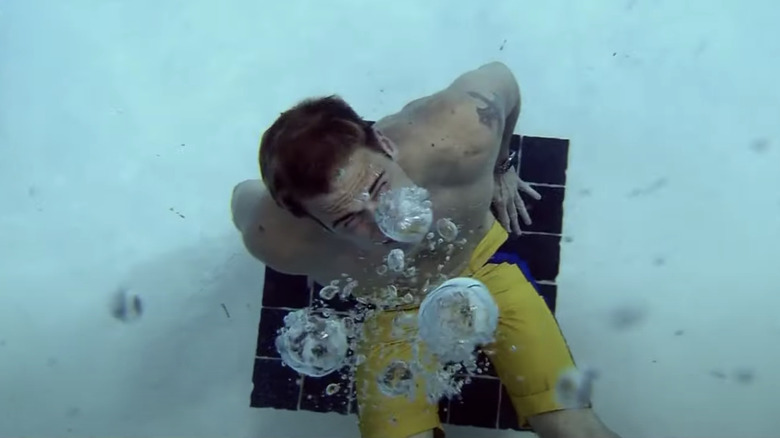
The "Final Destination" franchise is home to some of the most inventive and interesting kills in all of horror history as if someone mainlined the entirety of "1000 Ways To Die" and turned it into a slasher film. In the fourth installment, "The Final Destination," audiences are finally given an underwater kill, continuing to prove that Death has one sick sense of humor.
Taking a page out of Chuck Palahniuk's book of short stories, "Haunted," and a common urban legend, Hunt Wynorski (Nick Zano) ignores his friends' warnings that death is coming for him and dives to the bottom of the community pool to retrieve a lucky coin. Unaware that the pool's drainage pipe has been activated by the Rube Goldberg-appreciating Death, the suction of the drain grabs hold of Hunt, and keeps him submerged under water. In the world's suckiest coincidence, the suction vent perfectly aligns with Hunt's anus, and despite his attempts to swim away, he is eventually disemboweled, with his innards exploding through the pipes and onto the pool's surface. The audience knows his death is imminent, which makes watching him struggle to break free all the more harrowing. (BJ Colangelo)
Mad Dash For The Boat In Crawl (2019)
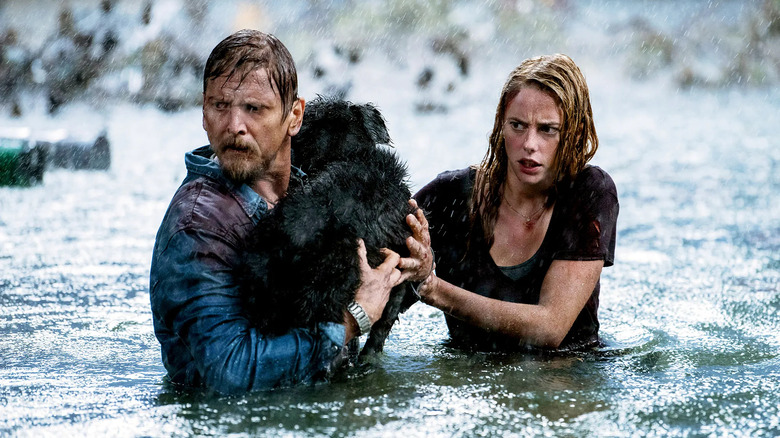
Animals in horror films typically abide by two simple labels: the consumers and the consumed. Oftentimes, horror movies will feature a cute, lovable little creature only to have it gobbled up by a fearsome predator. In Alexandre Aja's 2019 film "Crawl," the film's protagonists do just about everything in their power to keep the family pooch from being devoured by a feeding frenzy of American alligators.
After a Category 5 hurricane besieges a Florida community, University of Florida swimmer Haley (Kaya Scodelario) eschews evacuation mandates to check on her dad Dave (Barry Pepper) and make sure he's not foolishly sticking around. Unfortunately, her dad's house has been overtaken by floodwaters — and a gaggle of gators that have found their way inside. This makes Dave and his loyal dog's escape all but impossible, but Haley's here to help. After a harrowing fight for survival (and plenty of gator-related injuries), Haley, Dave, and the doggie escape the house and see a motorboat in the distance. Using her swimming talents, Haley makes a break for it, narrowly missing the jaws of several alligators during the most impressive race of her life. Thankfully, it looks like this dog — and its human companions — will live to see another day. (Deshawn Thomas)
Nightmares On The Ocean Floor In Pirates Of The Caribbean (2003)
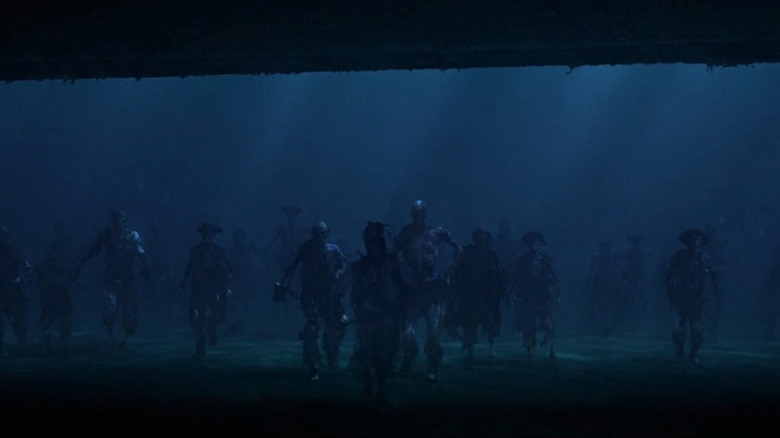
Something a lot of filmmakers forget when creating these giant action blockbusters is how effective using horror elements can be in creating tension for the big set pieces. Steven Spielberg knows this better than anyone. Just look at "Jaws," "Jurassic Park," or "War of the Worlds." Another director fully willing to freak his audience out in the service of big-budget popcorn entertainment is Gore Verbinski. Obviously, his big breakout was the horror film "The Ring," so when he came on to direct Disney's "Pirates of the Caribbean: The Curse of the Black Pearl," it was only natural to bring some of that horror with him.
This is best utilized in the scene where all of the cursed, undead pirates covertly attack a ship by walking under the water. For one, this scene heeds to Alfred Hitchcock's rule of suspense. Show the audience what is about to happen without letting the character's know. Beyond that, the uneasy image of a group of skeletons forcefully walking along the ocean floor would be frightening enough on its own, as it's something never seen before. (Mike Shutt)
Michel Resurfaces In Les Diaboliques (1955)
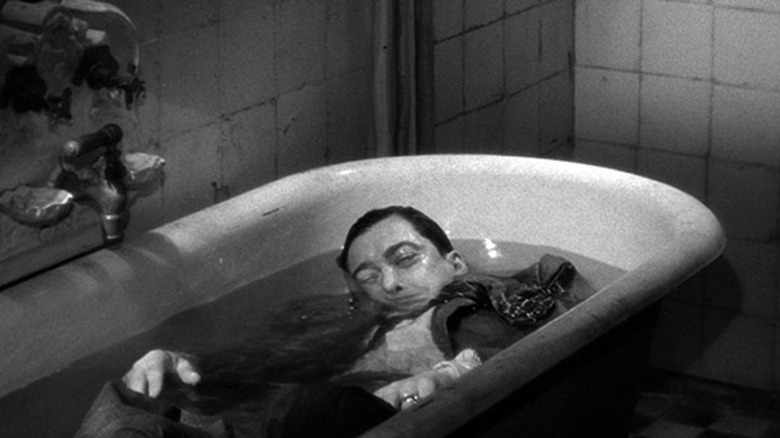
Though it doesn't always get the credit it deserves, the 1955 French film "Les Diaboliques" is the blueprint for many of the horror films that have made waves since. Henri-Georges Clouzot's twisty, formative thriller is especially effective in its use of water as a method of provoking fear. In it, a cruel schoolteacher named Michel's (Paul Meurisse) meek wife Christina (Véra Clouzot) and mistress Nicole (Simone Signoret) plot to kill him, though all is not as it seems.
Water haunts "Les Diaboliques" throughout its runtime, as the two women dispose of Michel's body in a pool but are later startled to find his corpse never resurfaced. The film's most primally scary moment, though, happens in an even smaller body of water: a bathtub. After being subjected to what seems to be a relentless haunting, Christina sees something her heart can't take. It's Michel's waterlogged corpse, rising uncannily from her murky, water-filled bathtub. It's an indelible image that was surely terrifying in the '50s -- and still shocks in 2022. (Valerie Ettenhofer)
Burke Loses His Head In Lake Placid (1999)
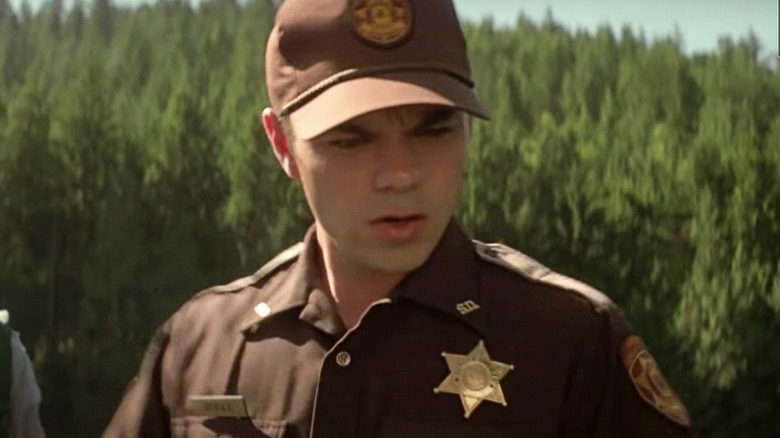
"Lake Placid" is a movie that offers mostly cheap thrills and, perhaps more than anything else, is known for helping to revitalize Betty White's career. But the movie does offer at least one truly remarkable moment in its runtime, and that is the death of Burke, played by Jed Rees.
During a particularly tense sequence, several of the film's potential victims are submerged in the lake with the gigantic crocodile seemingly ready to emerge at any moment to rip one of them underwater in "Jaws"-like fashion. One by one, the divers are plucked out of the water and the audience is certain that one of them is going to be pulled under. In a pretty brilliant and brutal bit of subverting expectations, as Burke is readying the boat so they can leave, safely on board, the beast leaps out of the water and bites his head clean off. It's something few people saw coming, which is what makes it so effectively scary. (Ryan Scott)
The Tunnel Flood Escape In Deep Blue Sea (1999)
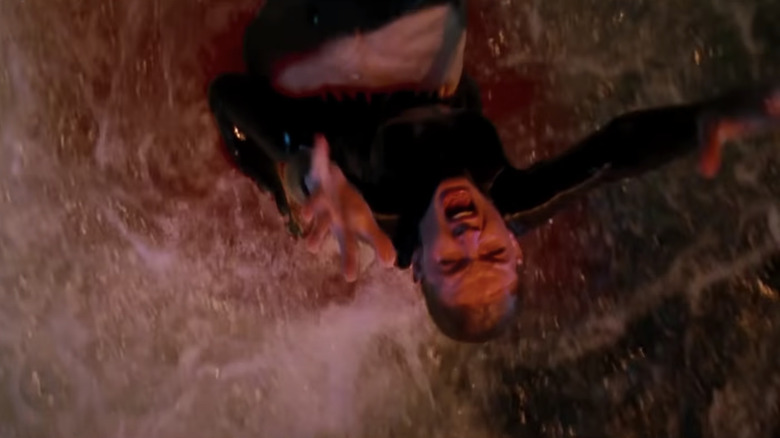
If you haven't yet learned from reading this list, the water is a dangerous place. That's why, in "Deep Blue Sea," the cast of characters desperately try to climb six stories up an elevator shaft to escape their flooded, underwater research facility. The scene is a clear homage to 1972's "The Poseidon Adventure," but with shark-infested waters, the stakes are even higher.
As the team tries to climb to safety, explosions throughout the facility cause the ladder to break, forcing them all to play a life-or-death game of "don't fall off the monkey bars." Unfortunately, marine biologist Janice Higgins loses her grip and falls into the water, as the rest of the team watches helplessly. When it's assumed that Janice has become shark food, the impossible happens: a shark jumps out of the water, with Janice in its mouth, resembling the worst possible outcome of a shark show at SeaWorld. Shark wrangler Carter Blake tries in vain to pull Janice to safety -- but alas, her fate is to flail in the maw of a shark.(BJ Colangelo)
A Temporary Drowning In The Abyss (1989)
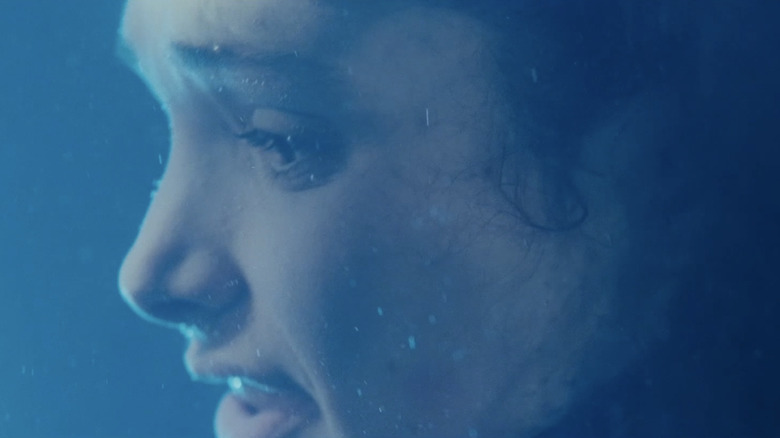
James Cameron loves his water. Something about the unknown in the depths of the ocean keeps drawing him back to the water time and time again. Even his upcoming "Avatar" sequel will be heavily water-based.
The first time Cameron got to work with water on a massive scale was in 1989's "The Abyss." Working with that much water (combined with an incredibly demanding director) was hell for basically everyone involved, but their hard work did result in some very memorable sequences. Chief among them is the scene in which Mary Elizabeth Mastrantonio's Dr. Lindsey Brigman decides to purposefully drown herself in the arms of her estranged husband (Ed Harris) in order to make it back to their ship.
Mastrantonio perfectly plays the shift from steely determination to outright panic so beautifully. One can never know the full extent of sacrificing oneself until those final few seconds. The scene where she gets resuscitated is ... a little ridiculous, but after seeing her go through so much pain in her drowning, you definitely hope that isn't her actual ending. (Mike Shutt)
''There's No Sharks Here'' In The Shallows (2016)
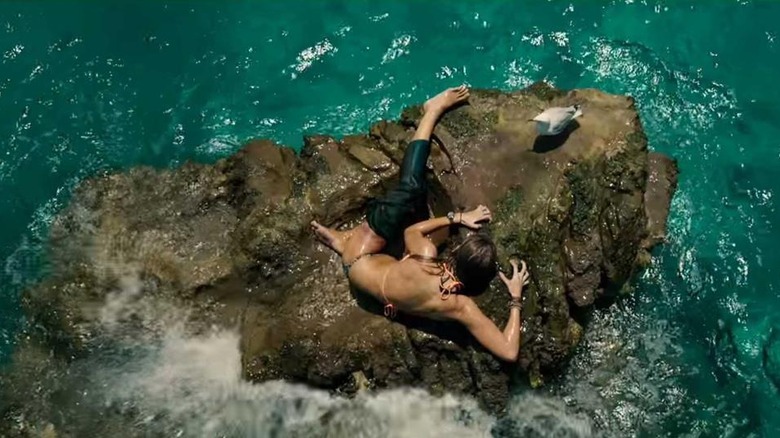
In 2016 horror movie "The Shallows," Blake Lively plays a resourceful surfer named Nancy Adams who has the worst beach trip ever. Not only does she suffer some embarrassing intercultural faux pas, but she also has her sun and surf disrupted by the presence of an almost comically vengeful shark who is hellbent on circling the rock she finds herself marooned on until it can sink its rows of jagged teeth into her.
In the meantime, though, it's happy to chomp on whoever is unlucky enough to venture into the deceptively beautiful waters. While Nancy is resourceful enough to keep herself alive, she's unable to save the two local surfers who unwittingly try to catch some waves. Although she's dehydrated, badly injured, and lacking intermediate Spanish speaking skills, she desperately tries to warn them about the presence of the shark, begging them to turn back to the safety of the shore, screaming "SHARK!" and "GET OUT OF THE WATER." Unfortunately, they don't realize the danger they're in until one of them is already shark food, and the other joins him in the shark's belly soon after. All Nancy can do is behold the horrific scene as their demise bloodies the water. (Deshawn Thomas)
The Big Reveal In The Prestige (2006)
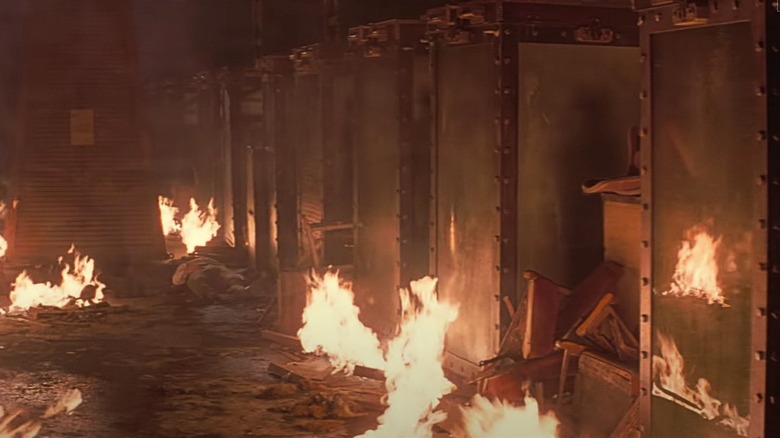
Christopher Nolan will always be remembered for "The Dark Knight," but "The Prestige" may arguably be his finest hour, as the thriller about dueling magicians serves as a masterclass in not just having a big twist ending, but one that truly serves the story.
Hugh Jackman's Robert Angier is so obsessed with besting Christian Bale's Alfred Borden that he goes to extreme lengths to cook up the greatest illusion mankind has ever seen. This involves some forbidden science and, come the end of the film, we learn that this contraption he got from David Bowie's Tesla has actually been cloning Robert every single time the illusion is performed. To avoid having multiple versions of Robert running around, the previous clone is dropped into a tank of water and drowned each time a new one is created. Earlier in the film, Michael Cane's Cutter told Robert that drowning was like "going home," which made Robert feel that this was okay. However, Cutter only told him that in the moment to comfort him. Instead, the Robert clones are put through agony over and over again, all for the sake of an illusion, making the implications of the big reveal utterly disturbing. (Ryan Scott)
Terror On The Ocean Floor In Jaws (1975)
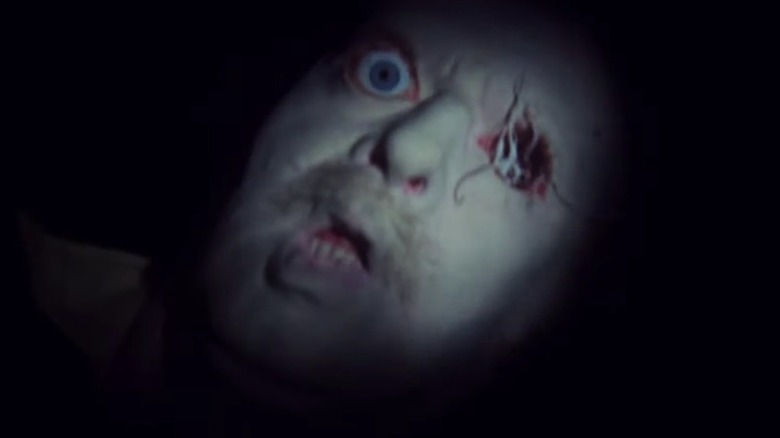
Before the great white shark takes a famous bite out of our heroes and their boat in "Jaws," Hooper (Richard Dreyfuss) and Brody (Roy Scheider) investigate another shark-demolished boat. This one belongs to local fisherman Ben Gardner, whose bloated, freaky corpse Hooper discovers after diving down to the wreckage. The sight of Gardner's floating head, with its mouth gaping and one eye seemingly yanked out by its roots, causes Hooper to scream and drop his flashlight to the ocean floor.
It's an excellent jump scare for audiences, too. The scene works thanks in part to John Williams' famous score, which here is subtle and inquisitive until the big reveal. Not only is poor Gardner's head the stuff of nightmares, but the scene also effectively reminds viewers just how much water can impede a quick getaway. If "Jaws" is a slasher with a shark killer, the chase sequences are all the more frightening thanks to the claustrophobic pull of the underwater setting. (Valerie Ettenhofer)
The Empty Shackle In One Last Dive (2013)
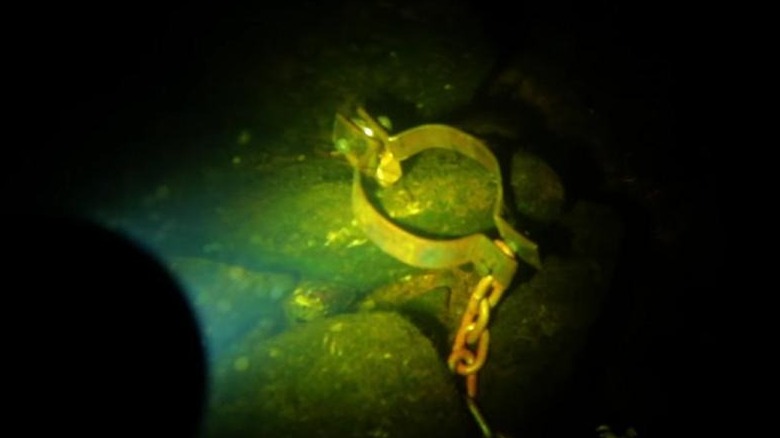
Jason Eisener is one of the most fascinating people working in genre today, known for "Hobo with a Shotgun," "The ABCs of Death" segment "Y is for Youngbuck," the "V/H/S/2" segment "Alien Abduction Slumber Party," the viral Christmas slasher short "Treevenge," and the utterly brilliant Vice series, "Dark Side of the Ring."
As part of the Vice and "The Conjuring" collaboration event, "The 3:07 AM Project," Eisener was selected to contribute a micro horror short, delivering the absolutely terrifying "One Last Dive." In just one minute and nine seconds, Eisener crafts an absolutely perfect jump scare surrounding divers investigating a crime on the water, and pays clear homage to one of the best moments in "Jaws." The short film was so effective there were rumblings of a potential feature, but alas, the project never came to fruition. Fortunately, "One Last Dive" is available for free online for anyone who feels the need to experience the same jolt provided by the lawnmower scene in "Sinister," but underwater. (BJ Colangelo)
Read this next: The Horror Movies We Can't Wait To See In 2022
The post Horrifying Underwater Scenes That'll Make You Swear Off Swimming Forever appeared first on /Film.
Summer Game Fest: Where did all the AAA games go?
It’s a weird year for video games. We’re 19 months into a fresh console cycle and support for the PS4 and Xbox One is finally tapering off as developers shift focus to the PS5, Xbox Series X and PC cloud gaming platforms. The pandemic slowed or paused development on a generation of games, and studios of all sizes are being absorbed by the biggest names in the room. The industry is in flux and the rest of the year reflects this instability. Put simply, there aren’t a lot of huge games coming out in the second half of 2022.
Right now, the video game space is made up of delays, big promises and more delays. That doesn’t mean there’s nothing to look forward to — between indie and AA developers, cloud libraries and mobile games from Netflix of all companies, this period of transition will still be packed with plenty of things to play.
The 2022 holiday release calendar definitely looks thinner than it did a few months ago, but the first half of the year was fairly busy with games like Horizon Forbidden West, Elden Ring, Pokemon Legends: Arceus, Gran Turismo 7, Kirby and the Forgotten Land and Tiny Tina’s Wonderlands. And those are just the well-funded releases with big, shiny ads — the year has also been good for indie and AA titles like Neon White, The Quarry, The Stanley Parable: Ultra Deluxe, Sifu, Tunic, OlliOlli World and Salt and Sacrifice already available. The summer’s peppered with even more small but fantastic-looking games, like the cyberpunk cat simulator Stray, Sam Barlow’s Immortality and the wildly anticipated Cuphead DLC, all due out by the end of July.
Weirdly enough, Netflix is also helping to fill in the gaps with a new push into mobile gaming, and its latest titles are a treat. Poinpy, the new game from the creator of Downwell, is particularly addictive. Netflix is also publishing the next titles from the studios behind Monument Valley and Alto’s Odyssey, and all of them are free, without ads or microtransactions, as long as you have an active Netflix subscription.
On top of all that, mid-tier publishers like Devolver and Annapurna have a steady stream of strange, high-quality games coming out at all times. And, of course, there’s Xbox Game Pass, PlayStation Plus Premium, NVIDIA’s GeForce Now and even Google Stadia — cloud-gaming services that bring hundreds of classic and new titles to essentially any device with a screen.
So, yeah, there are plenty of fresh games heading our way this year; it’s just that there won’t be many AAA blockbusters out of Microsoft or Sony. Whether we like it or not, these studios set the pace of the industry, and gaps in their release schedules can make it feel like development has stagnated across the board. And right now, there are a lot of AAA gaps. What makes it worse is the fact that Microsoft and Sony have announced and then abandoned multiple huge projects over the past few years, giving all of us something concrete to miss in every showcase.
In late 2019 and 2020, Microsoft announced massive games including Fable, Senua’s Saga: Hellblade 2, Everwild, Avowed and Outer Worlds 2, and it hasn’t said much more about these projects since. On top of that, there’s everything going on at Bethesda, the largest brand under the Xbox Game Studios banner. Bethesda’s shiny new sci-fi RPG, Starfield, was delayed out of 2022 earlier this year alongside Arkane’s online vampire shooter, Redfall. Meanwhile, it looks like Elder Scrolls 6 has at least five more years left in development, and Fallout 5 may not come out until the next console generation. The biggest Xbox exclusives still landing this year are High on Life, As Dusk Falls and Pentiment, three mid-sized games, two of which were literally announced this month.
Sony is in a similar situation. It has more AAA exclusives hitting the market in the second half of this year than Microsoft, with Forspoken, God of War Ragnarok and The Last of Us remake on the calendar, but there are still plenty of unknowns in the PlayStation lineup. Final Fantasy XVI was a highlight of the PS5 announcement stream in 2020, but we just got a release window of summer 2023 for that one. There’s been zero to little information about other games Sony’s had in the works for years, including Wolverine, the Knights of the Old Republic remake and Spider-Man 2. A standalone multiplayer mode for The Last of Us is still MIA, and we’ve yet to get details on the “multiple game projects” that Naughty Dog is also working on.
There are a couple of big cross-platform games due to come out this holiday season, including Hogwarts Legacy and The Callisto Protocol, but fanfare for these titles has been fairly muted so far.
As for Nintendo, it’s playing by its own rules, as always, and it has Splatoon 3 and Pokemon Scarlet and Violet on the roster this year, plus whatever it announces during its next Direct showcase. It has its own troubles of course — Breath of the Wild 2 was pushed back to 2023, and then there’s Metroid Prime 4, which was announced in 2017 and… yeah.
The sense of insufficiency in the industry this year is the result of the console makers announcing things too early, with too much fanfare and too many impossible release windows. Of course the pandemic didn’t help, but as it stands, these studios promised the world and then went quiet on multiple massive franchises, and the silence is particularly deafening as we enter an anemic six months of AAA releases. Thankfully, there are so many amazing indie games available right now and coming later in 2022, and between cloud, mobile and PC services, there are more ways to play these titles than ever.
As Jonathan Blow would say, time is a construct anyway, and thinking of life in terms of weeks, months and years is a futile effort to logically contain chaos. Long story short, there’s a lot to look forward to in the video game universe. It may not all be coming this year — or the next, or the next — but with more games to play on more platforms than ever, we should all be plenty entertained.
US Probes How American Electronics Wound Up in Russian Military Equipment in Ukraine
Read more of this story at Slashdot.
Weird West Review

Introduction
You may know Raphaël Colantonio as the founder of Arkane Studios, the team behind such titles as Arx Fatalis, Dark Messiah of Might and Magic, Dishonored, and Prey. However, over the past few years, he's been busy getting Wolfeye Studios off the ground. The goal there was to have a smaller indie team that traded Arkane's publisher-supported budgets for some extra creative freedom.
This endeavor has resulted in Weird West - a gunslinging isometric immersive sim. And having played through Wolfeye Studios' debut project, we now bring you our thoughts on it.
Multiple Personality Dishonor
First things first, we have to figure out what an immersive sim even is. It's a terrible name, for starters. Games classified as such are not true simulators, and neither are they a part of The Sims franchise. And immersion is just a nebulous buzzword that doesn't really mean anything.
But if you don't get too stuck on the literal meaning of the words, you'll understand that when someone calls a game an immersive sim, they actually mean a stealth game with a progression system where you have multiple ways to tackle just about any challenge and an option to eschew subtlety in favor of a brute-force approach. A game that is somewhat similar to Deus Ex would be another way to describe immersive sims.
Weird West then is one of those. At the same time, Weird West is also a literary subgenre that combines a Western setting with some supernatural or occult elements prevalent in the so-called Weird fiction. In other words, if H. P. Lovecraft were to write a script for a Clint Eastwood movie, that would be an example of Weird West the genre.
Weird West the game, as you may have already guessed, uses that particular subgenre for its setting. You get a world where an expansive frontier of plains, bogs, steppes, and deserts is dotted with tiny settlements, mines, ghost towns, and haciendas. And in that world, you have farmers growing crops, prospectors lusting for gold, outlaws causing trouble and bounty hunters chasing said outlaws.
But underneath the surface, you also have ghosts haunting their graves, werewolves howling in the night, shapeshifting monsters running slaver gangs, and strange cultists prophesizing doom and despair.
As you play Weird West, you'll get an opportunity to explore this world as five different characters. You will start your journey as a bounty hunter on a quest for revenge. Then, you'll play as a cursed pigman, a demon-hunting native, a god-fearing werewolf, and a witch who can see the future.
These characters all come with their personal stories and an overarching thread that connects them in some way. While playing as any one of these characters, you'll be able to tackle all the optional content you wish. You'll get to take on side quests, bring outlaws to justice, rob banks, hunt bears, explore ghost towns, and so on. But once you're done with a character's main story, you will have to switch.
And while these characters and their stories are pretty good overall, I see this general structure as one of the game's biggest failings. In a game like Weird West, chances are you want to play as either The Good, The Bad, or The Ugly. You know, the classic Western archetypes. And seeing how it's a game with a great degree of freedom, let's face it, it's probably The Ugly, an unabashed agent of chaos. Not being able to create your own character here is a great shame.
This character-hopping thing also ties into the game's progression system. Your characters in Weird West have Perks and Abilities. You unlock them by finding special items while exploring the world. The caveat here is that Perks unlock new stuff for all your characters, while Abilities only upgrade your current one.
Perks range in usefulness between some handy unlocks, like being able to jump higher, sneak faster or deal more damage to unaware targets, and the significantly less impressive percentile increases to your HP or shop prices. Abilities are split between weapon abilities which all characters get, and a special tree unique to each character. These too vary greatly in their usefulness.
To take things one step further, all the upgrade items you pick up but don't immediately use will be transferred over to the next character once you recruit your old character as a companion. This creates a situation where you don't actually want to upgrade your current character, and instead want to hoard all the upgrade items. To make matters worse, your third character unlocks the ability to converse with ghosts, while the final one lets you decipher ancient texts, further incentivizing you to treat your earlier heroes as disposable.
And to complicate things even more, all your characters share their saddlebags and safety deposit boxes, but you can't transfer your actual savings between characters. This results in a rather tedious song and dance where before wrapping things up with a character you have to turn your dollars into gold bars, stash them away, and decide which consumables and items you need to finish your journey, and which you'd rather leave to your next hero.
Once you actually start that new journey, you have to first find a town with a bank, then find a town with a stable, then find one of your old characters and hire them to get all the upgrade items back. And you have to do this four times.
But at the very least, this approach allowed the developers to introduce a great deal of reactivity. During your journeys, you'll be making plenty of decisions that will affect the world around you on both a major and minor scale. You'll get plenty of opportunities to dismantle or prop up entire factions, save or destroy various settlements, and in the end, decide whether to save or destroy the world.
And on a more personal level, you'll be making friends and enemies. The former will aid you in combat, while the latter will be sending their goons after you. There's even a pared-down take on the Nemesis System from Middle-earth: Shadow of Mordor.
For example, during my pigman journey, I ended up turning the witch that cursed him into a pig herself. Then, on a later journey, I apprehended her for a bounty, as the pig version of her was now an outlaw. And finally, when visiting the pigman at some point, I had to put her down, as she had apparently escaped and together with her gang, was now attempting to take her frustrations out on the town the pigman was living in.
So in the end, despite some reservations about the game's approach to storytelling, the abovementioned busywork didn't stop me from enjoying Weird West overall.
Twin-stick Six-shooter
Now, usually, immersive sims tend to favor the first-person perspective. Weird West, however, adopts an isometric approach. Here, you'll be looking at your character from up high while using your mouse to control the camera and aim, and WASD to move. Alternatively, you can use a gamepad.
The fact that most immersive sims aren't isometric should've been the first warning sign here. No matter how you look at them, the game's controls are extremely clunky. All the menus seem to have been designed with a controller in mind, making them needlessly annoying to navigate.
Everyone's favorite "press button to do one thing, hold it to do another" feature is a big offender there. Having the cursor completely disappear on you whenever you're not holding the right mouse button (it's what you have to do to pull out your gun and start aiming), is a close second though. Inventory management could also use some drag and drop functionality.
In combat, this clunkiness translates into you having to constantly hold and release the right mouse button to either aim your gun or adjust your camera. You can't do both at once. And should you decide to use a controller, you'll come face to face with the fact that while all the menus were designed for it, due to the game's overall pace and the general scale of the objects you'll be aiming at, trying to use a controller during a fight makes the game borderline unplayable.
But even when you're using a mouse, the game simply moves too fast. The developers actually went all out here and included a lot of systems that can interact with one another. You can set fire to oil puddles and you can then douse said fire with water. Wind can blow flames onto nearby wooden structures. You can get hit by lightning thanks to a dynamic weather system. You can break enemy morale by killing their leaders. You can kick people off ledges, attract their attention by making noise, and set up elaborate traps.
Unfortunately, since things go down way too fast once bullets start flying, you won't get a lot of opportunities to utilize any of this to your advantage. Without fail, every time it's easier and more effective to sneak behind enemies and knock them out, or just shoot them dead if you get caught.
And if you do decide to get all fancy with it, chances are you'll end up being disappointed. Let's say you spend five minutes sneaking around and setting up an oil puddle for your enemies to walk into. Then you set the thing ablaze. Your enemies take around 5 damage each, roll out of the fire and start shooting, alerting the entire dungeon to your presence.
This is especially noticeable early on when you have bad guns and under-leveled abilities, which results in hilarious moments like your silent takedown skill not being able to actually kill your target in one shot, or when you have to shoot an explosive barrel several times before it explodes.
Now, while the game's combat is highly clunky, that doesn’t make it difficult. I was playing on the third out of the game's four difficulties and never felt like things were particularly challenging, aside from the times I had to deal with the crazed miners who like to throw dynamite at you. The idea there is to shoot the dynamite before it reaches you, but those sticks are like 2 pixels wide, while the miners have way too much health and chuck the things like there's no tomorrow. Those encounters were pretty tough.
Thankfully, this being an immersive sim, you don't have to engage in combat all that often. Usually, you can just sneak around your enemies or knock them out. This approach makes things significantly more enjoyable.
Either way, the gear you'll have at our disposal includes several weapon types - melee weapons, pistols, shotguns, rifles, and bows. You will also have access to a number of consumable potions and throwable explosives, as well as an armored jacket and two talismans that usually make your character better under certain conditions, like doing more damage if your reputation is high enough.
Your gear comes in several tiers and variations. For example, you have a choice between a slower and stronger rifle or one that's a bit weaker but shoots faster, and these can range from the common greys to the legendary oranges.
If you're looking to upgrade a particular gun (or a suit of armor), you can utilize the game's crafting system and exchange several ore nuggets or animal pelts for an extra tier of quality. But unless I was doing something very wrong, usually, you'll be able to find plenty of high-tier gear way before you'll get a chance to collect the necessary upgrade materials, making the whole thing redundant.
I guess it's just another extension of the game having way too many systems for its own good. In fact, the game even has a system where NPCs can remarry should their spouse perish at some point. But seeing how Weird West doesn't really have any memorable characters outside the main quest, its side-quests tend to be of the fetch variety, and its dialogue system is extremely basic, chances are you won't remember any of the NPCs you meet, at least not well enough to notice their last name changing.
In general, the game presents you with an abundance of points of interest, but they're just not all that interesting. Once you've managed to build a nest egg with your very first character, you don't need much else. The loot you find is mostly junk, and you can get all the leveling items you need during story-related missions.
And if you do decide to go out and explore, after a while you'll realize that all the mines and settlements and farms here look pretty much the same, like the settlers brought along some prefabs on their journey West.
At times it feels like Weird West doesn't know what it wants to be - a hand-crafted story-driven game, or a procedurally-generated one. And for an immersive sim, a genre with its roots in the likes of System Shock and Deus Ex, the choice should be an obvious one.
In an immersive sim, you want to see elaborate sprawling levels that give the game's systems enough room to breathe. You want these levels to be populated with memorable characters and encounters, easy to miss nooks and side passages. You want Liberty Island, not a handful of shacks in a desert.
Technical Information
For a game with so many systems, Weird West is surprisingly stable. It runs well, doesn't chug too hard, and I haven't encountered any major bugs or issues. On rare occasions, I wasn't able to knock out certain NPCs (that otherwise should've been susceptible to it), and a few times I was detected seemingly through a wall. But a reload sorted those out.
Speaking of reloads. The game has several rotating autosave slots, quick saves, and manual saves. The caveat there is that reloading the game world can lead to some unexpected consequences like enemies suddenly being reshuffled on the map. But while annoying, I just treated that as an incentive to not get caught.
The game's visuals are neat for an isometric title, but once again it suffers from its choice of perspective. There's plenty of stuff in the world you can pick up or interact with, but looking at it from a distance, it's all too small. And as far as I'm aware, there isn't a button that highlights interactable objects.
The sound design is also quite good, even if the game's soundtrack isn't overly varied. And while we get plenty of voice-acted narration during the story sections, the rest of the game isn't voice-acted, allowing you to read things at your own pace.
One last thing to mention here is that when you launch the game for the first time, it just starts. You don't get a chance to tinker with the options menu and instead get the opening cutscene straight away. I really don't like it when games do this.
Conclusion
While Weird West can't hold a candle to the likes of Deus Ex, and it sure does have plenty of questionable design decisions, at the end of the day, the immersive sim market is not exactly oversaturated. And with that in mind, I did enjoy my time with the game. It may not be great, but it's still a perfectly decent way to spend 20-40 hours of your time.
NWN - Interview @ Techradar
Seamless Starfield spaceflight is important to me, Todd Howard
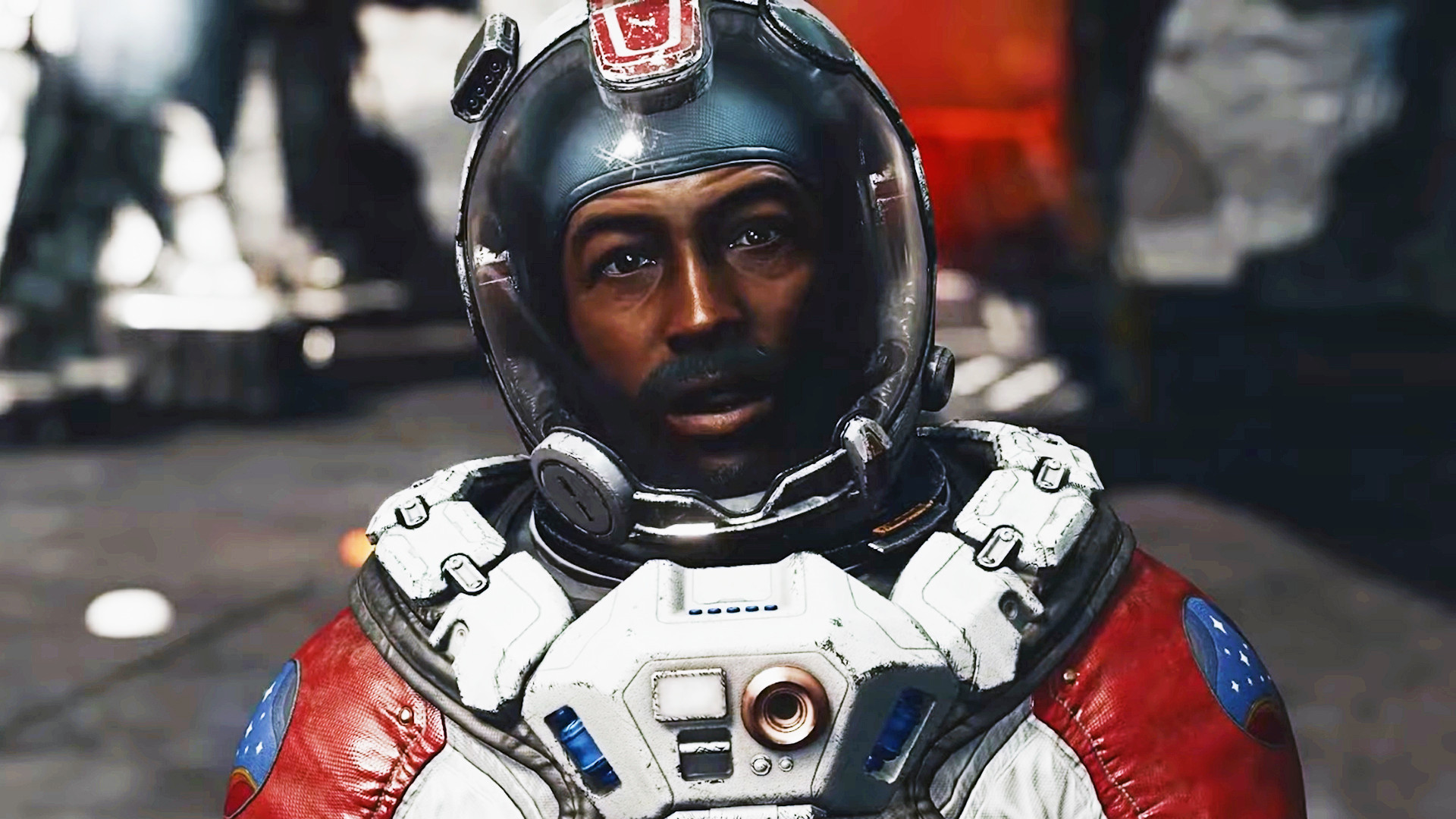
Bethesda’s open-world games offer some of the best examples of freedom in gaming. They're true sandbox game experiences, so Starfield had me very excited - until studio head Todd Howard confirmed that there is no seamless space travel from planets to space.
Basically, this means that you cannot get in your ship and fly it from a planet’s surface directly to outer space and then go back down again. Instead, you get in your ship, presumably get a short cutscene of taking off, but don’t have control over it until the ship is out in space. While you seemingly can land anywhere, it’s just a matter of approaching the planet and selecting a point on a map - like fast travel.
"People have asked, 'can you fly the ships straight down to the planet?' No,” Todd Howard confirms, without ambiguity. “The on-surface is one reality, and when you're in space, it's another reality.” As for why Bethesda decided not to allow players to seamlessly fly ships between space and planet surfaces, Howard says the team didn’t want to spend time developing something “that's not that important to the player.”
RELATED LINKS: Starfield release date, Starfield ship design, Starfield Game PassCrypto Fraud is Growing Exponentially
Read more of this story at Slashdot.
Rebel FM Episode 544 - 06/17/2022
Zelda: Breath of the Wild gets a brand new DLC-sized Expansion Mod
In March 2021, we shared one of the first DLC-sized fan expansions for Zelda: Breath of the Wild. And today, we are presenting you another huge fan expansion mod for this latest Zelda game, called Doors of Doom. The good news here is that this DLC-sized expansion is playable on PC via Nintendo WiiU and … Continue reading Zelda: Breath of the Wild gets a brand new DLC-sized Expansion Mod →
The post Zelda: Breath of the Wild gets a brand new DLC-sized Expansion Mod appeared first on DSOGaming.







